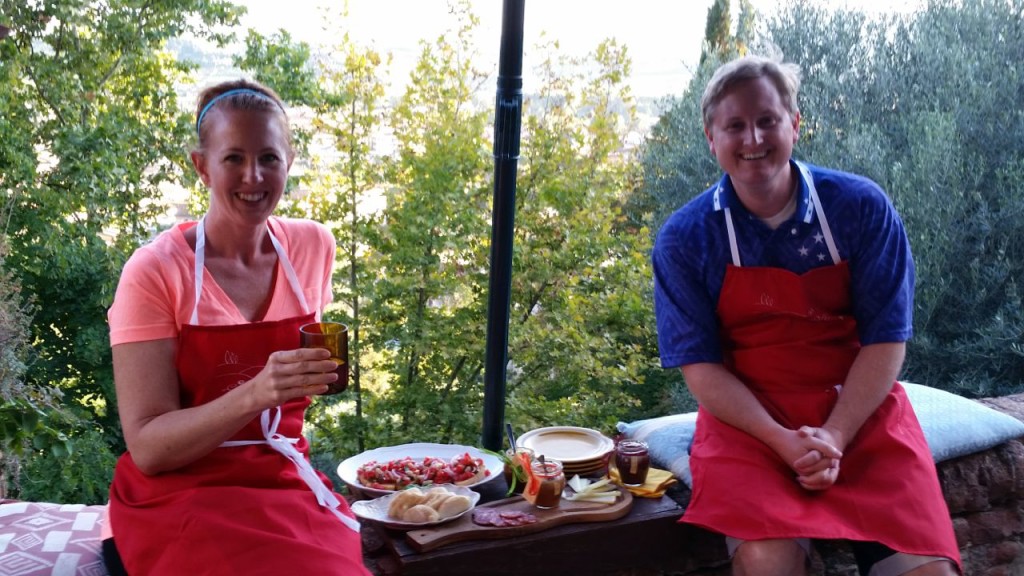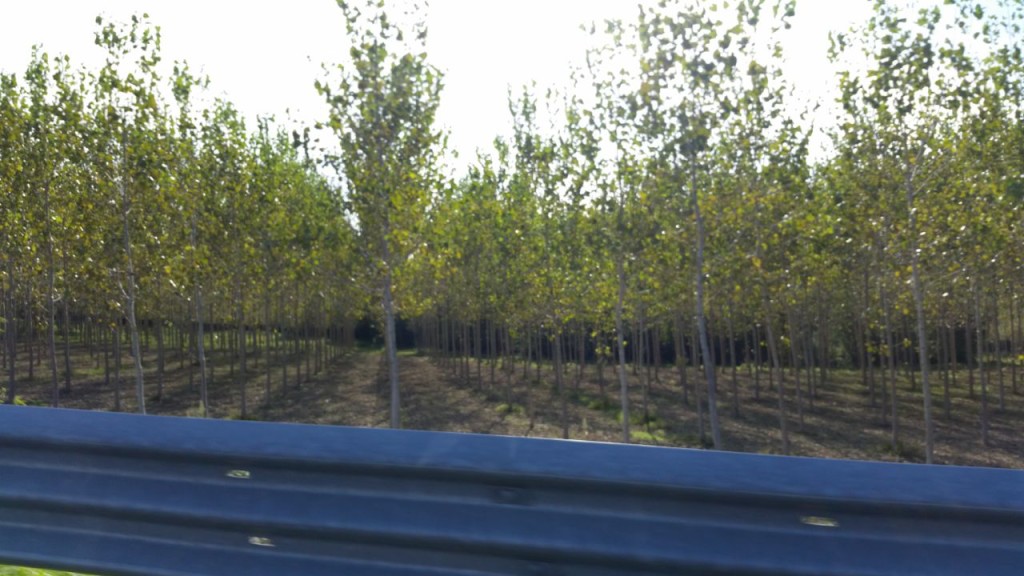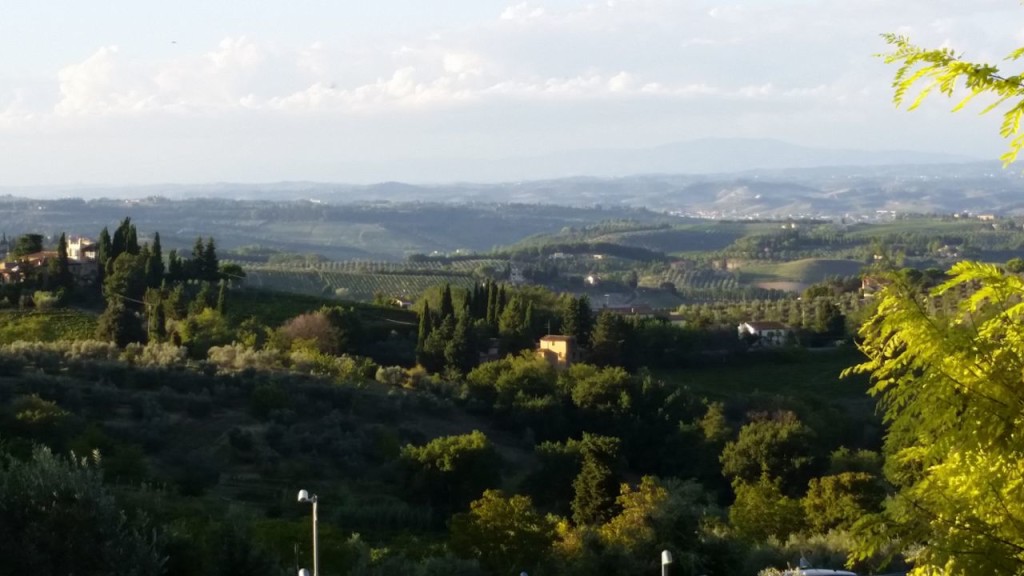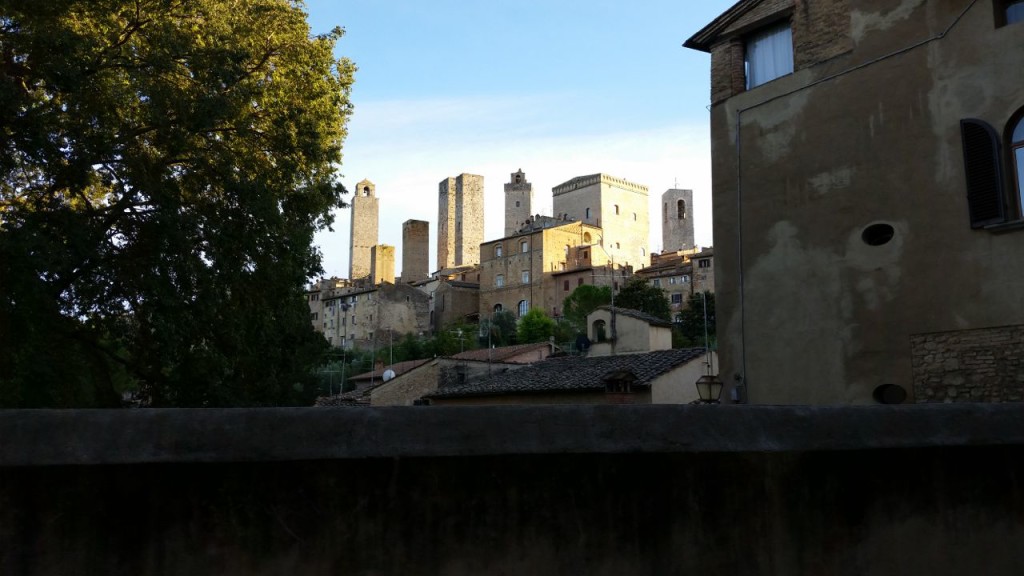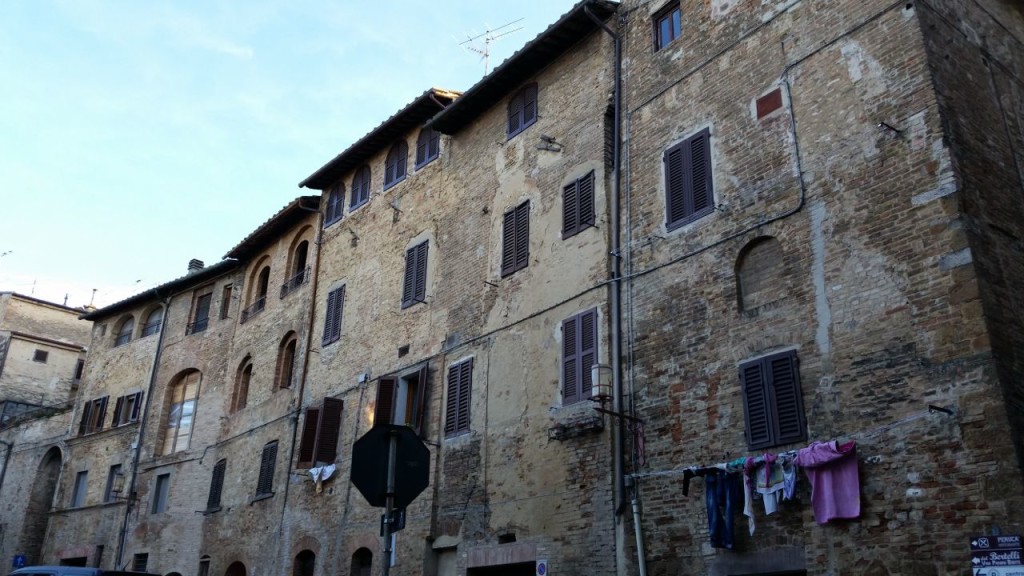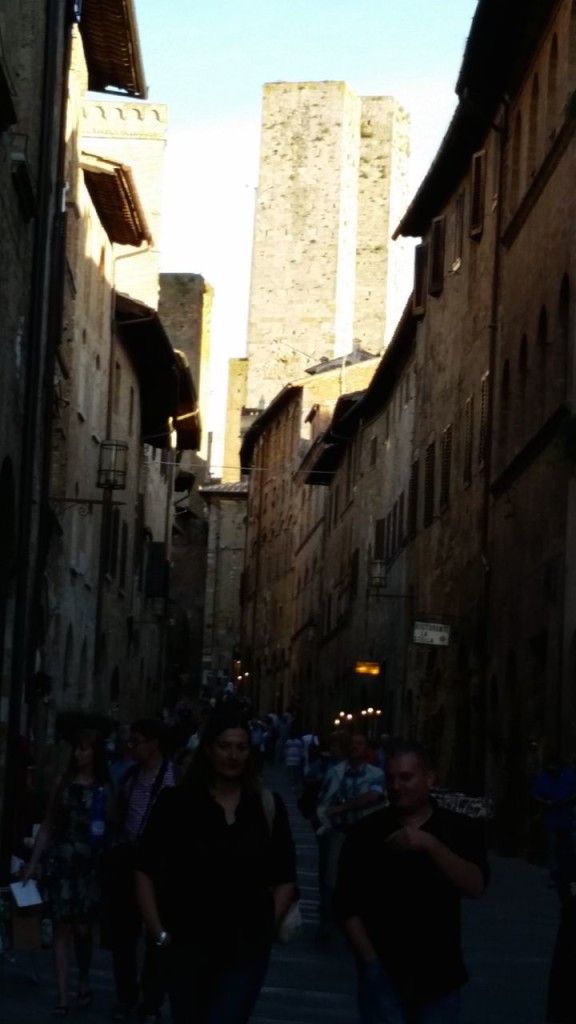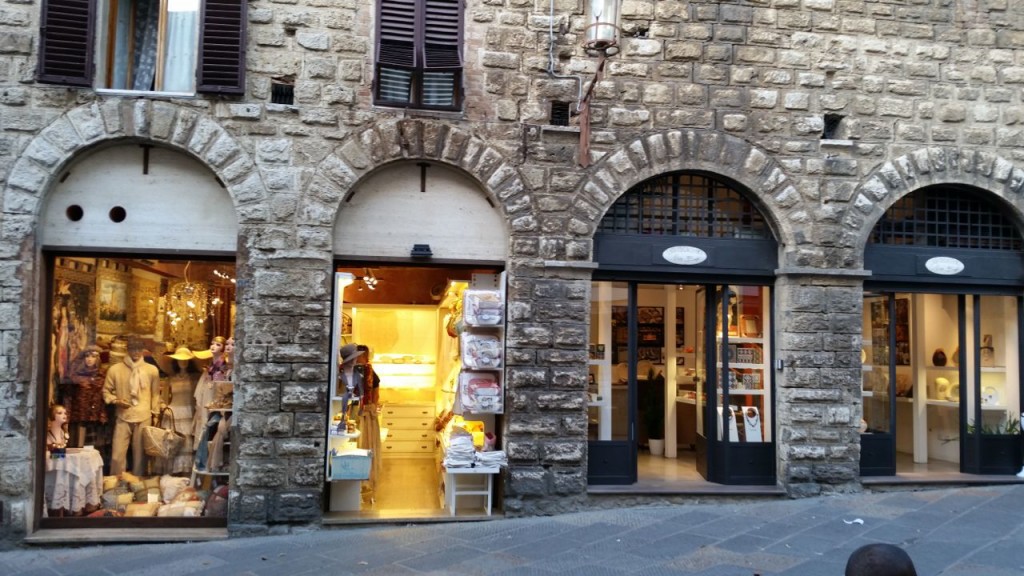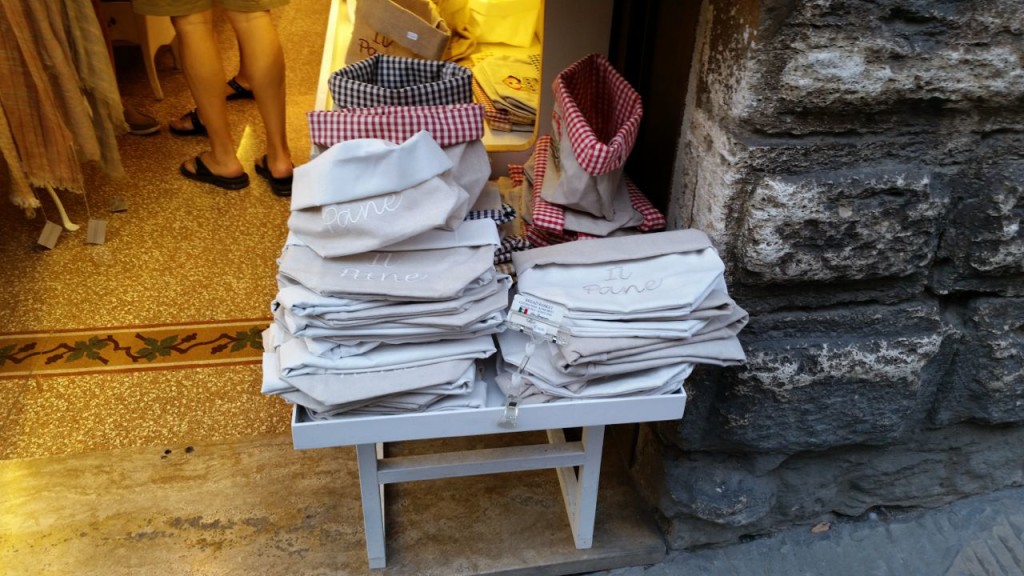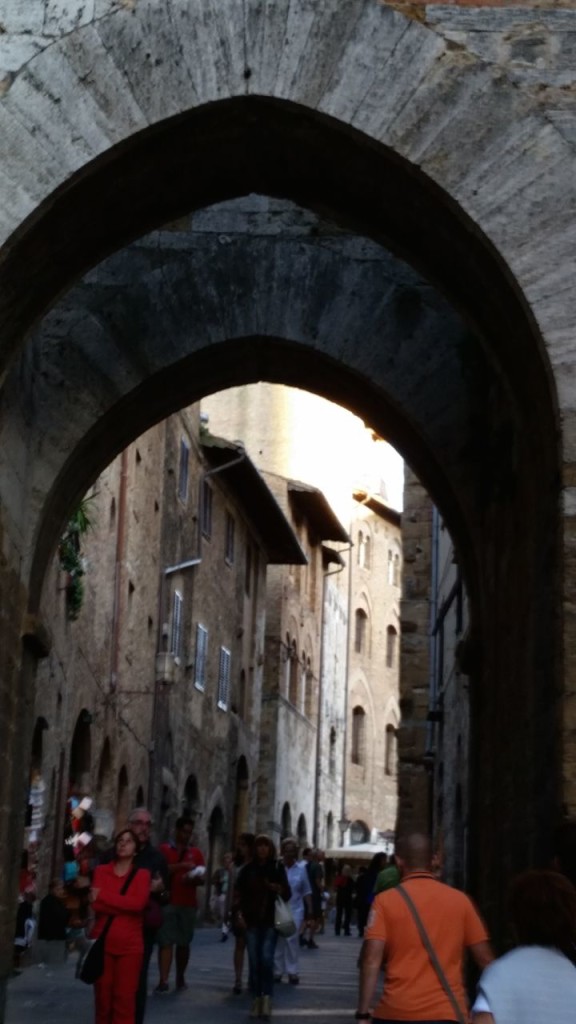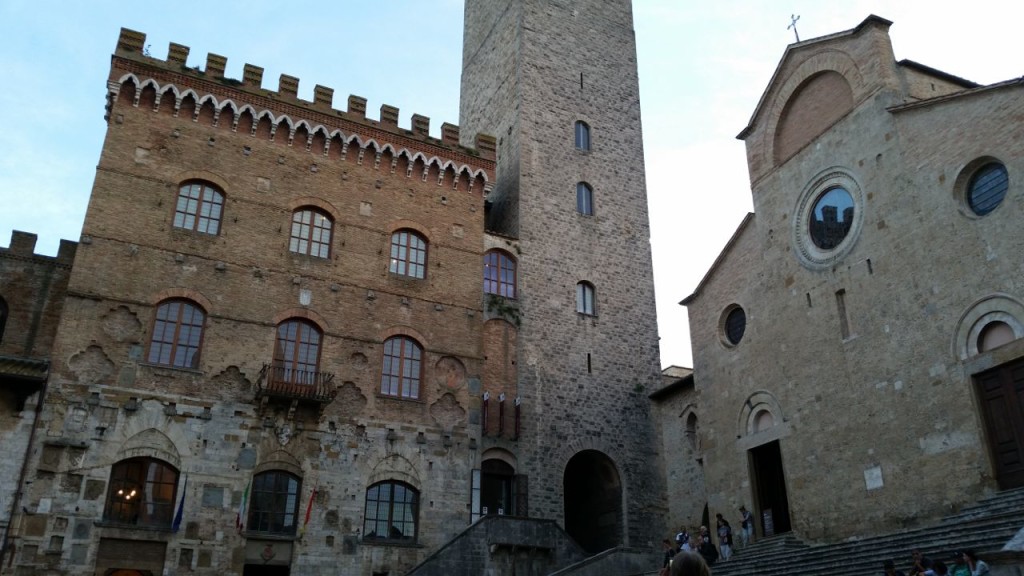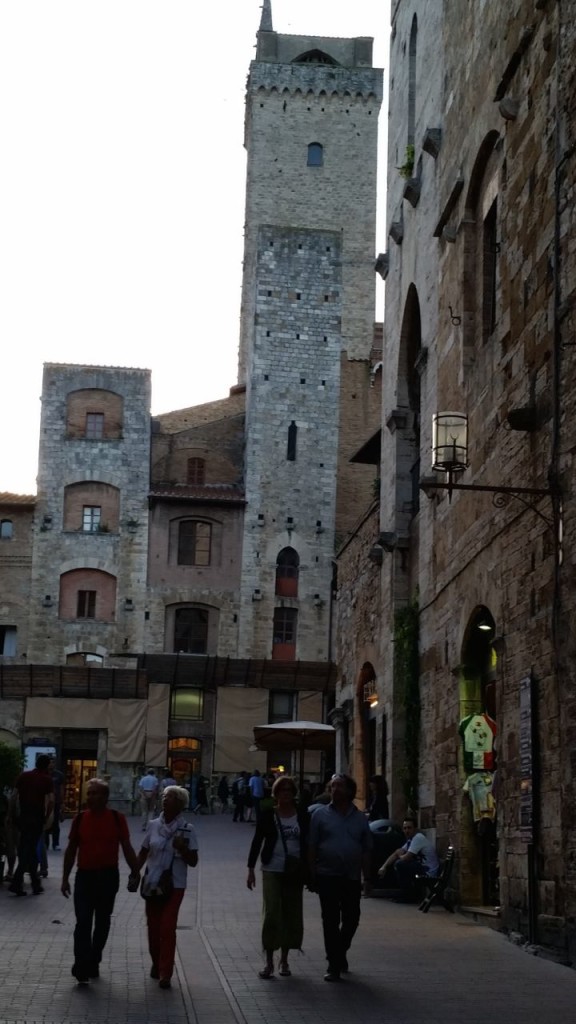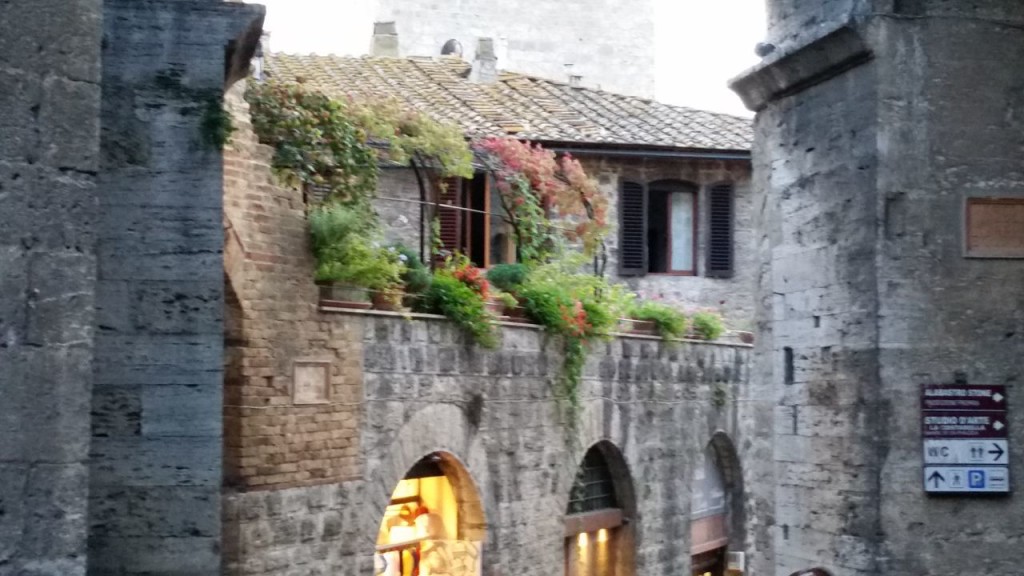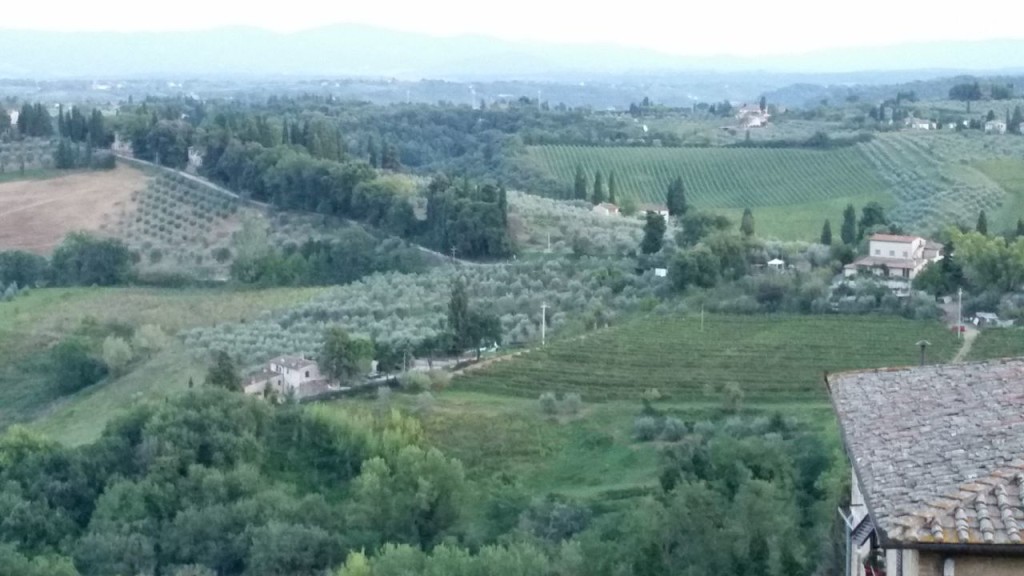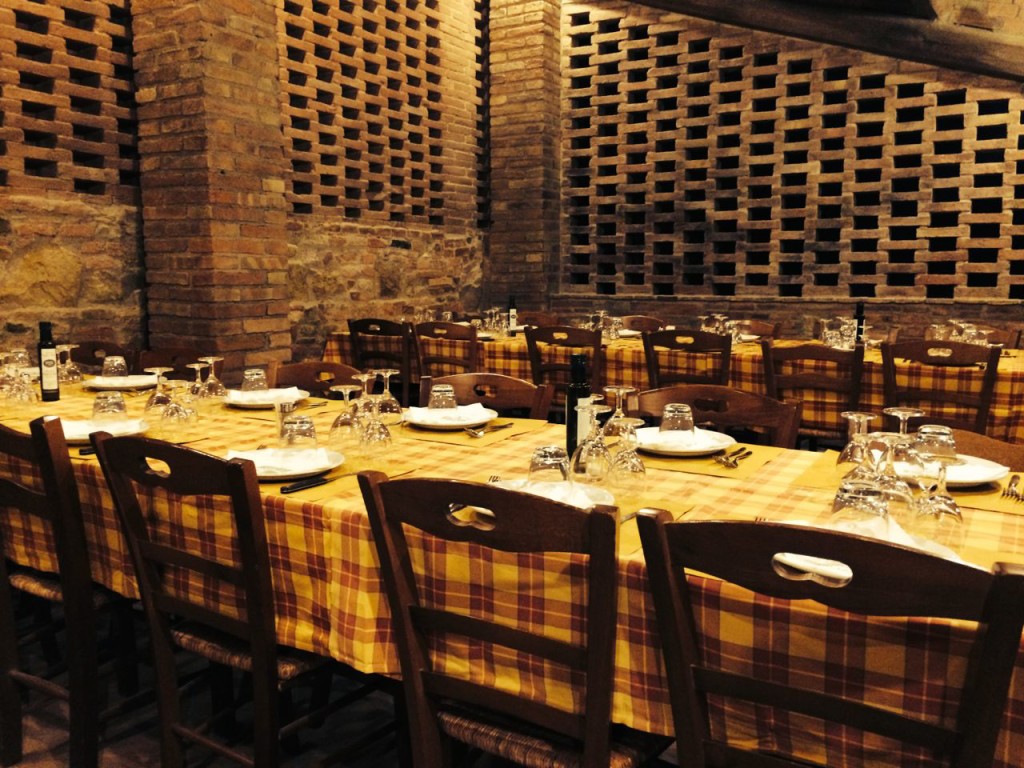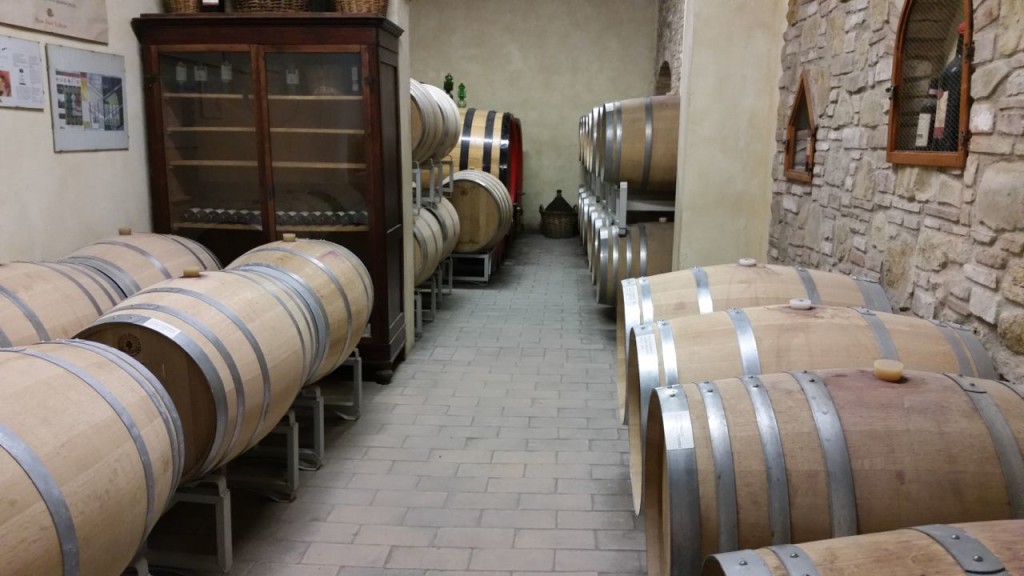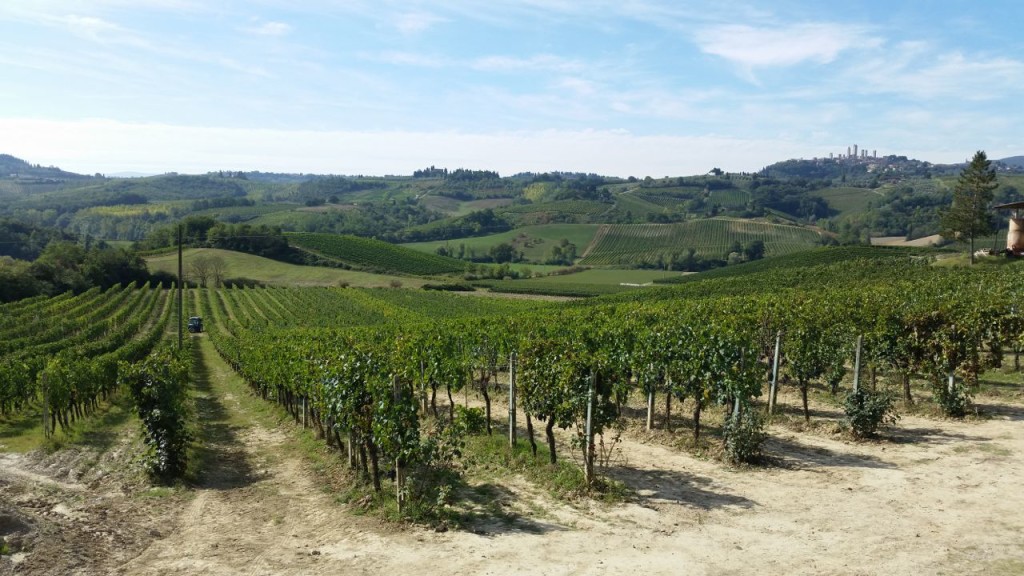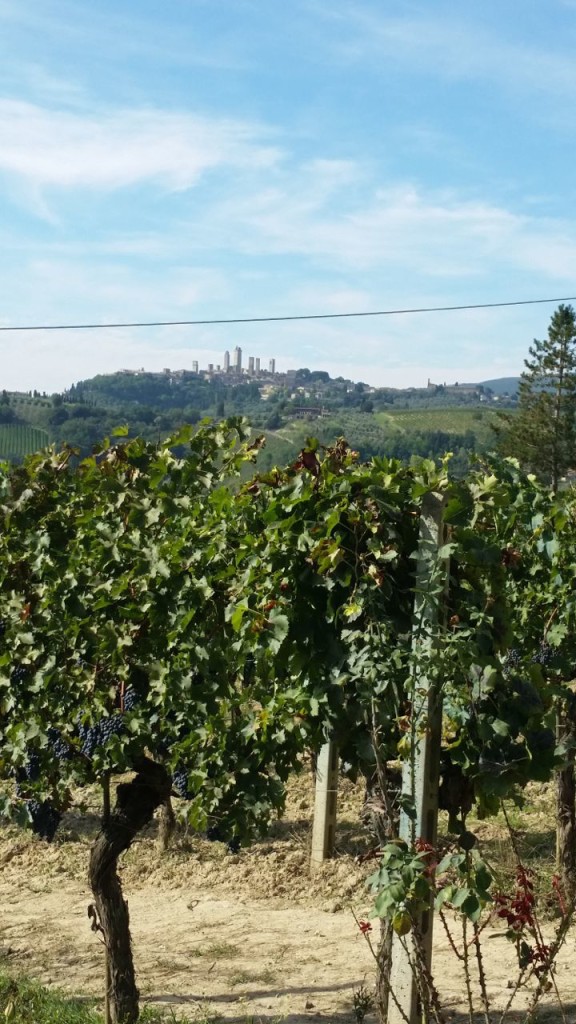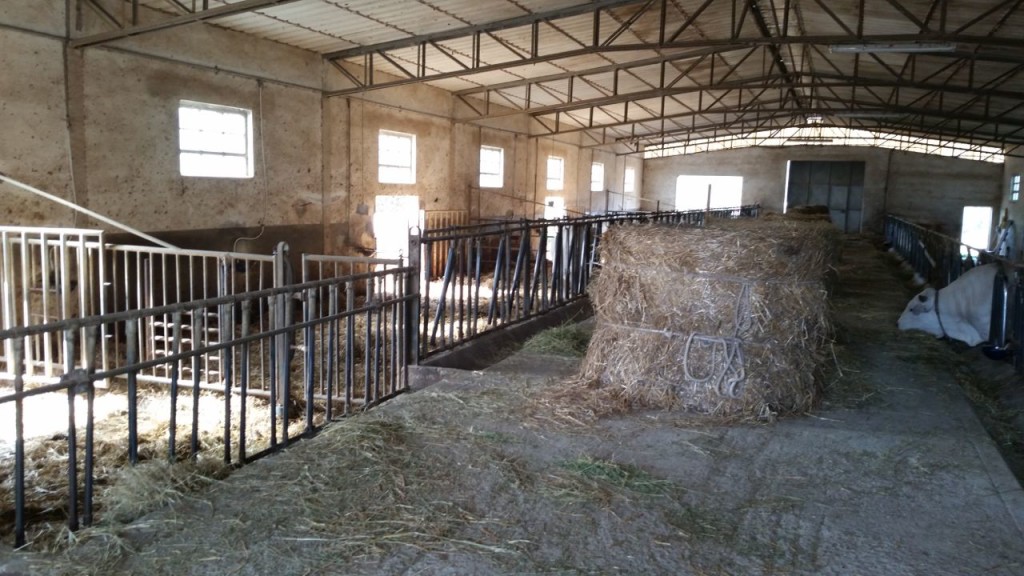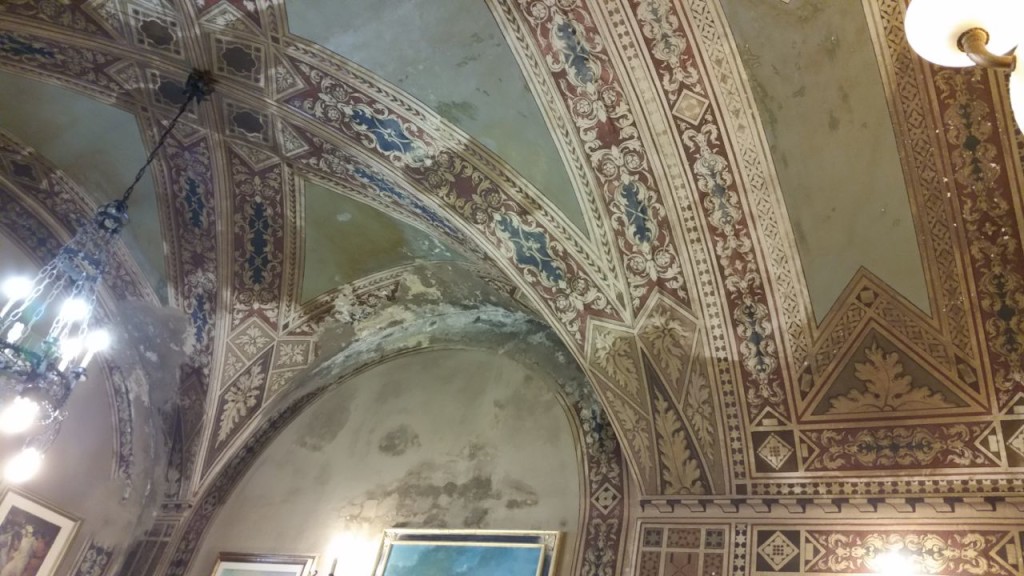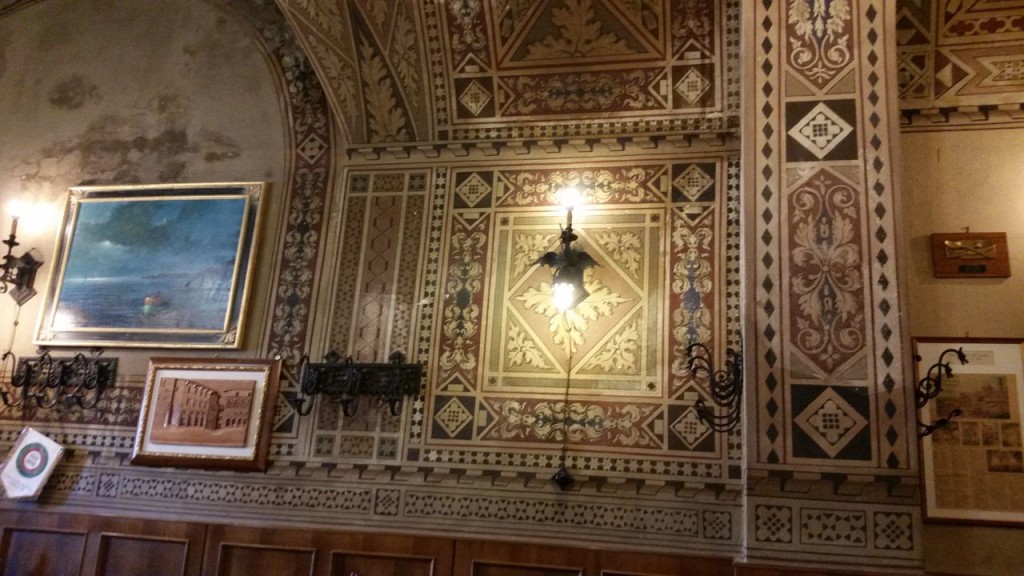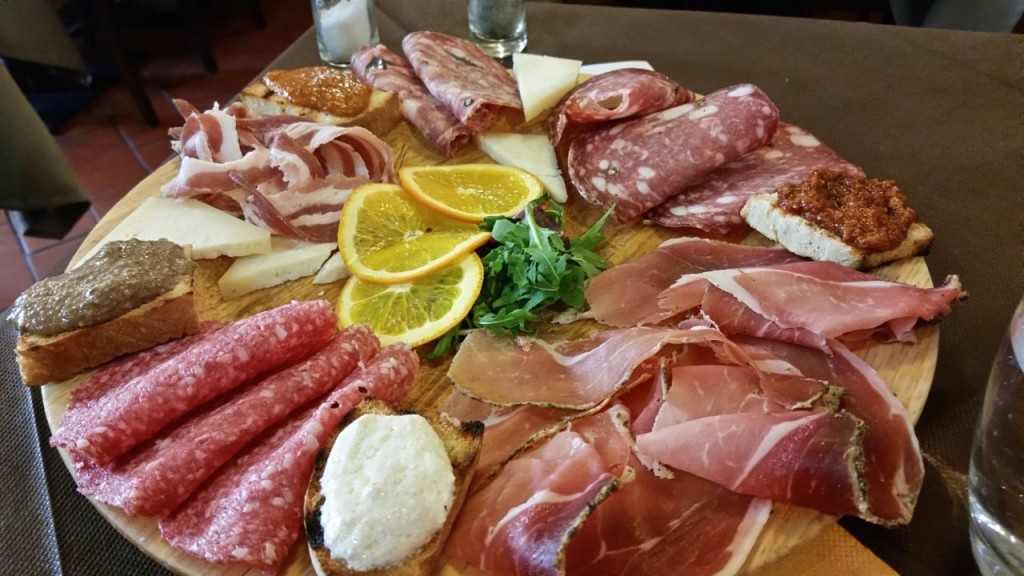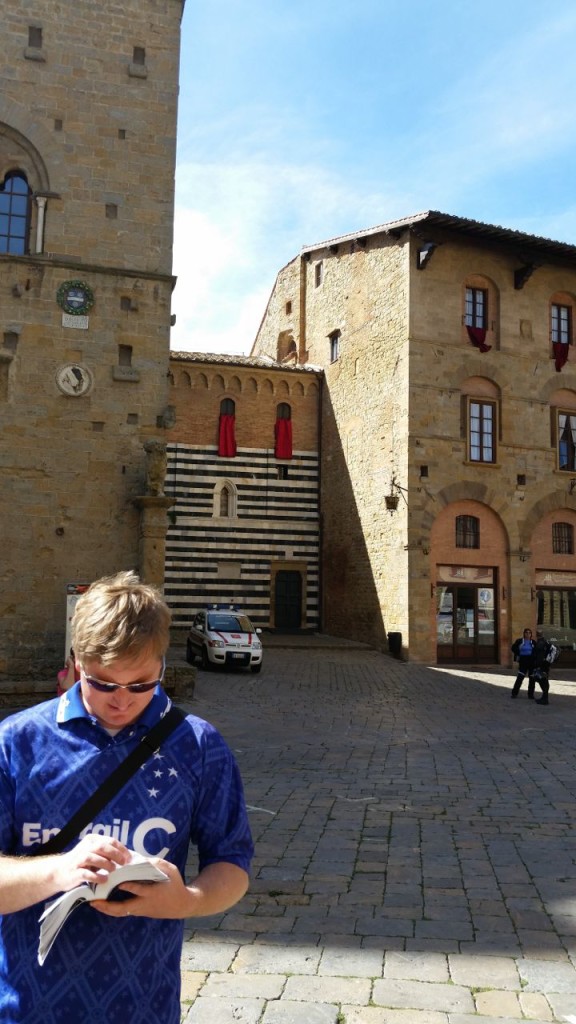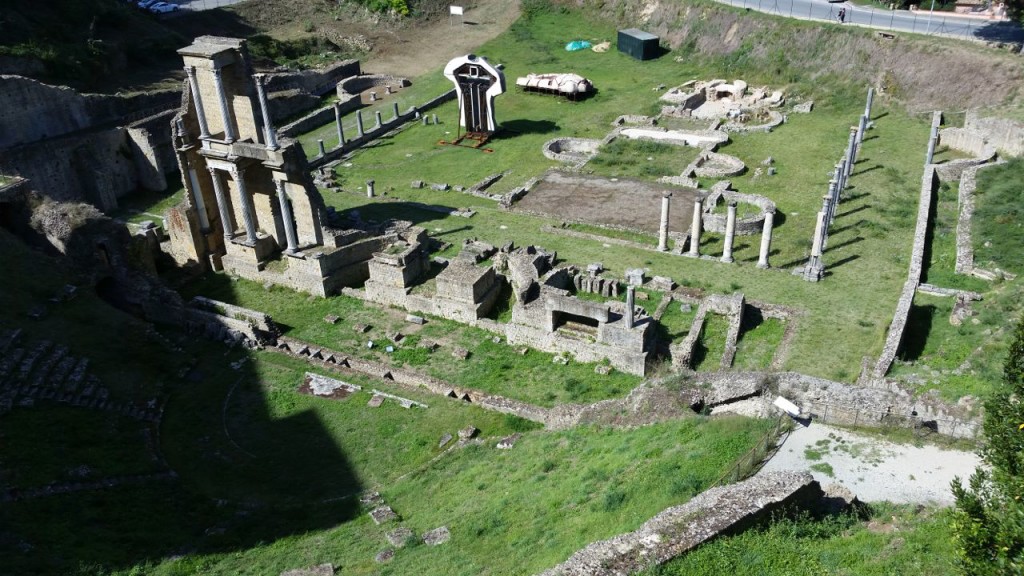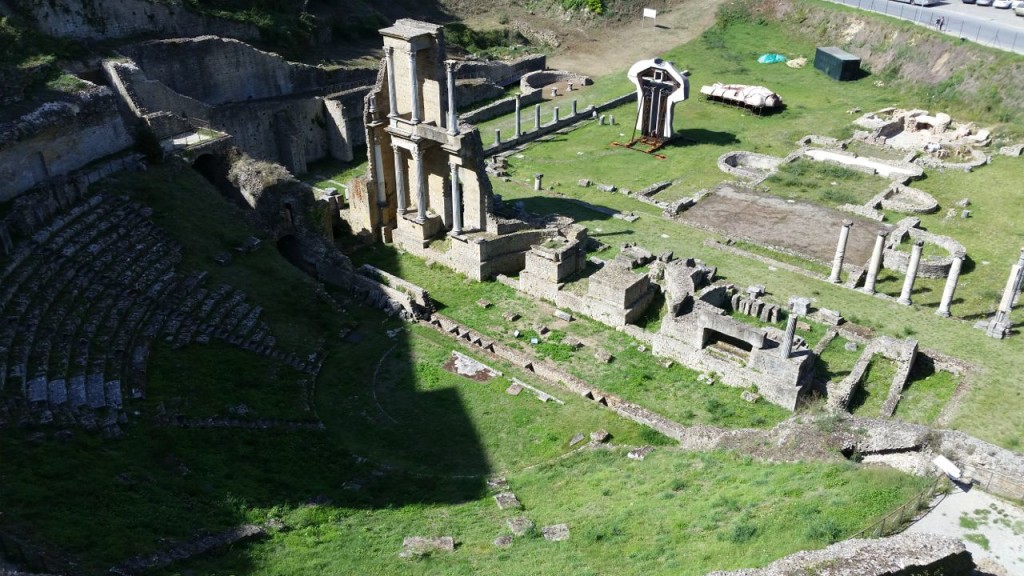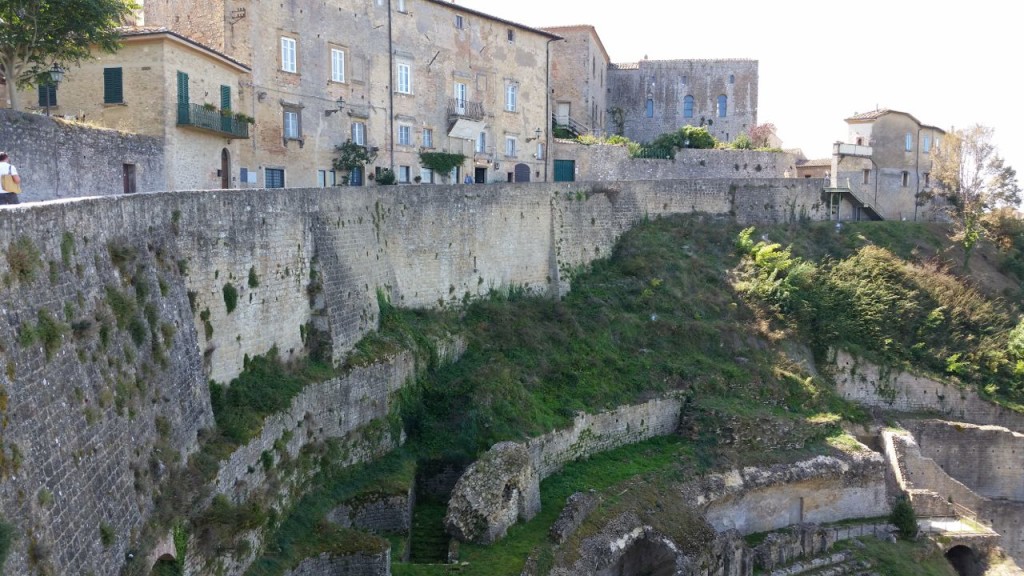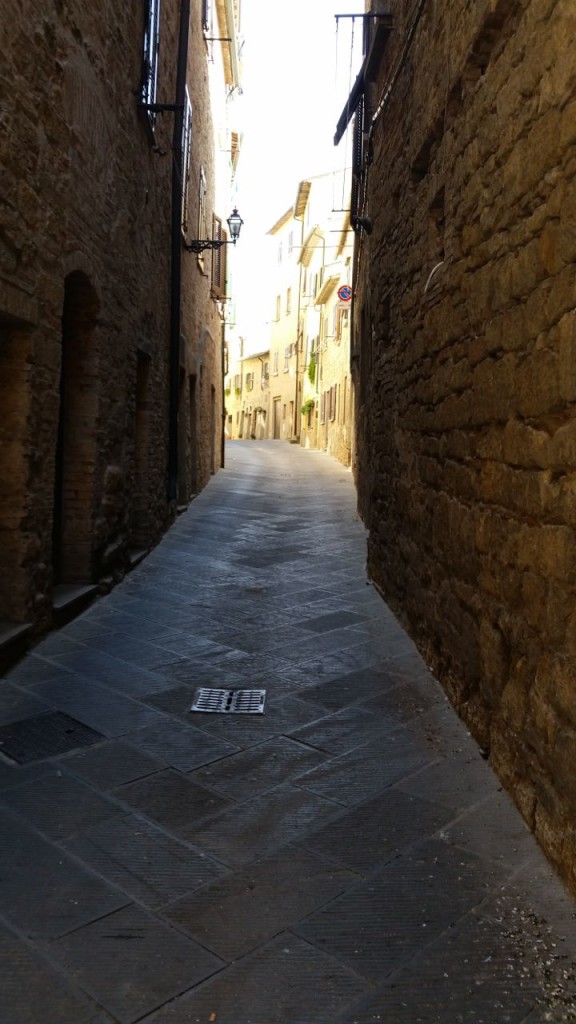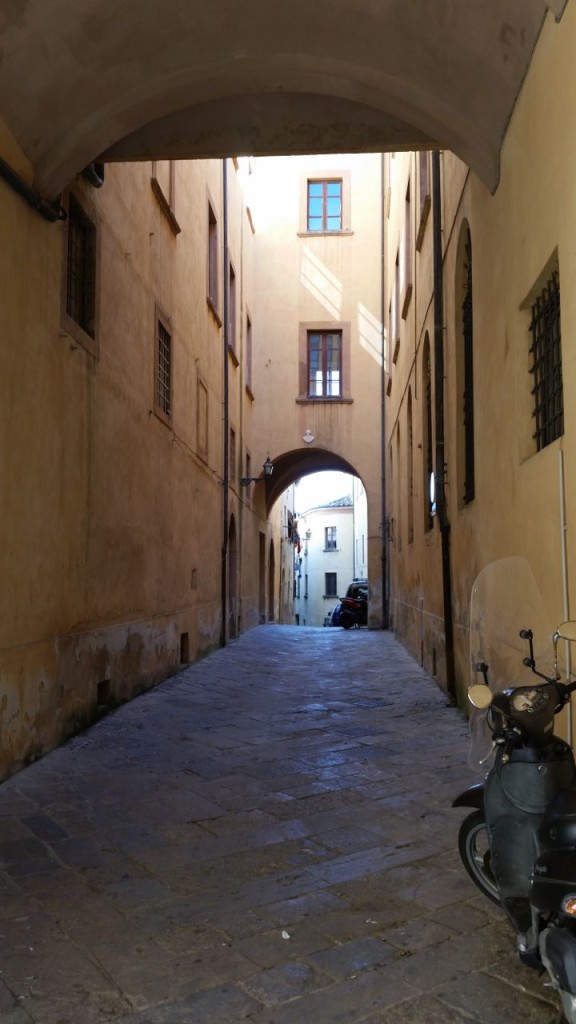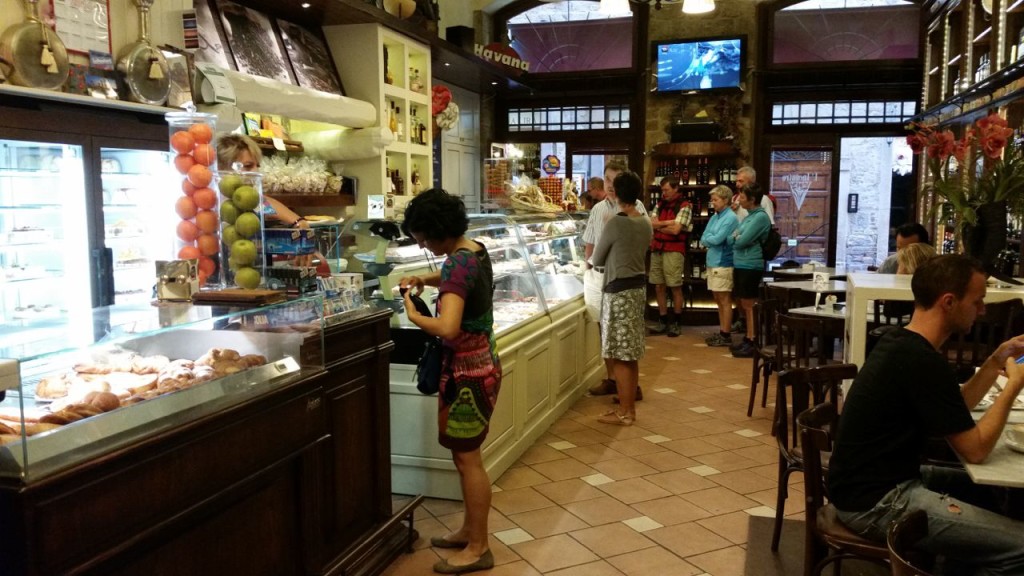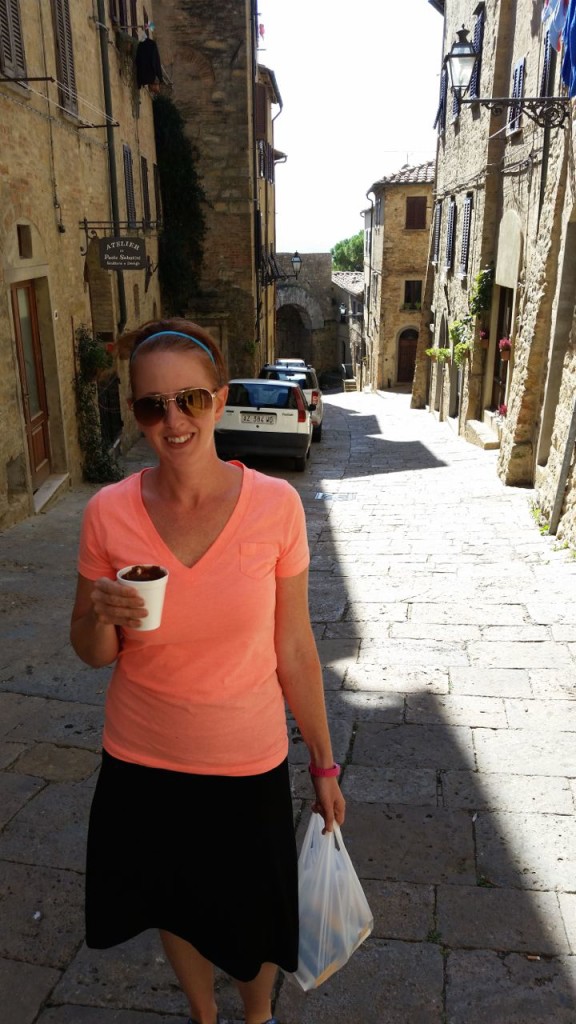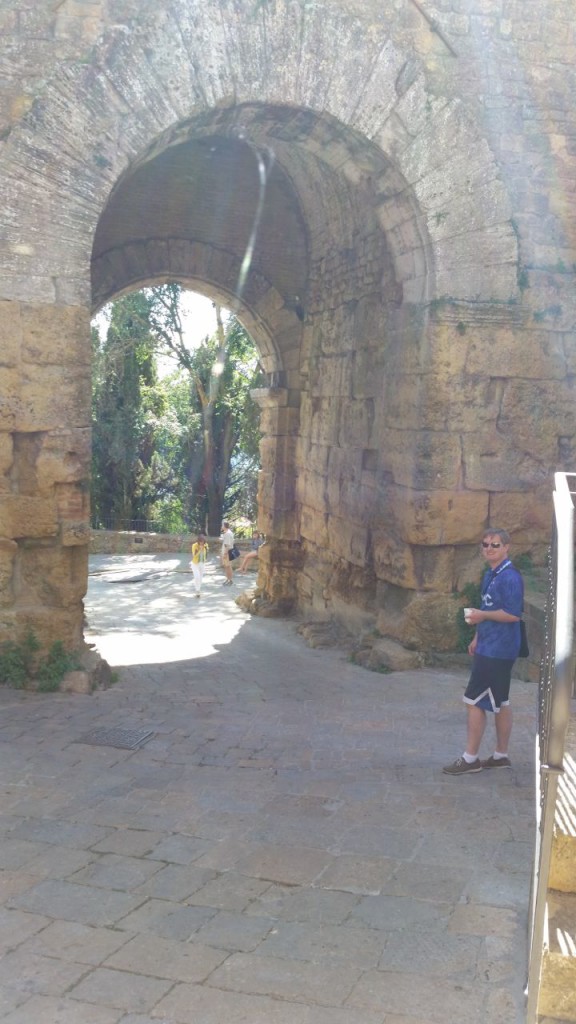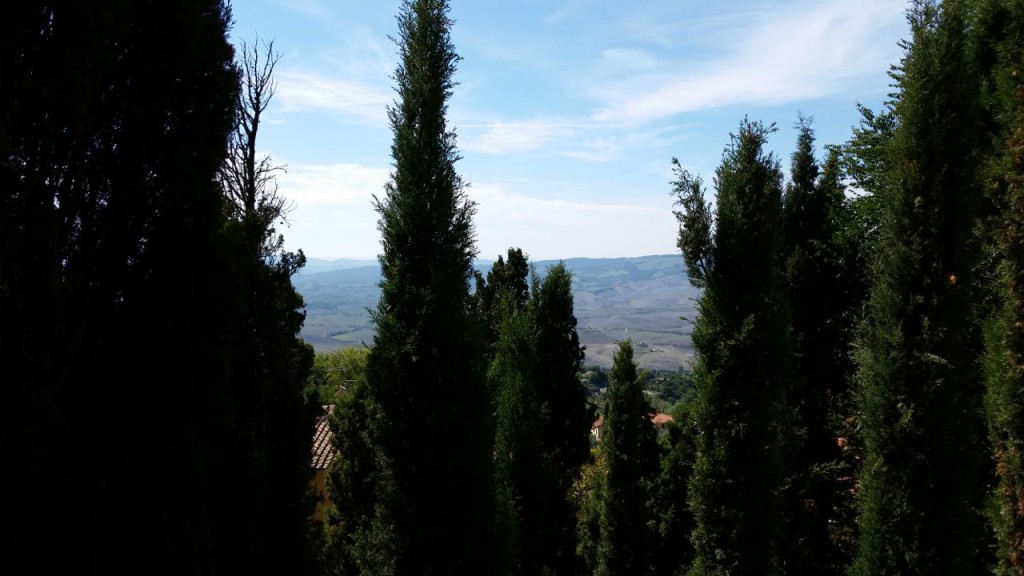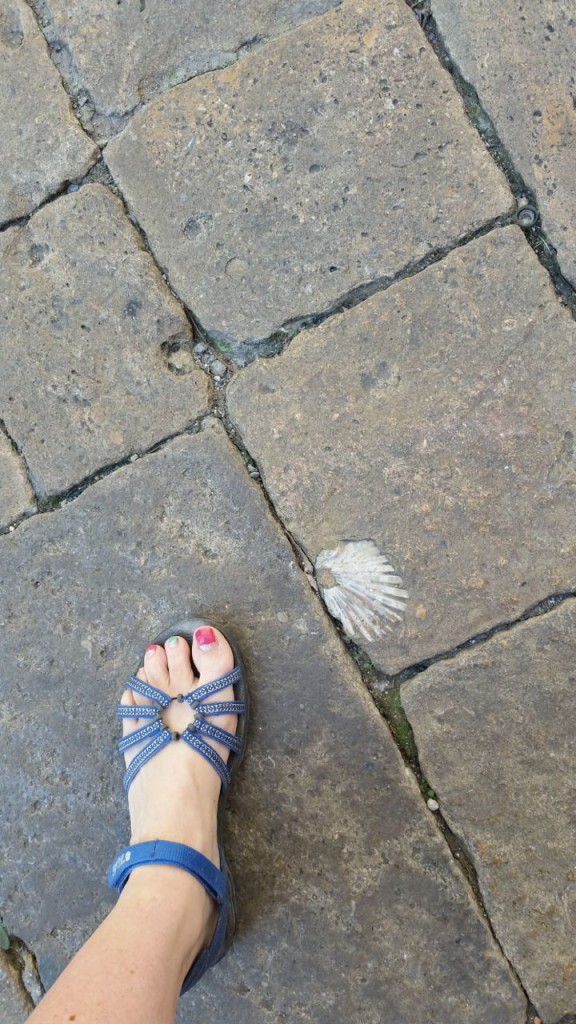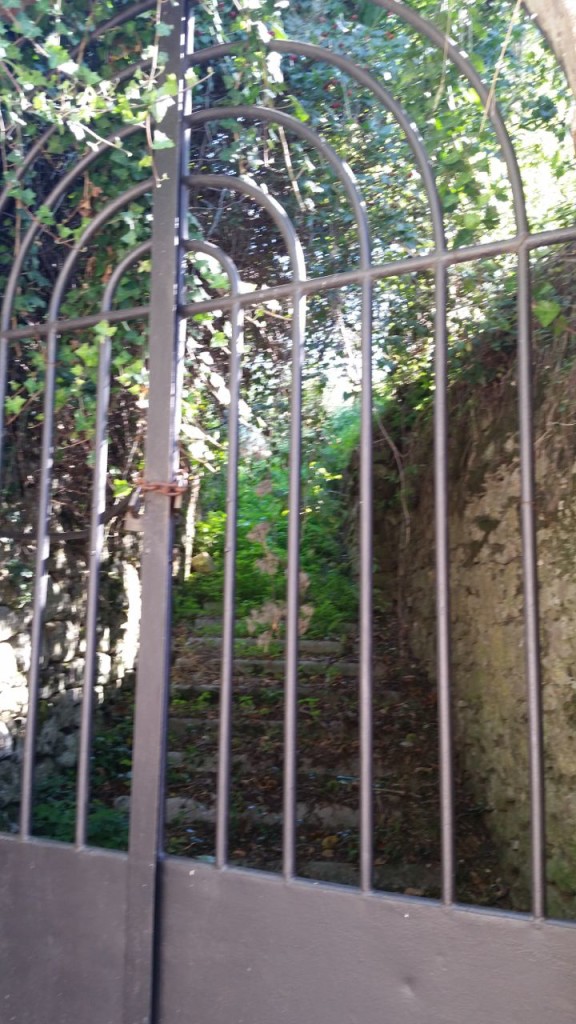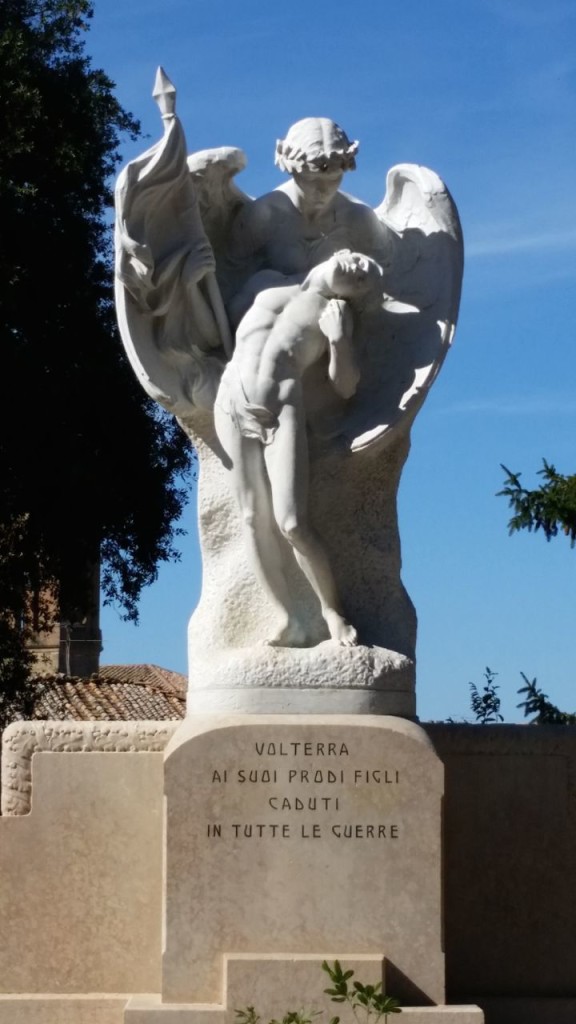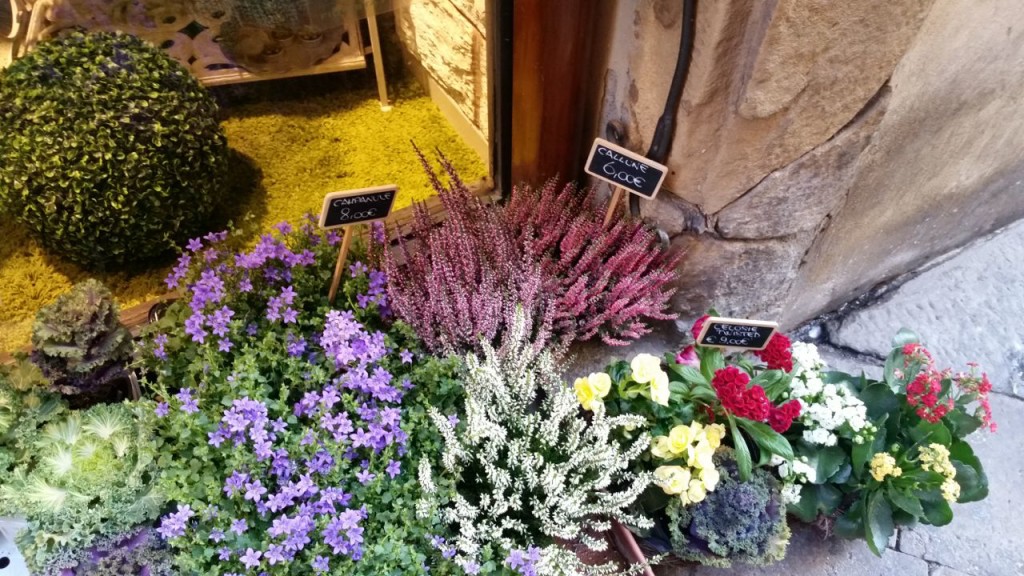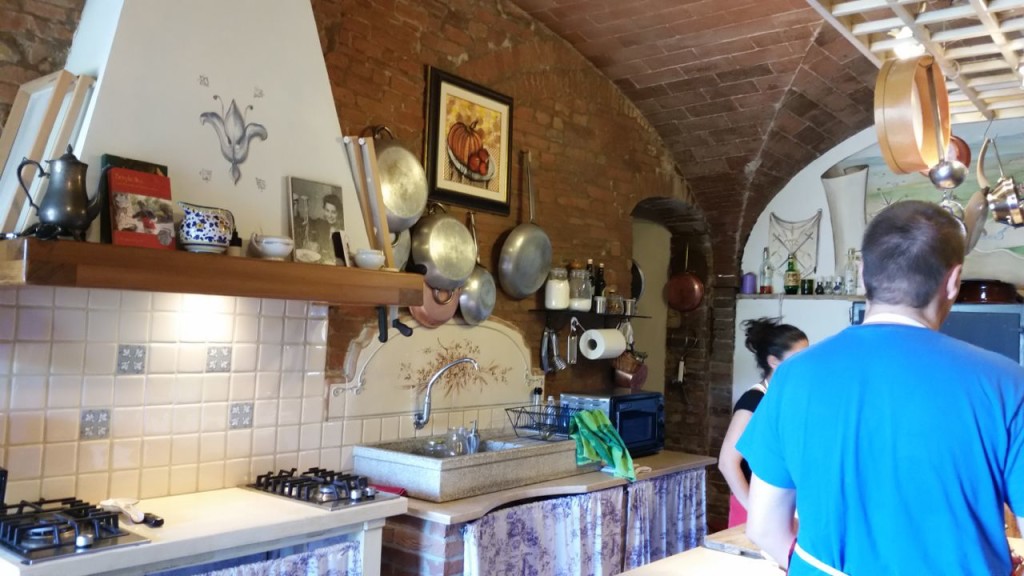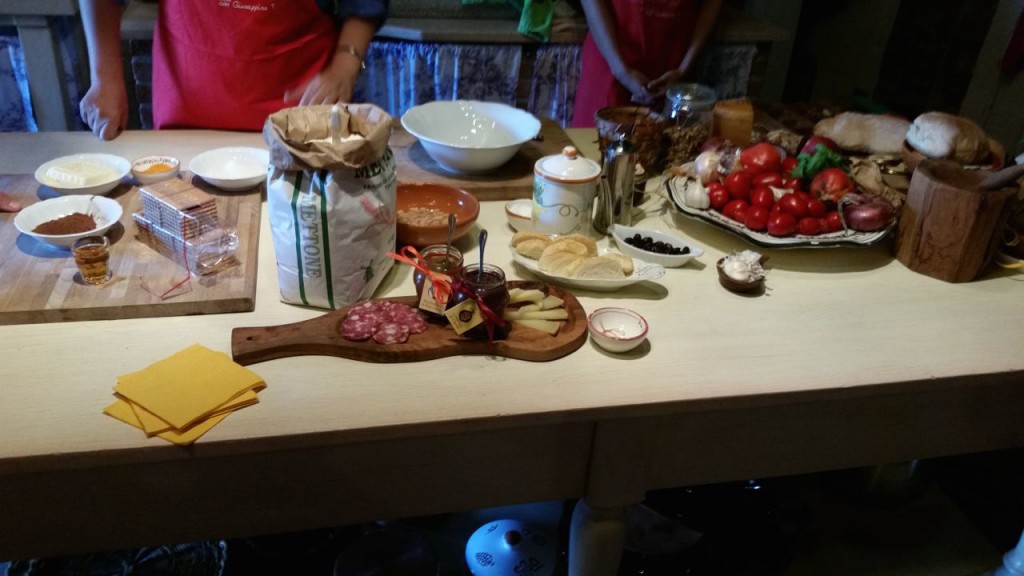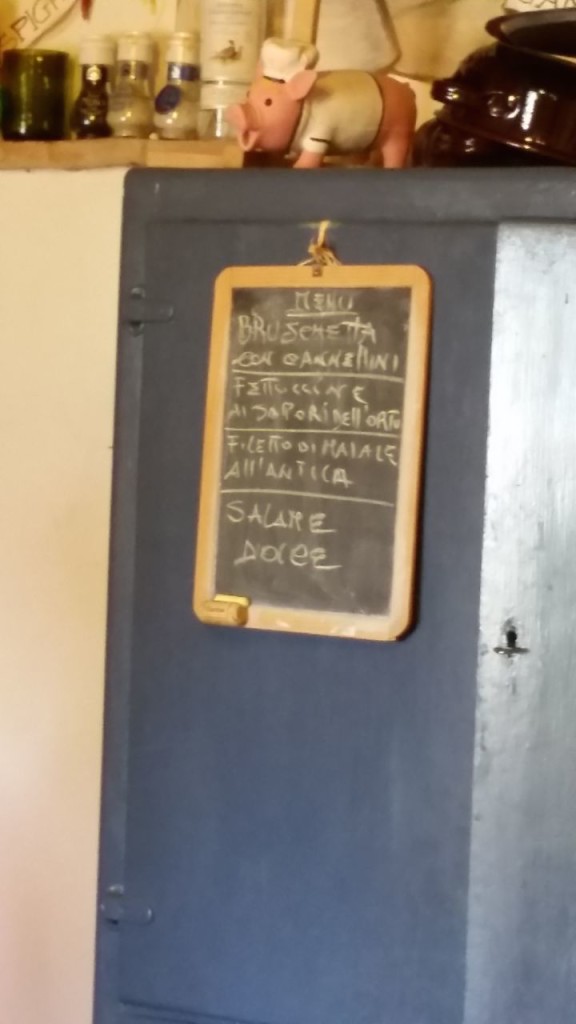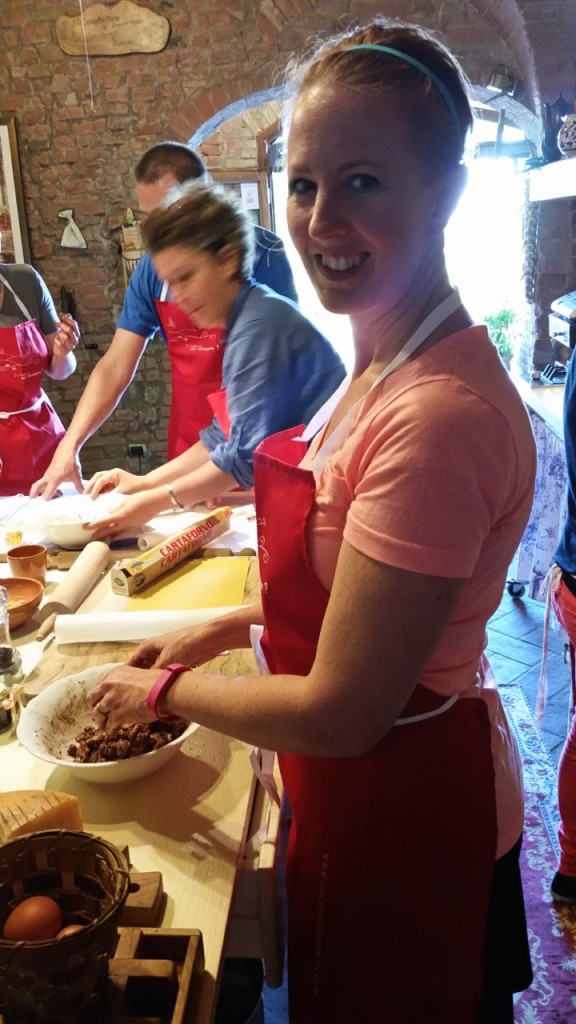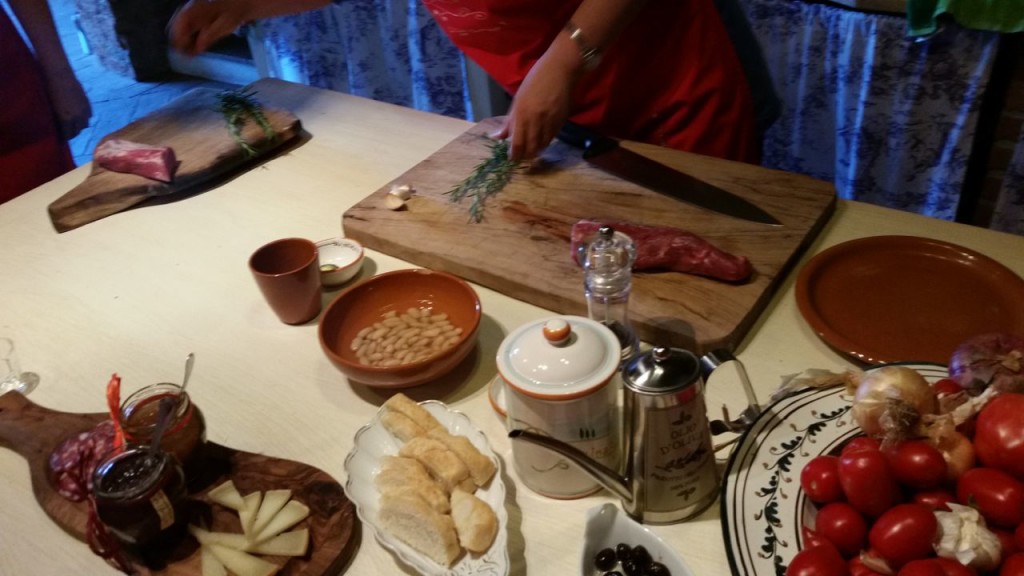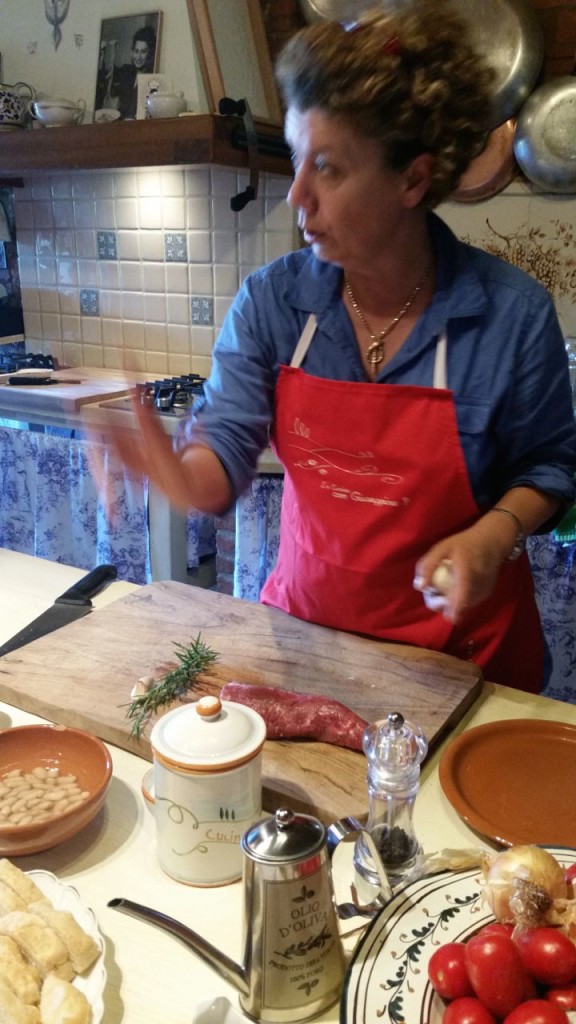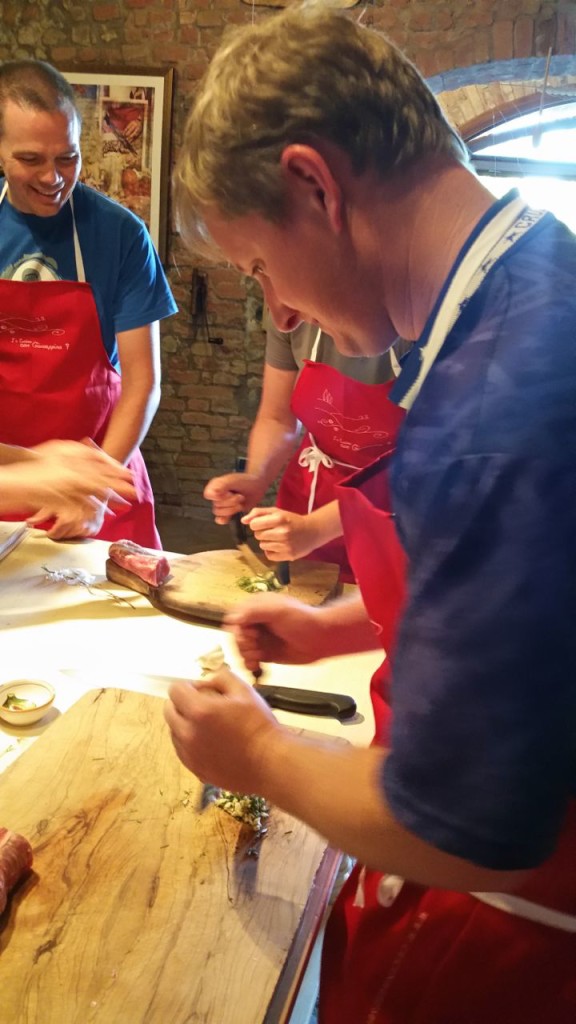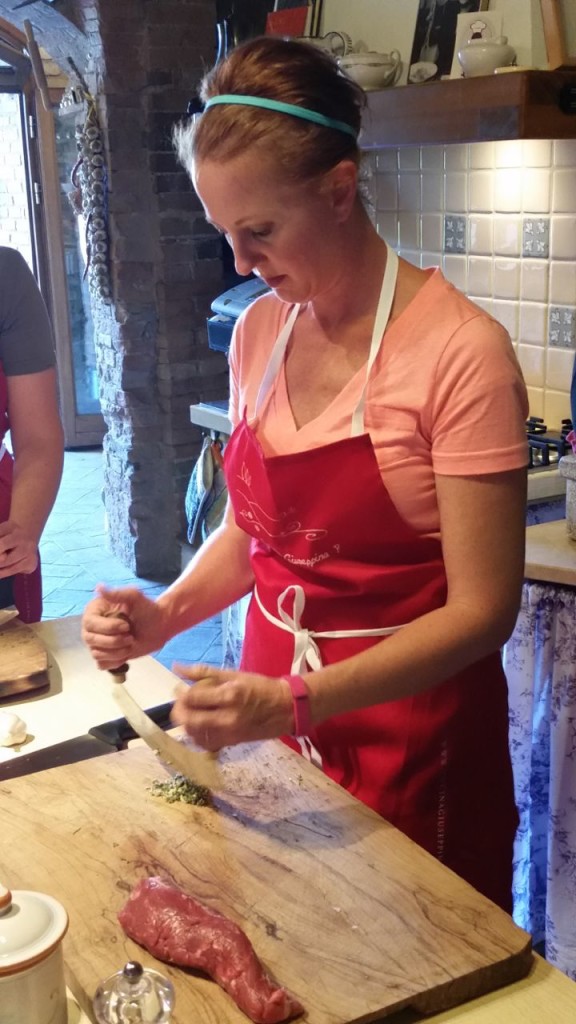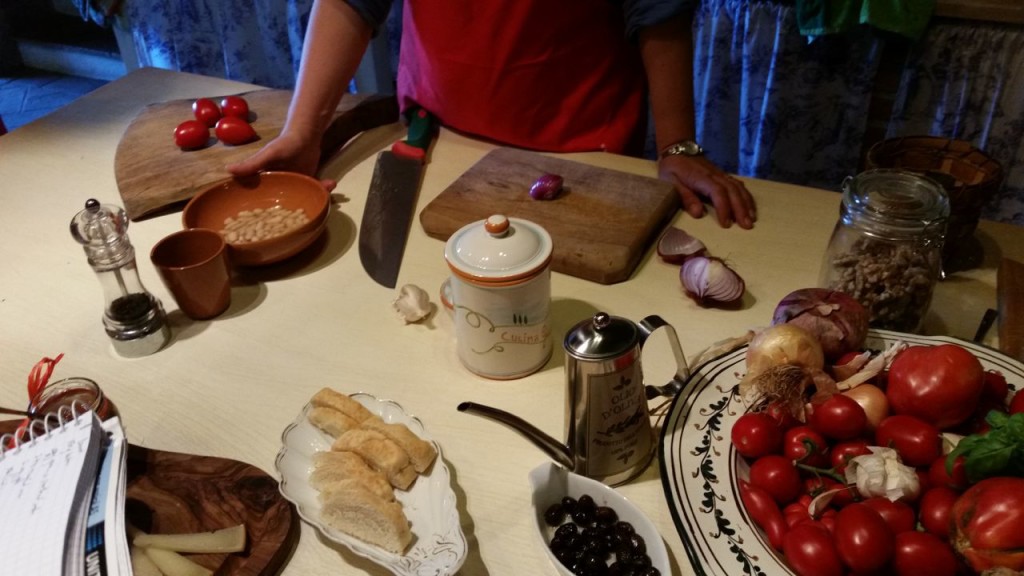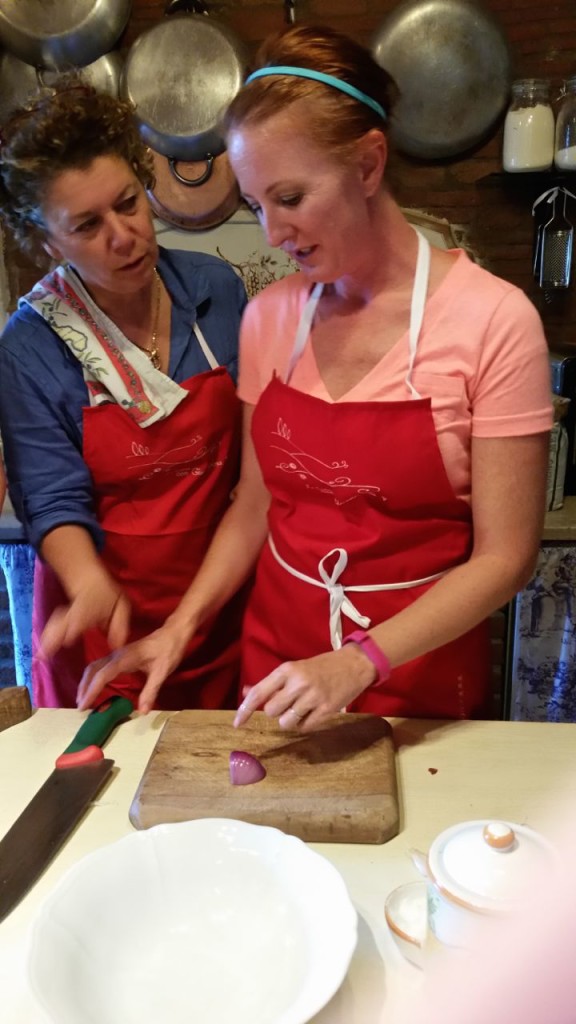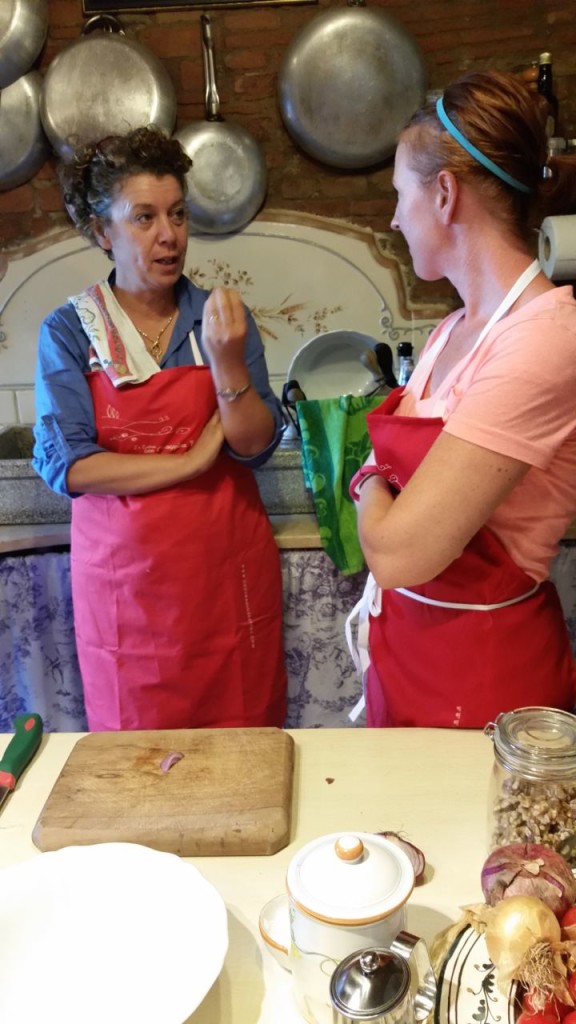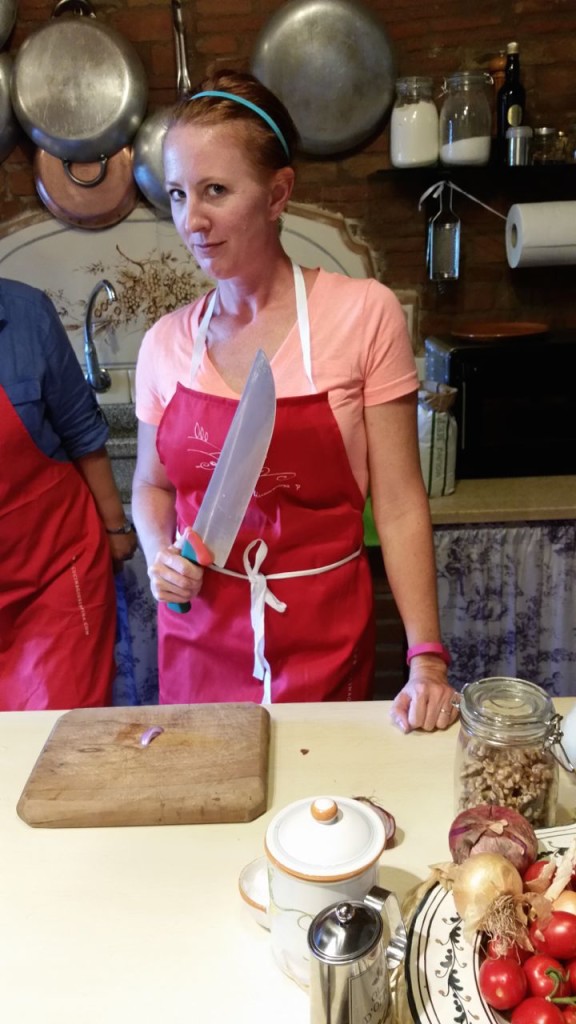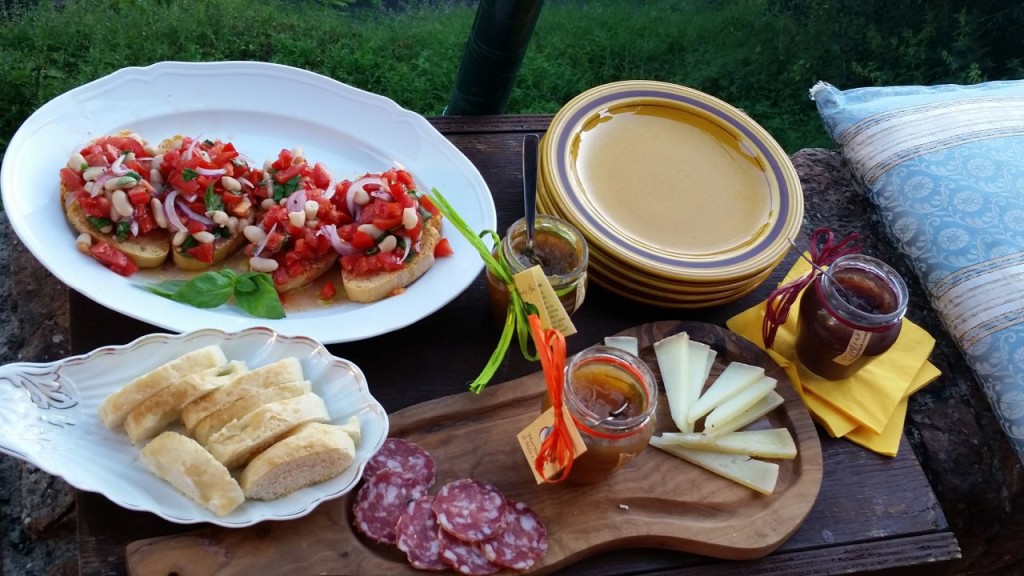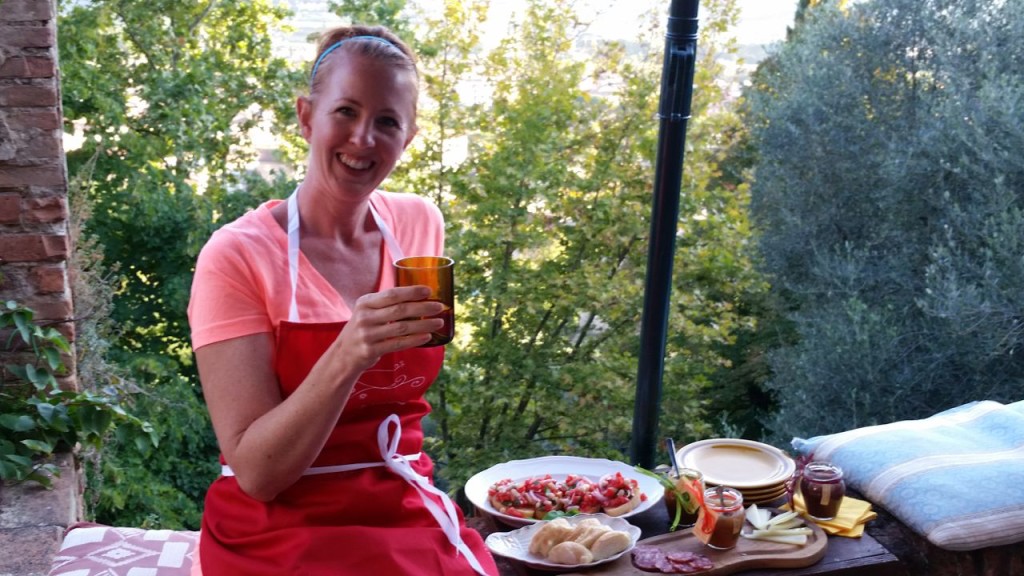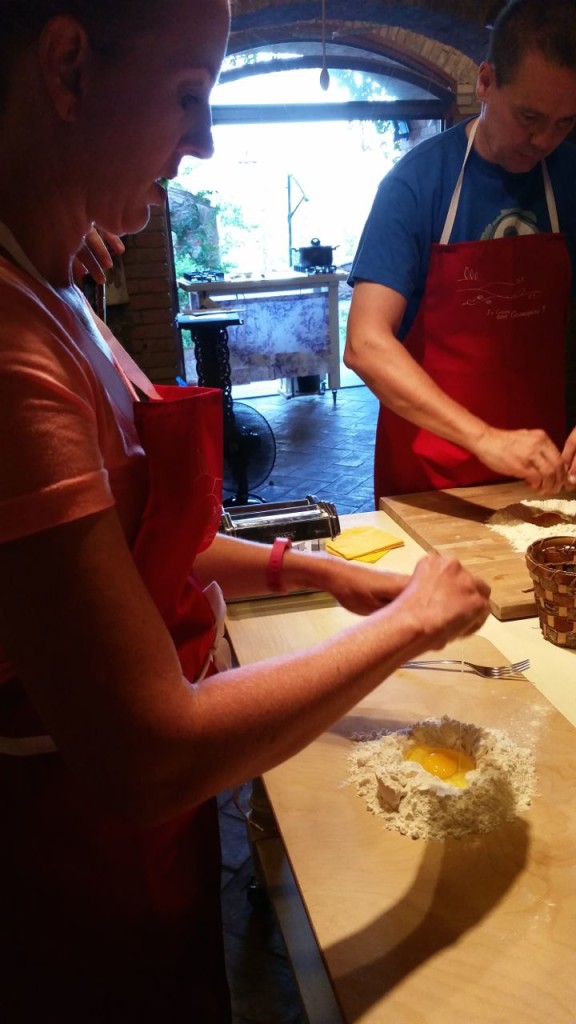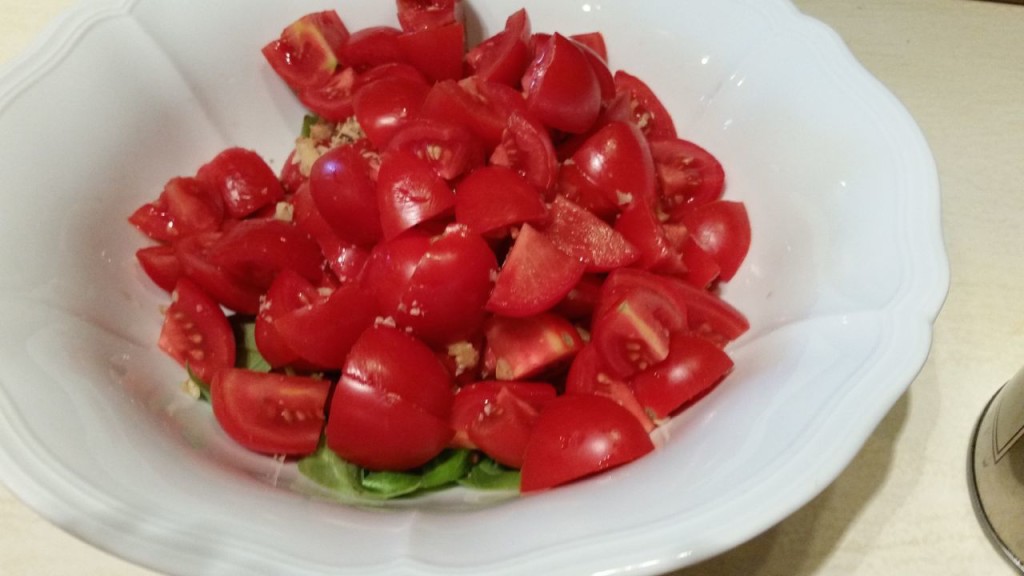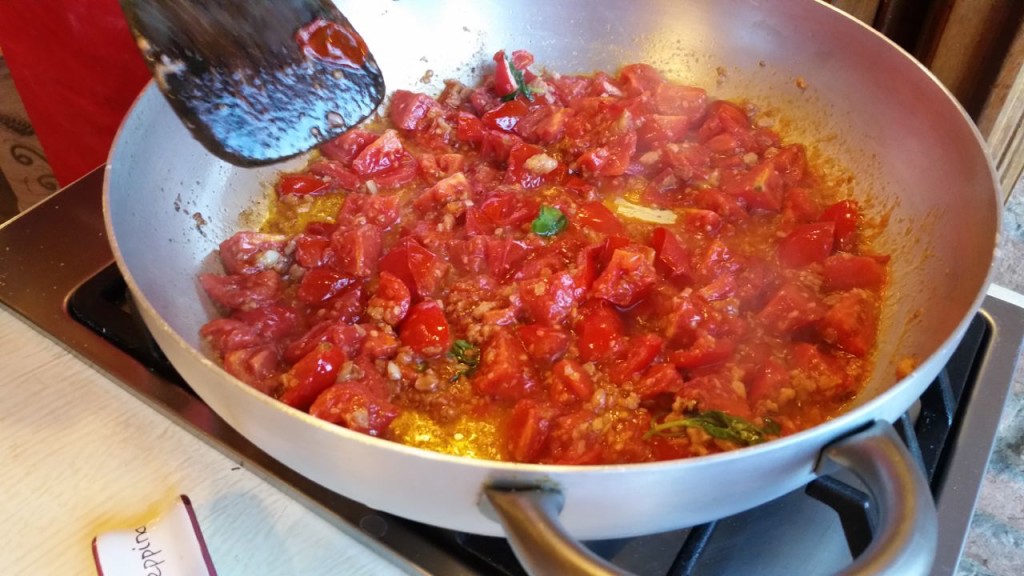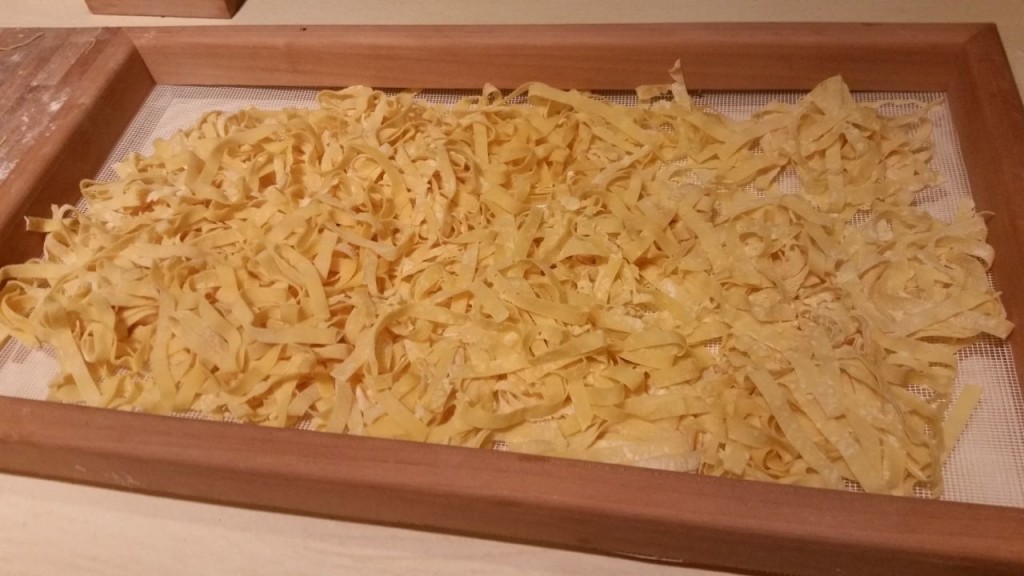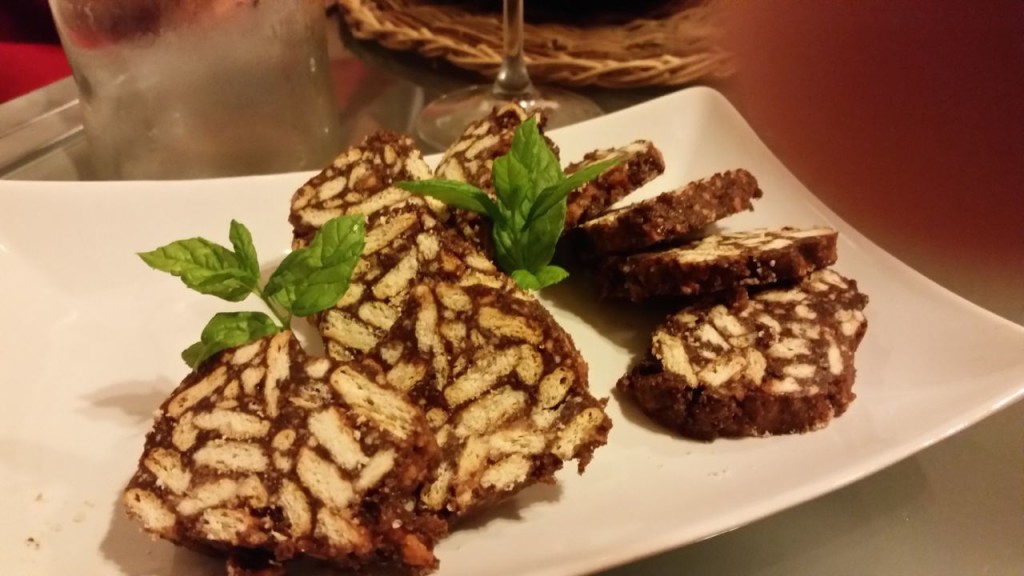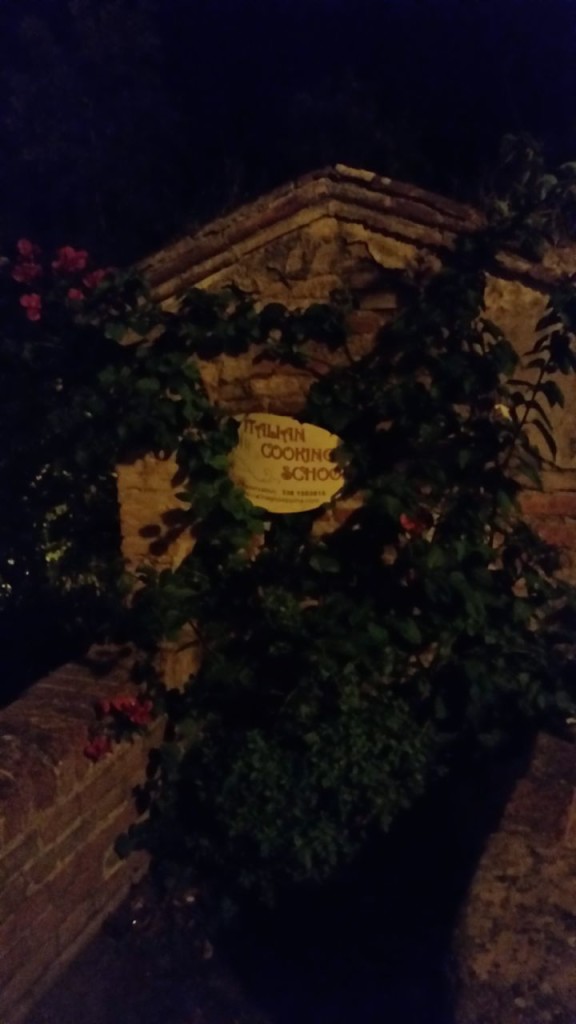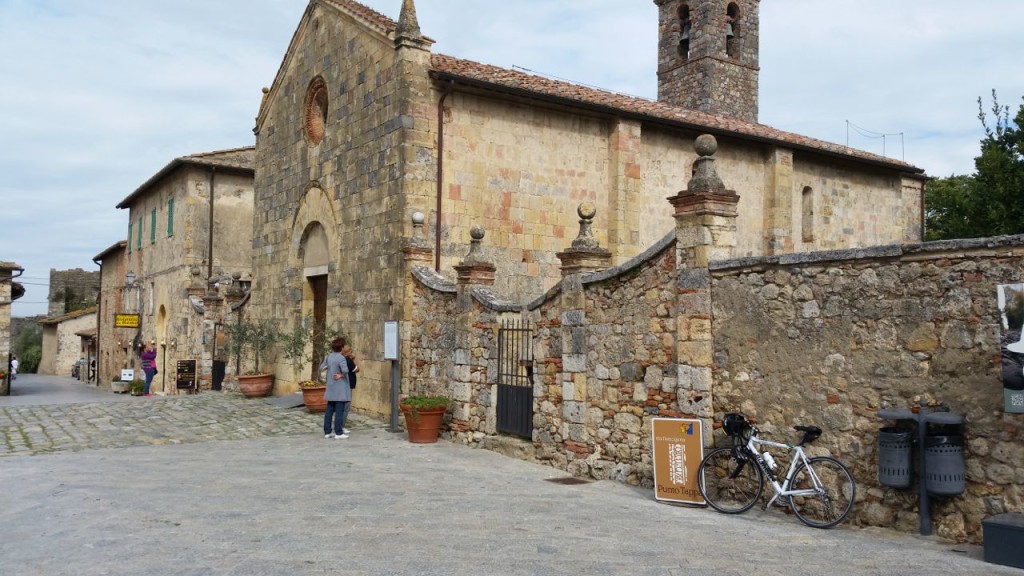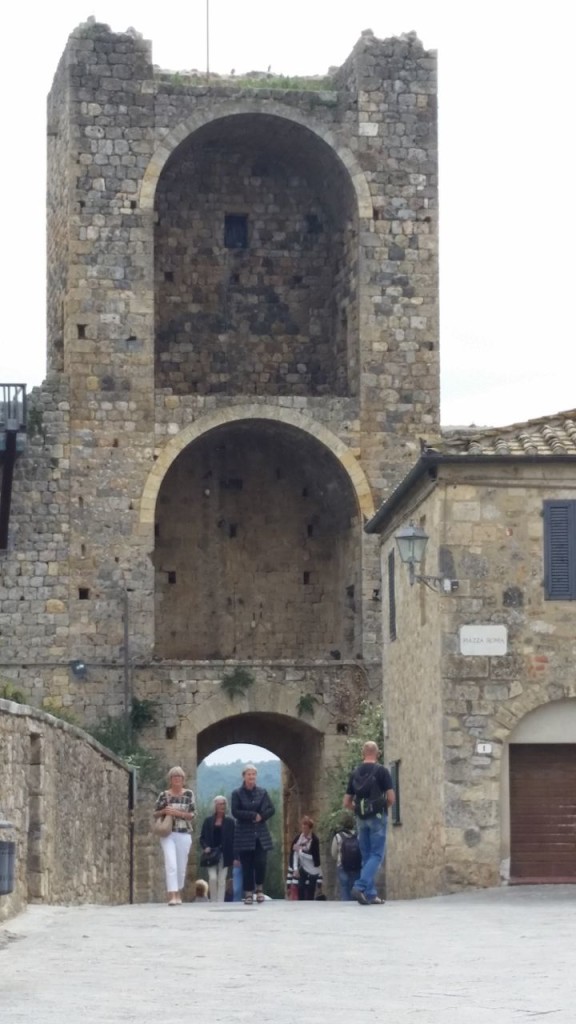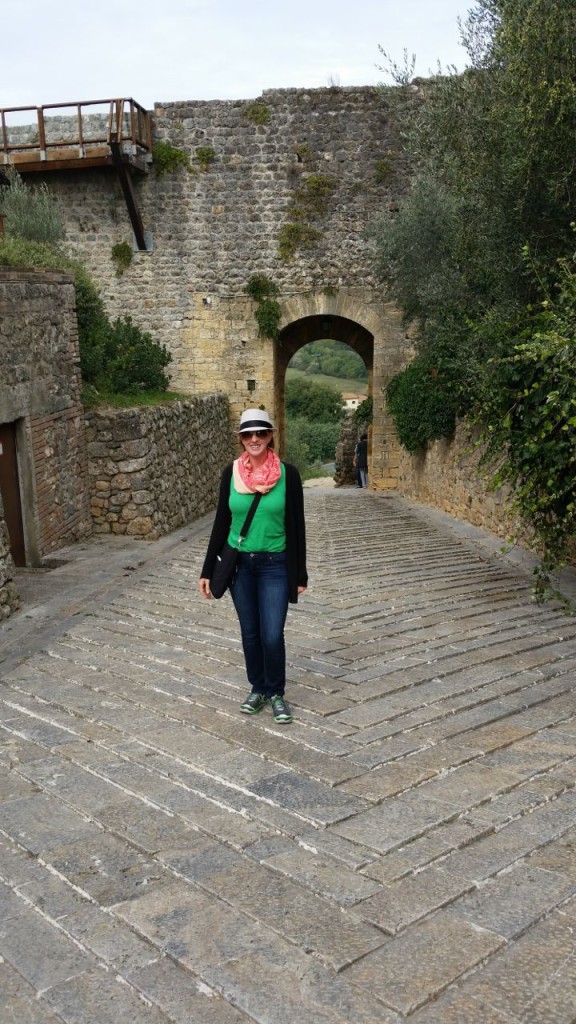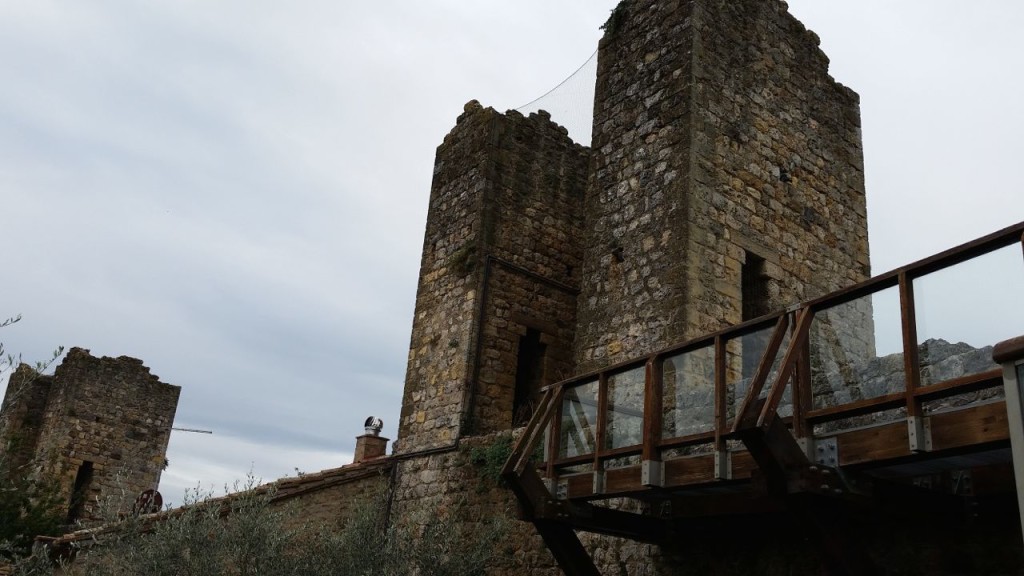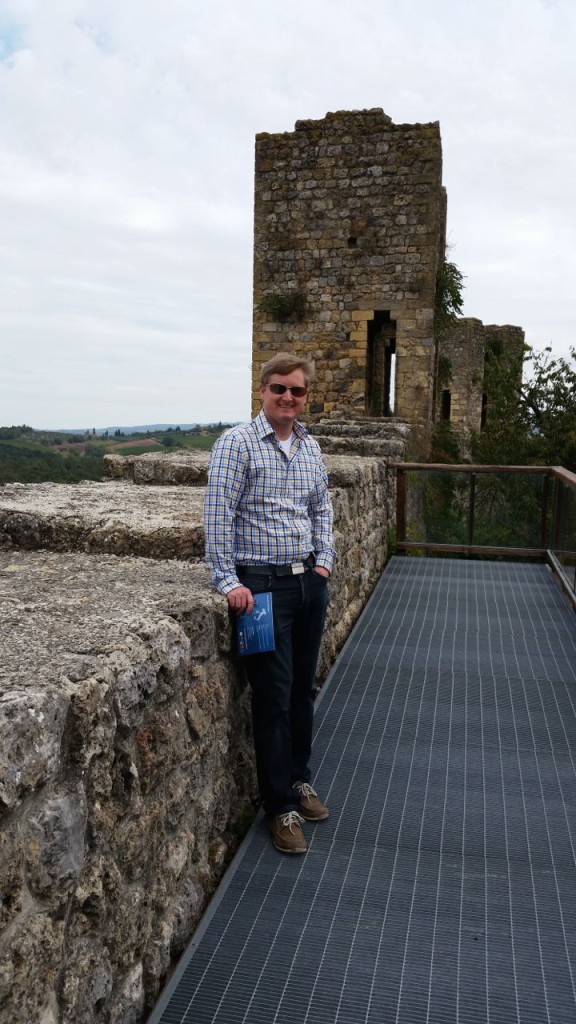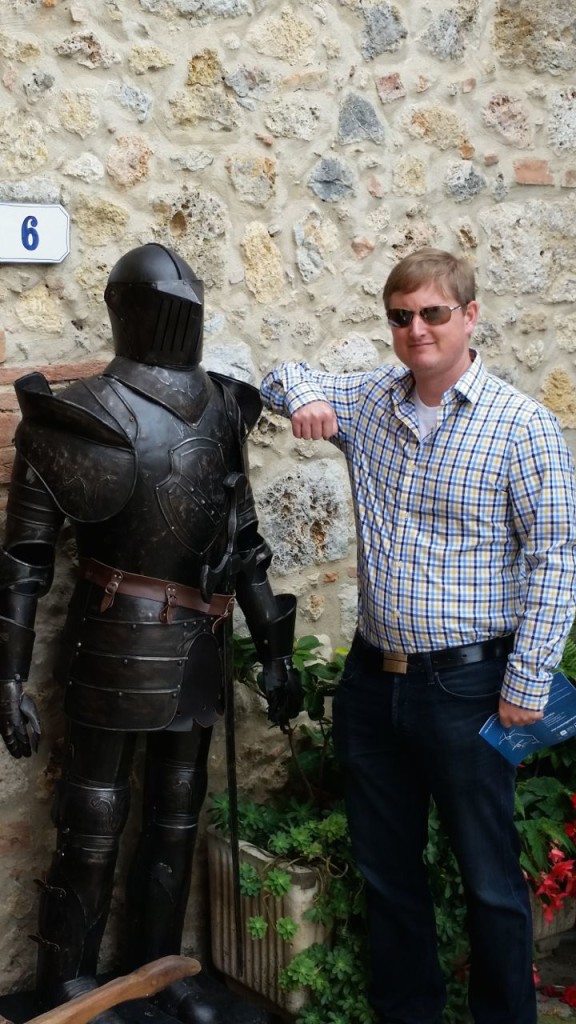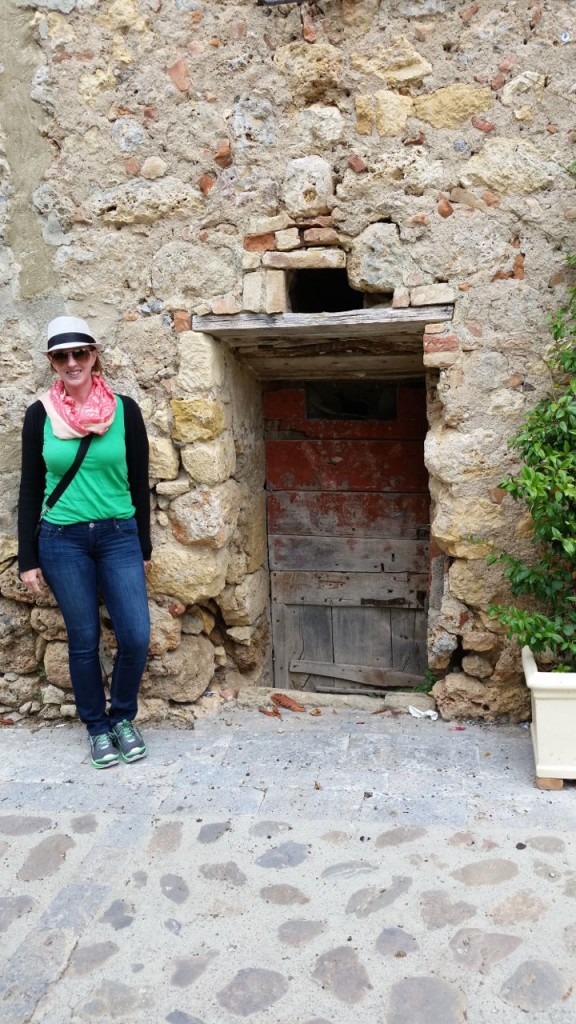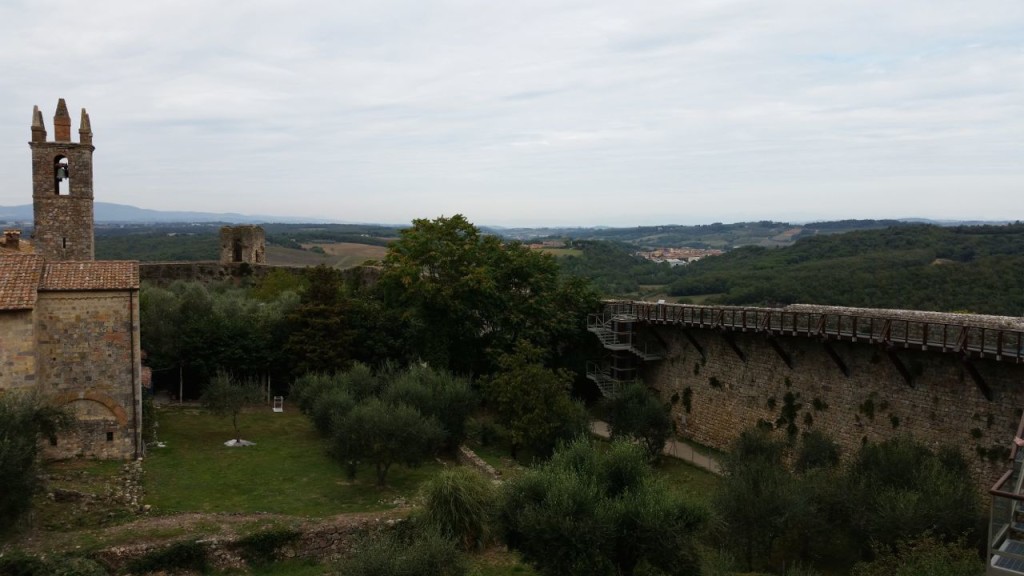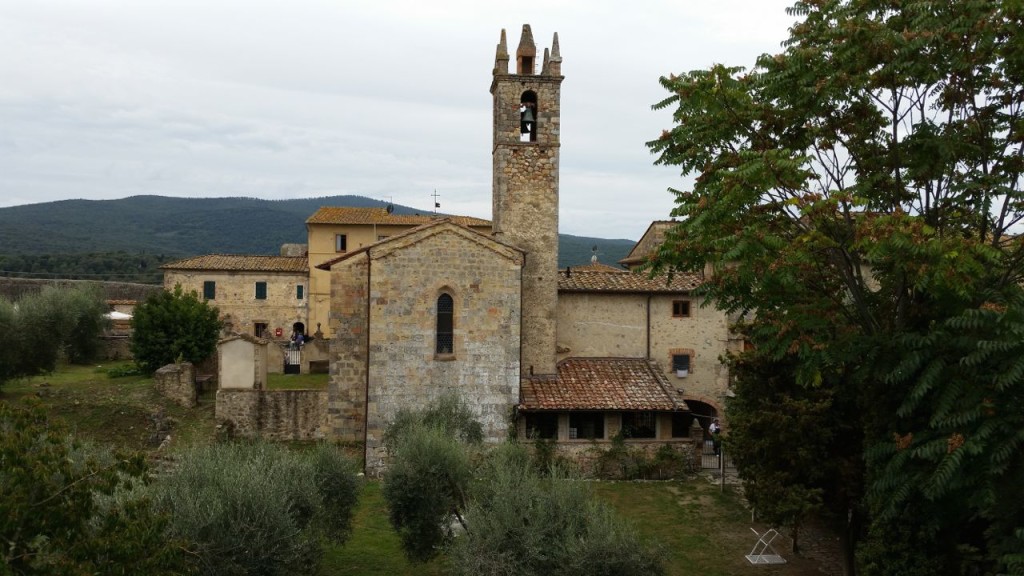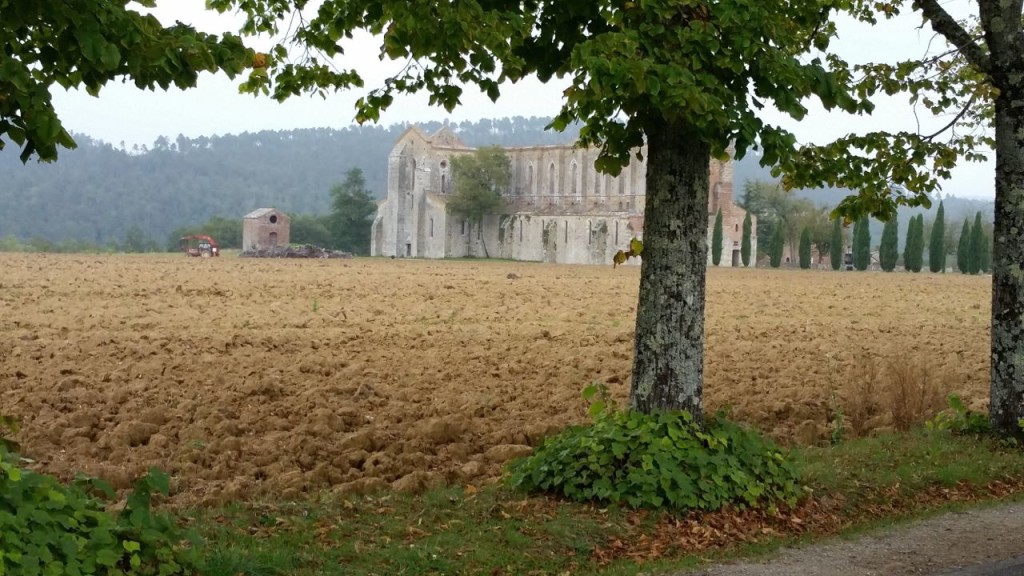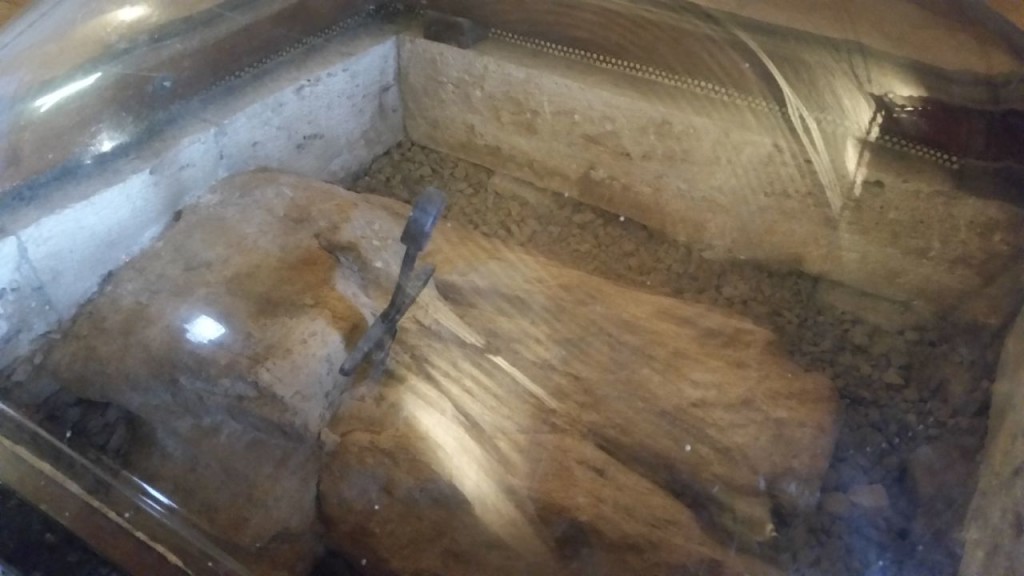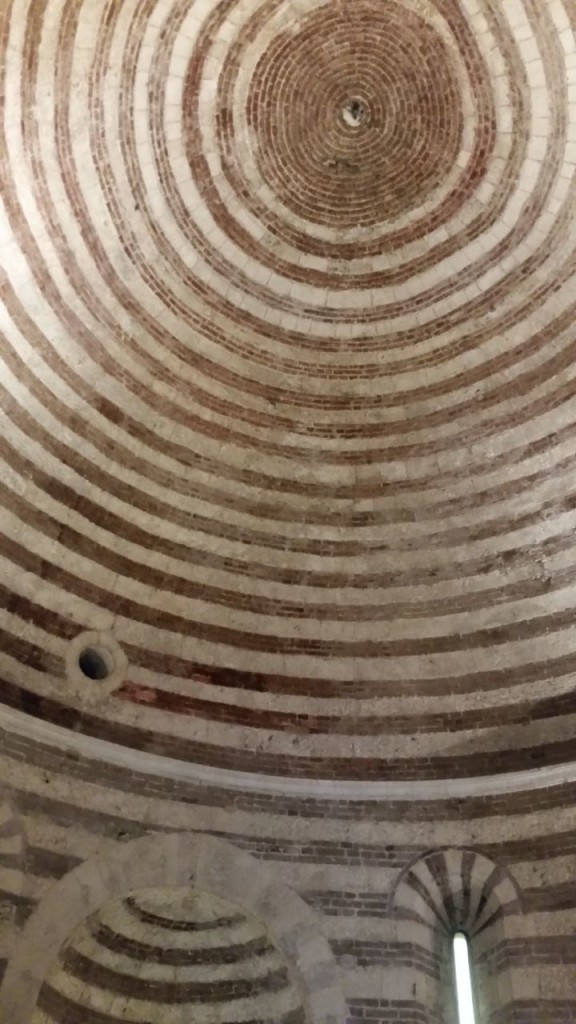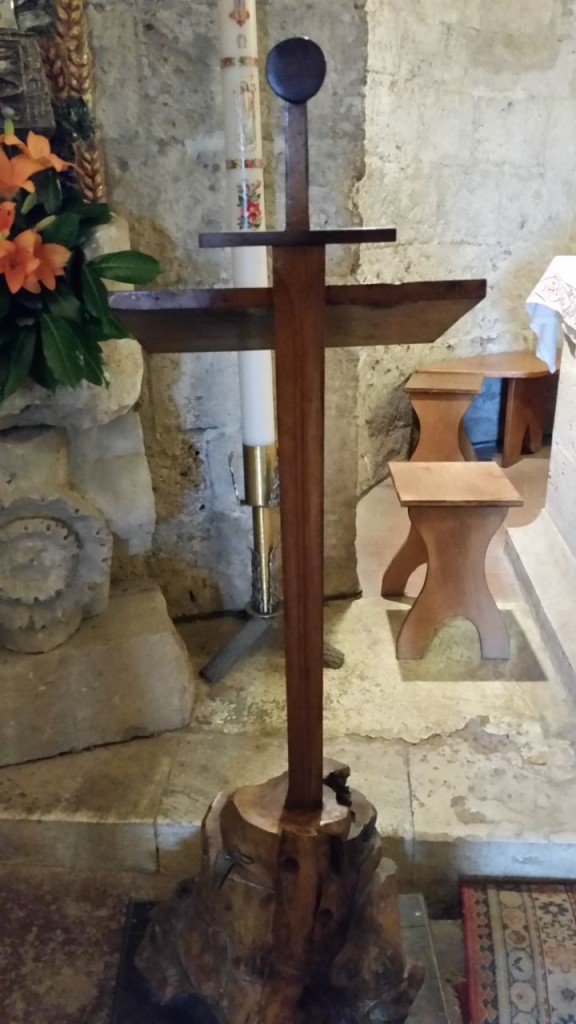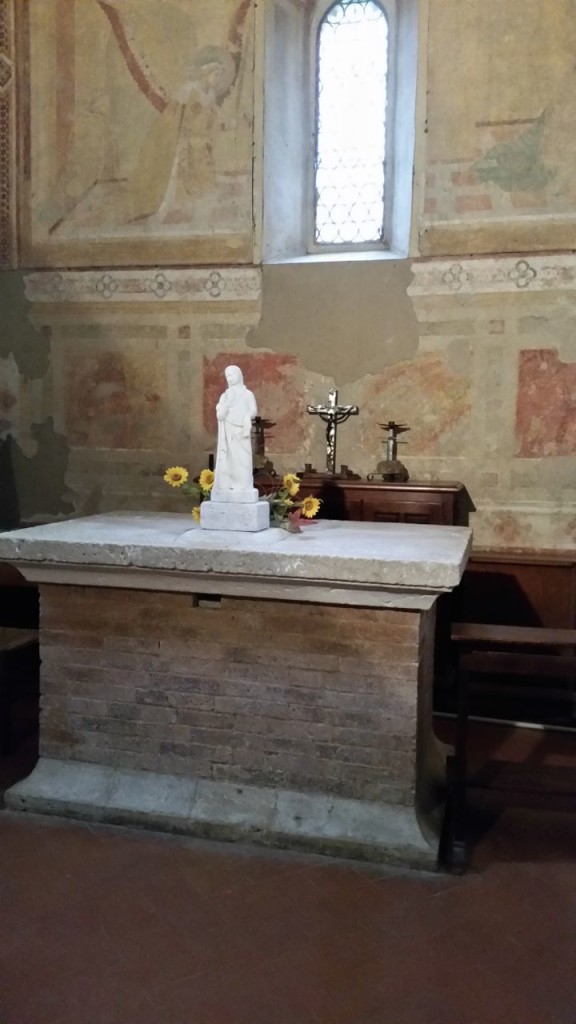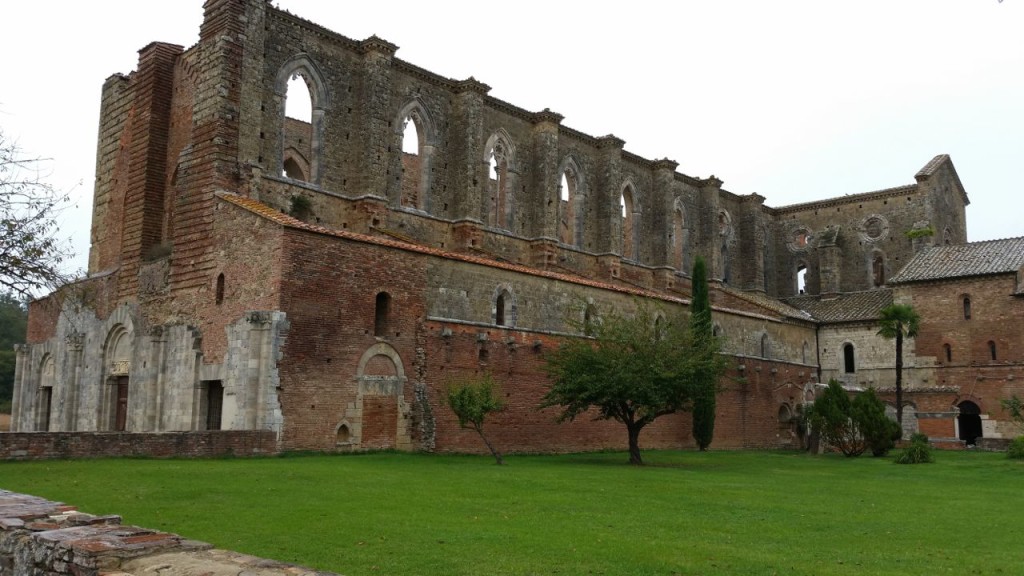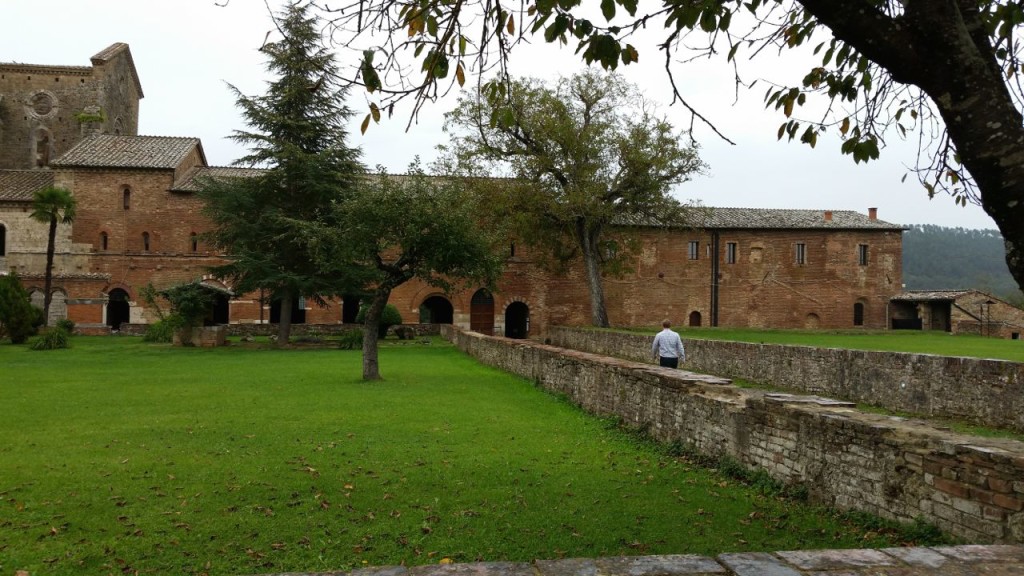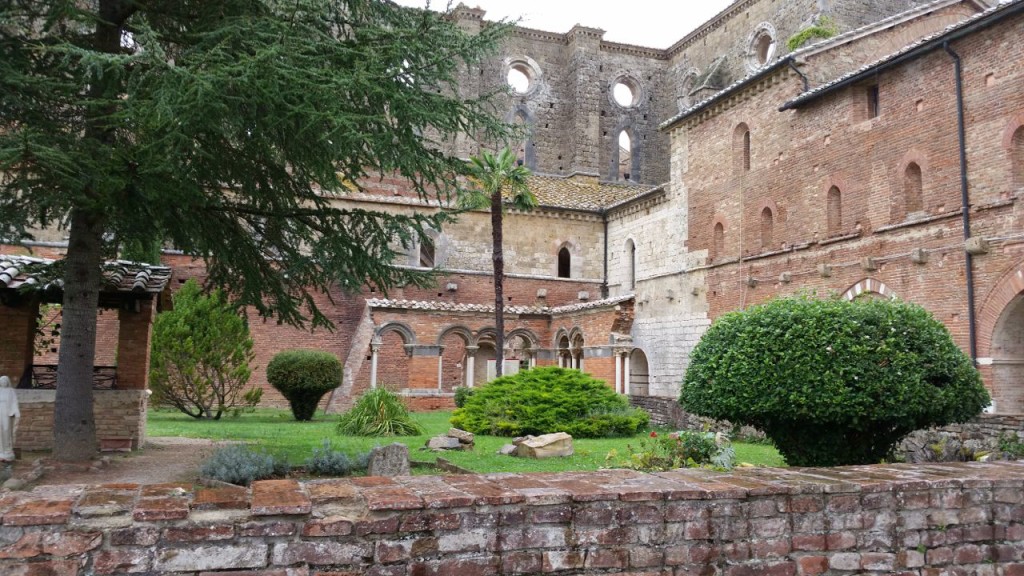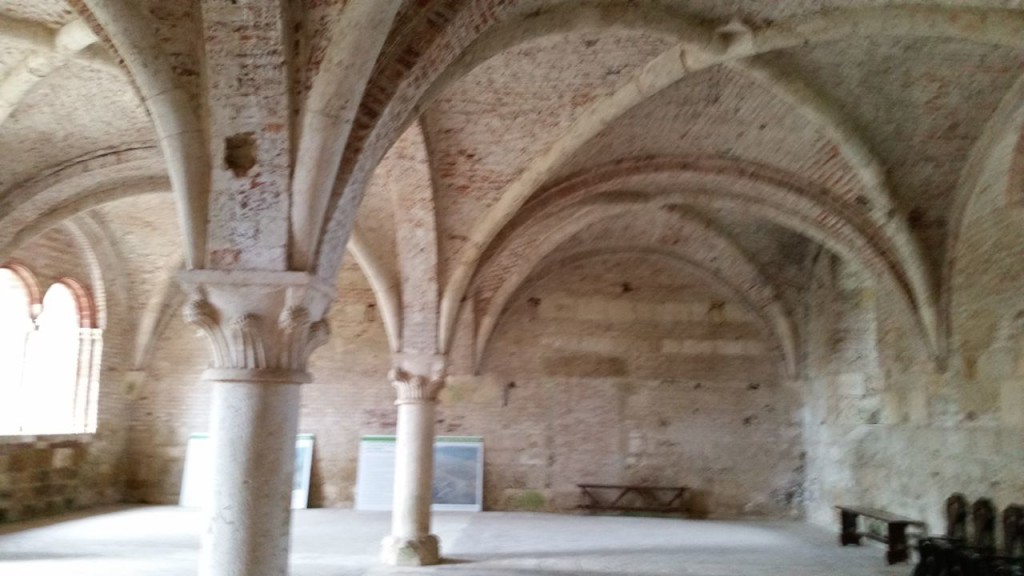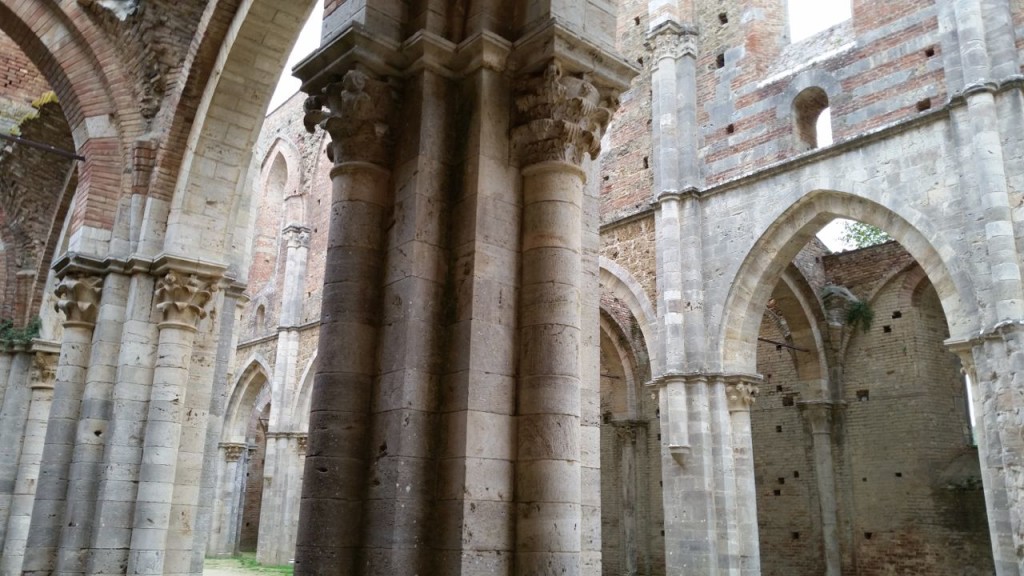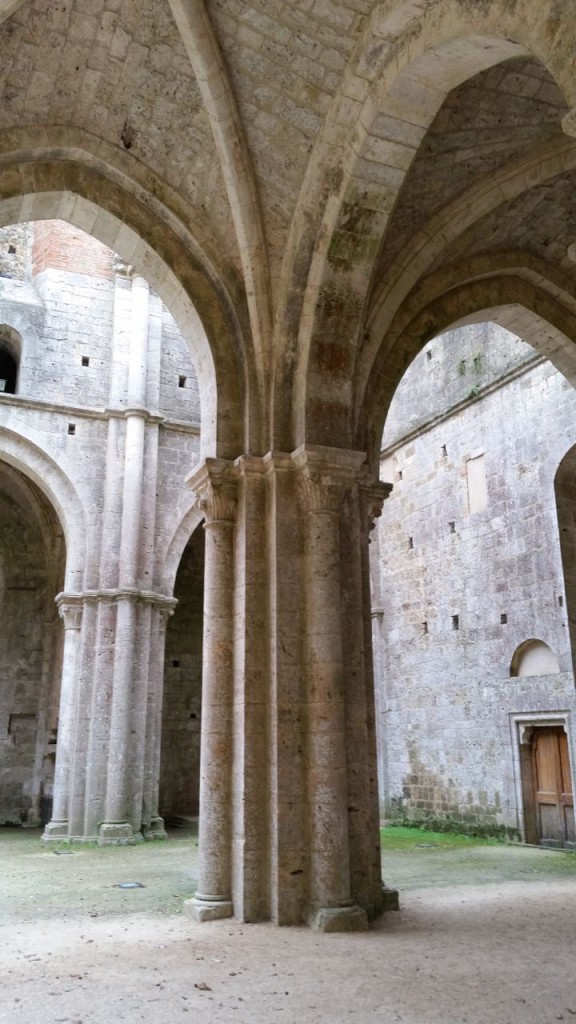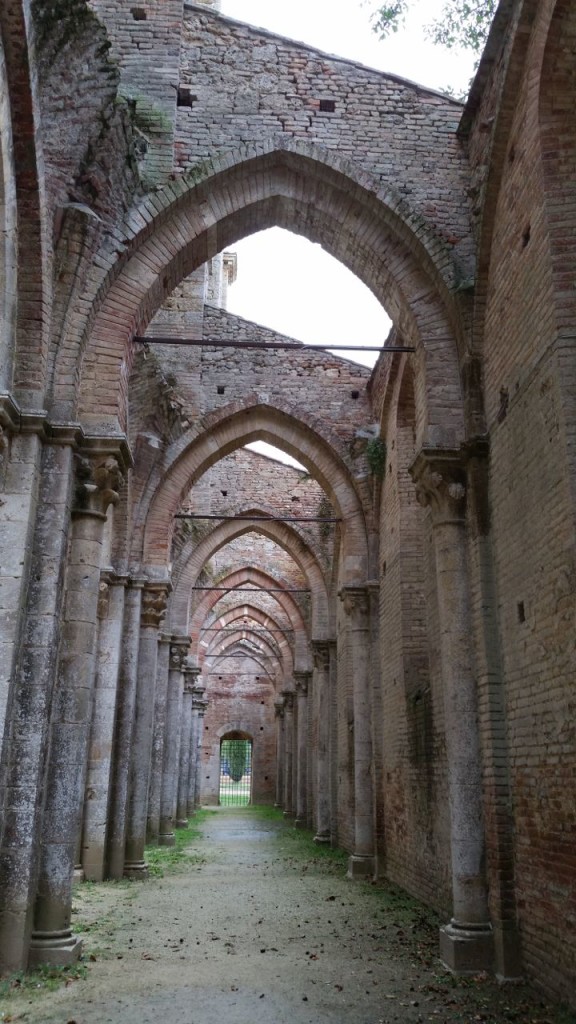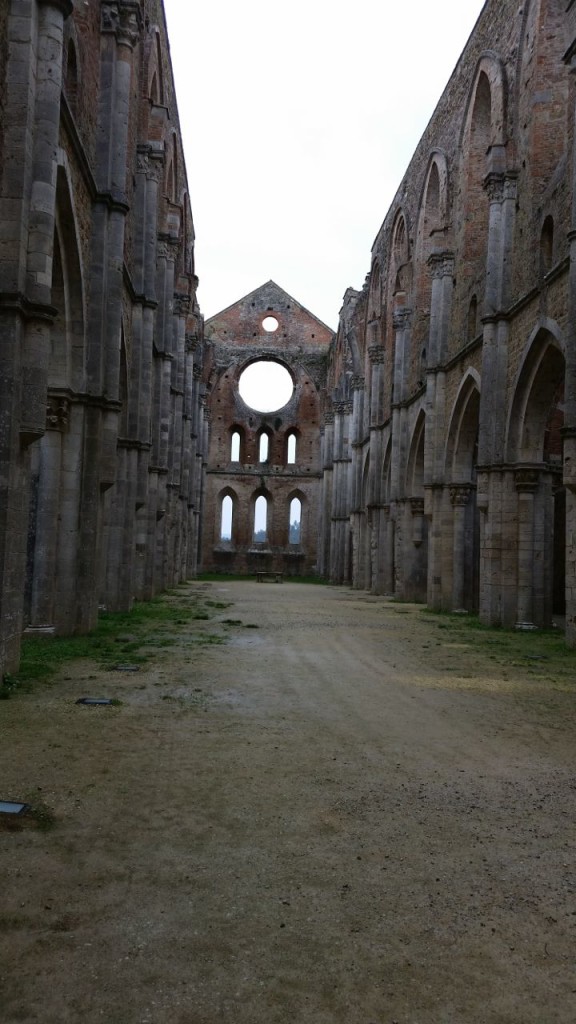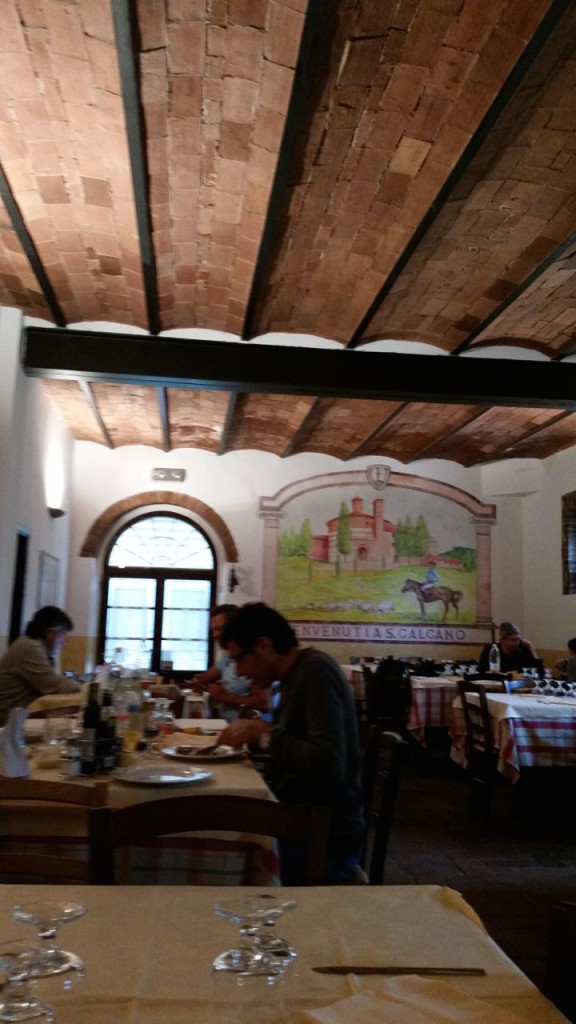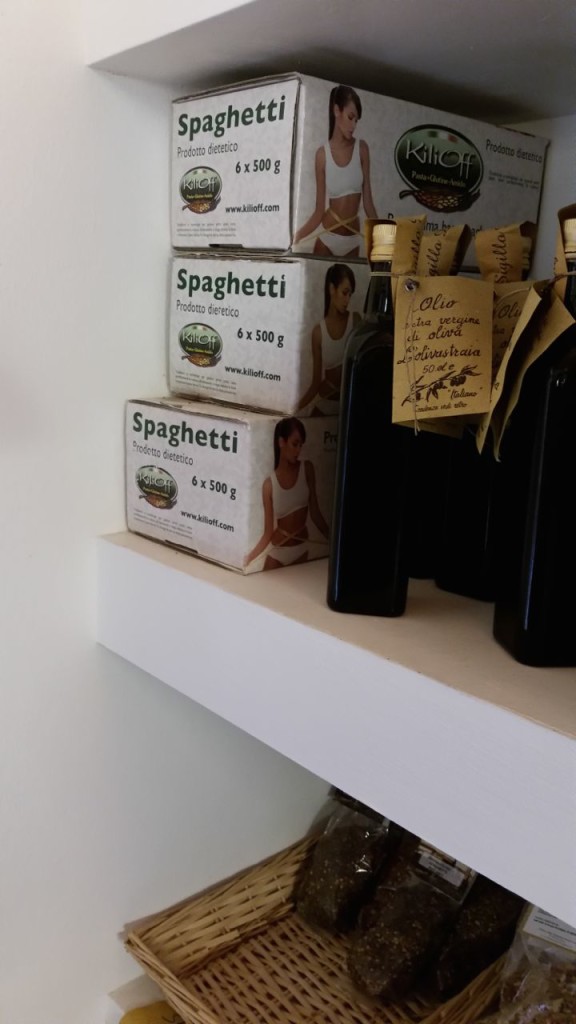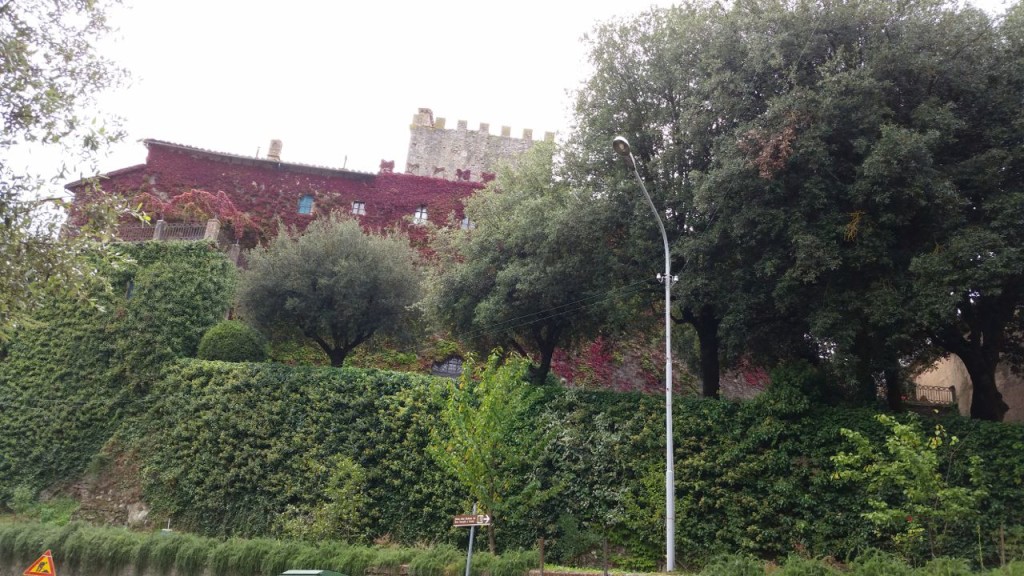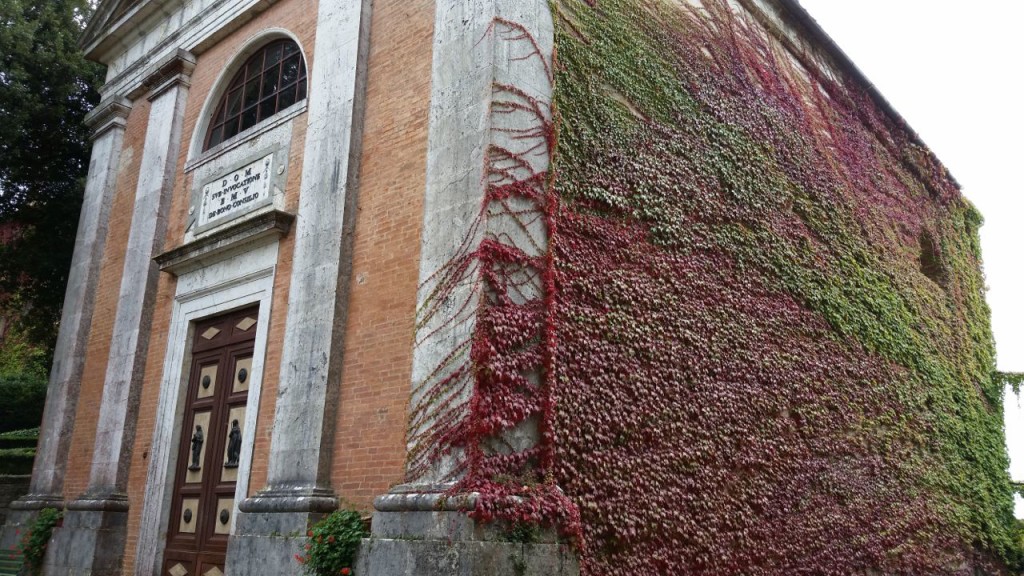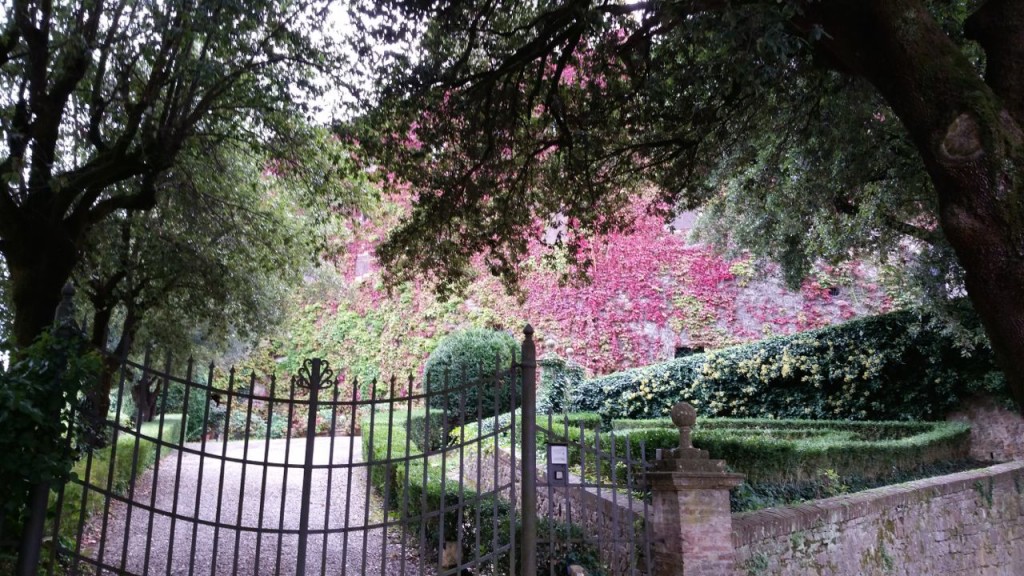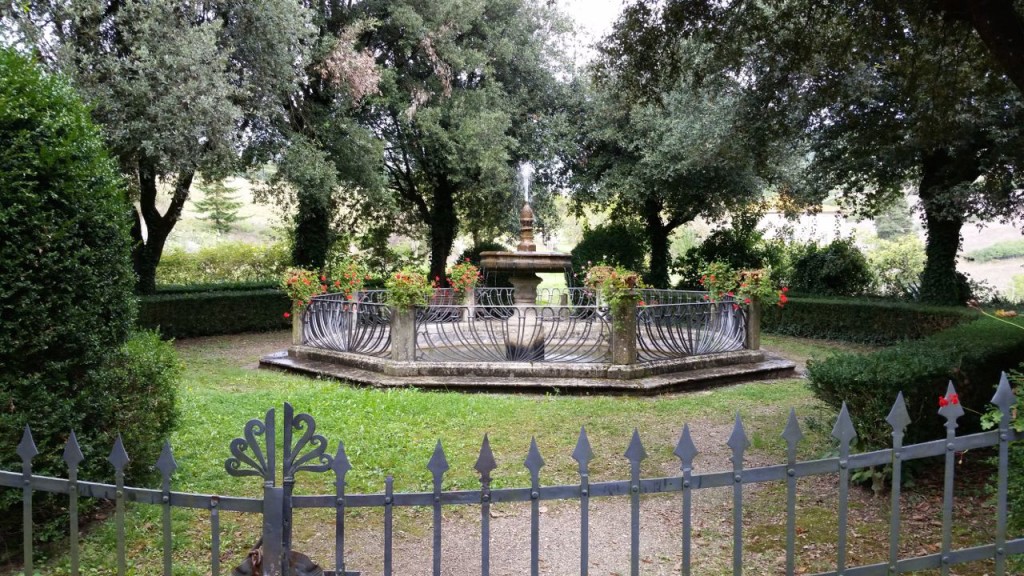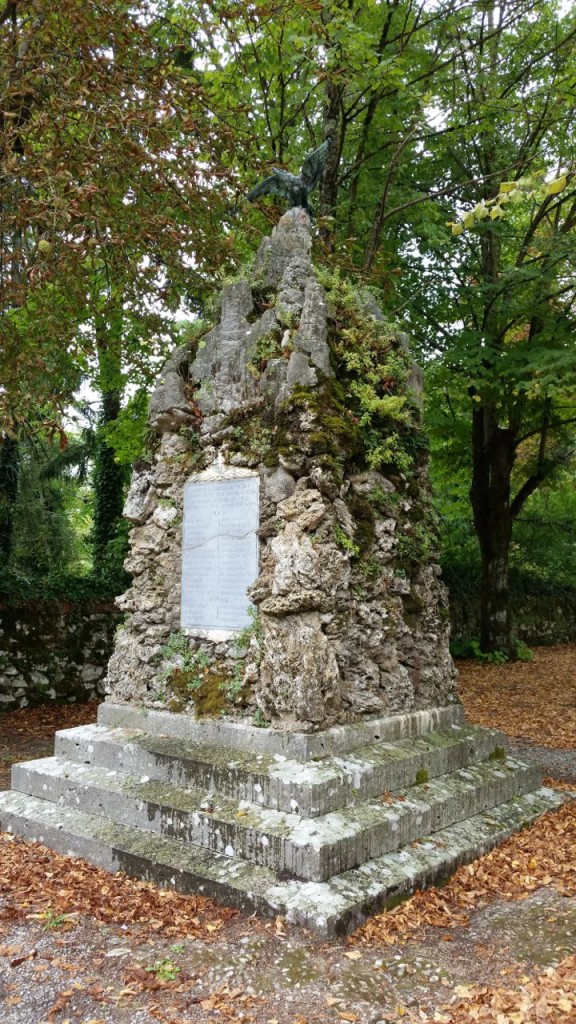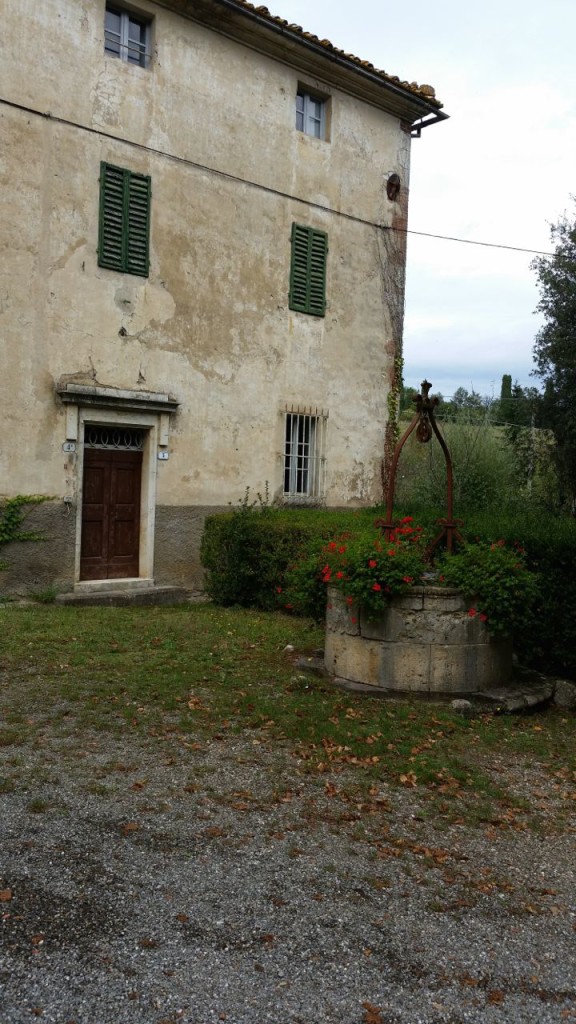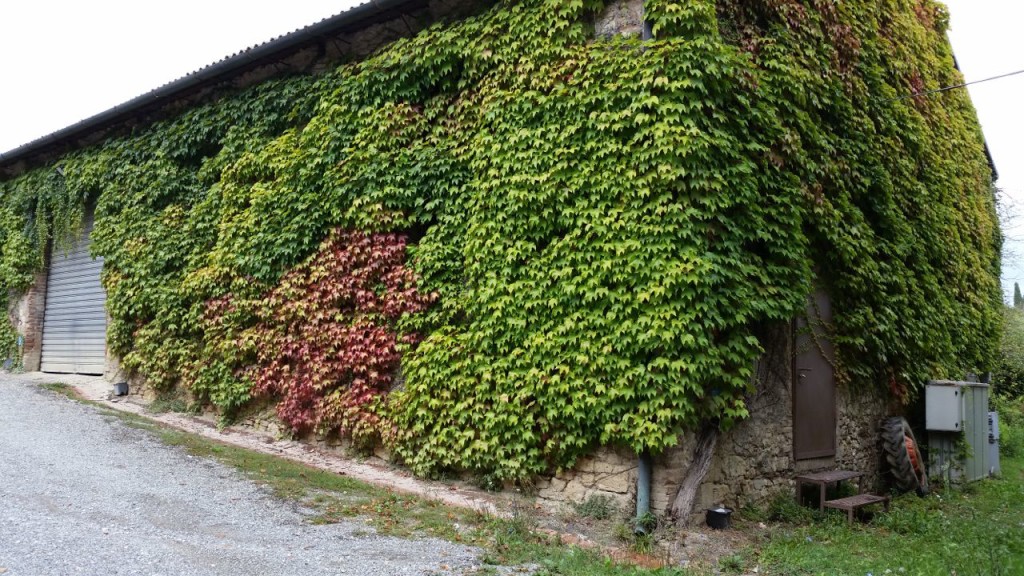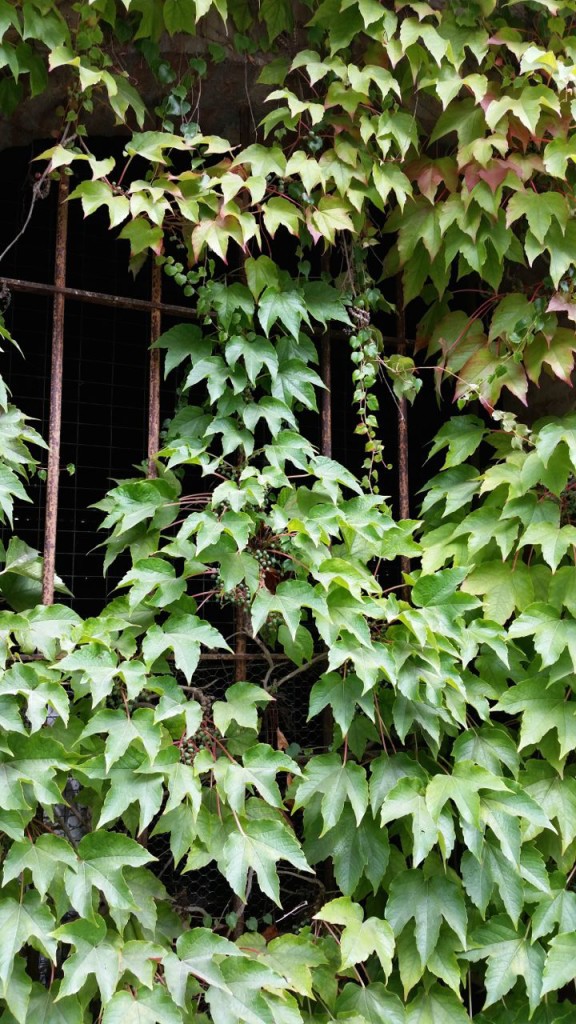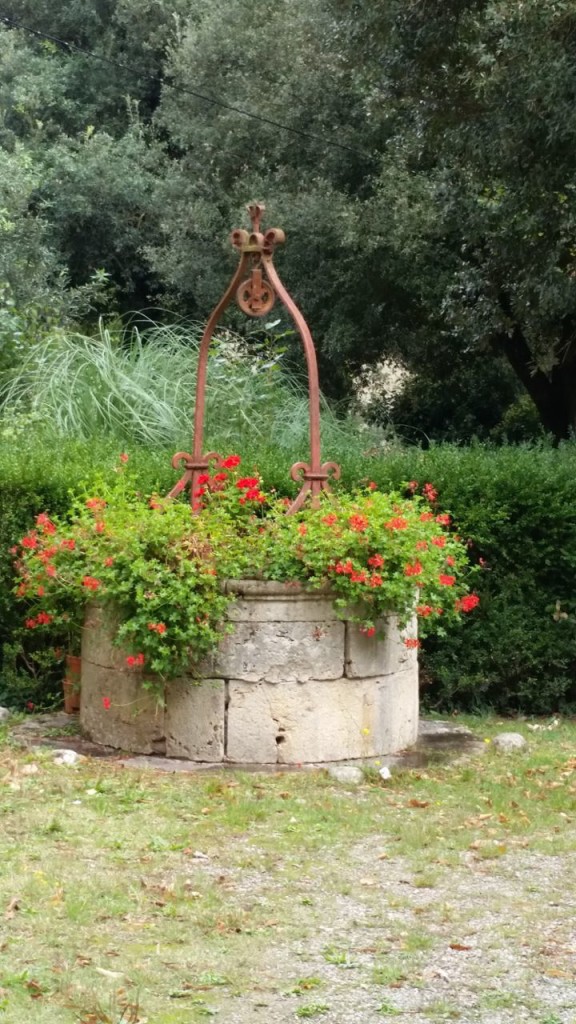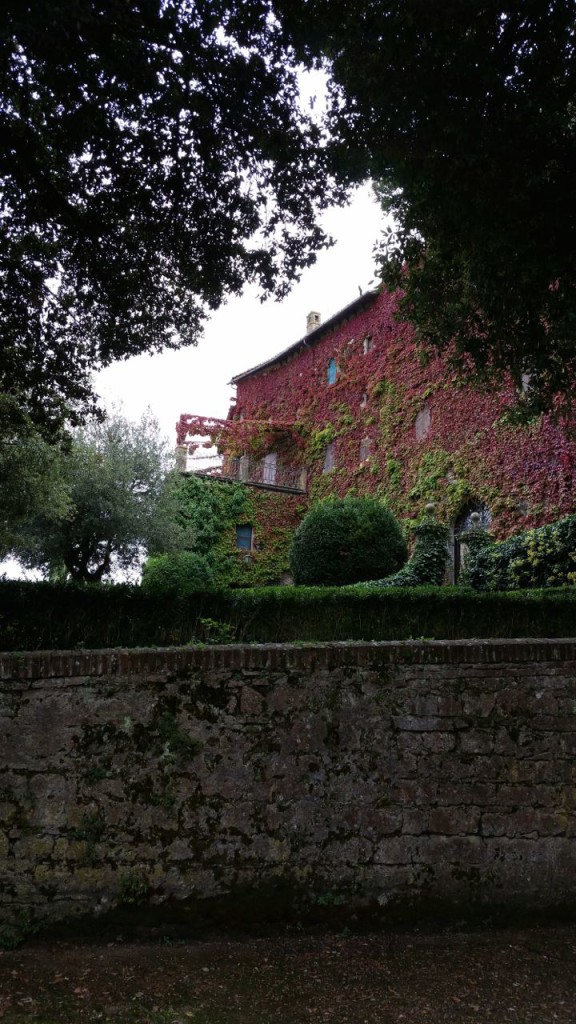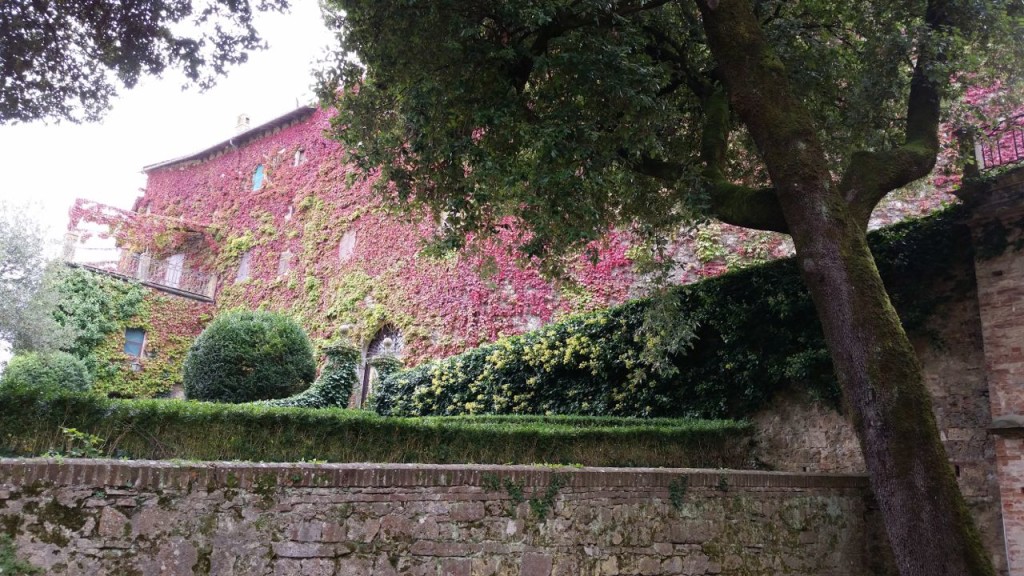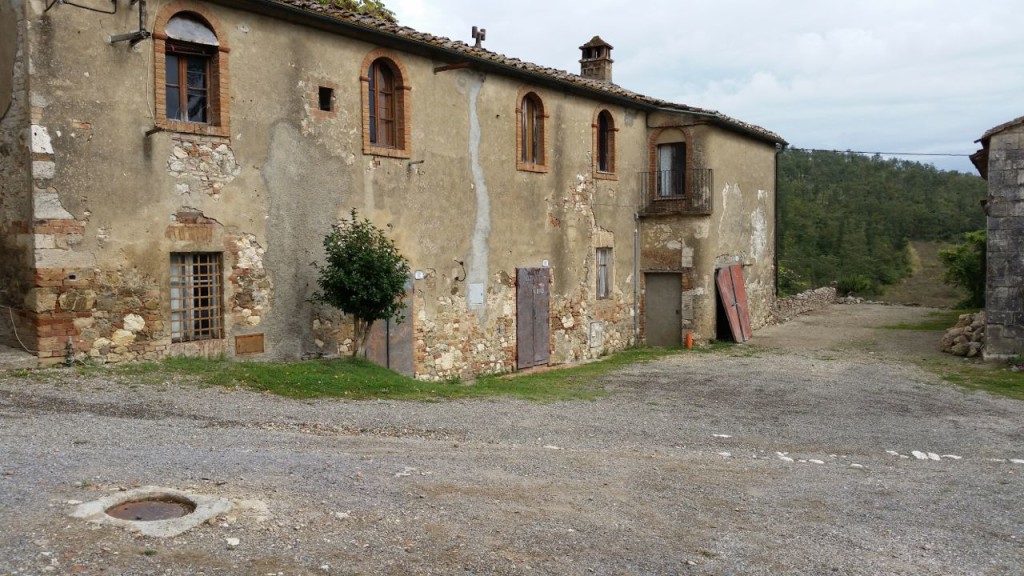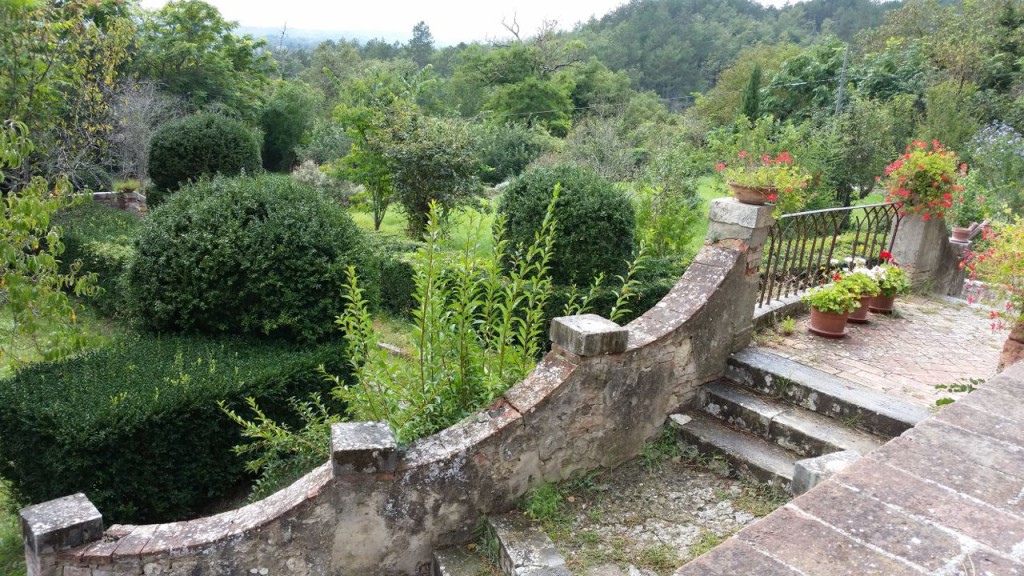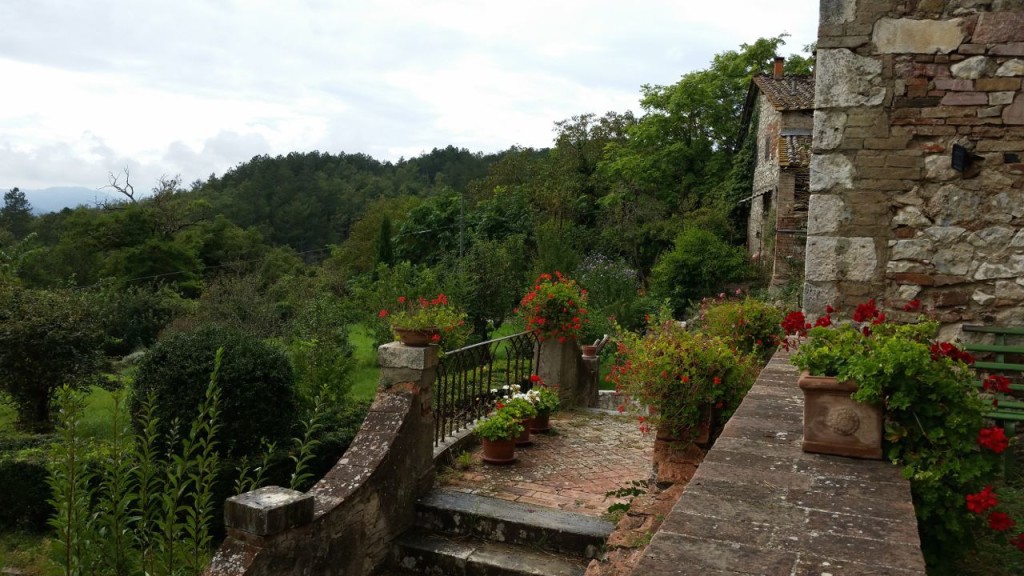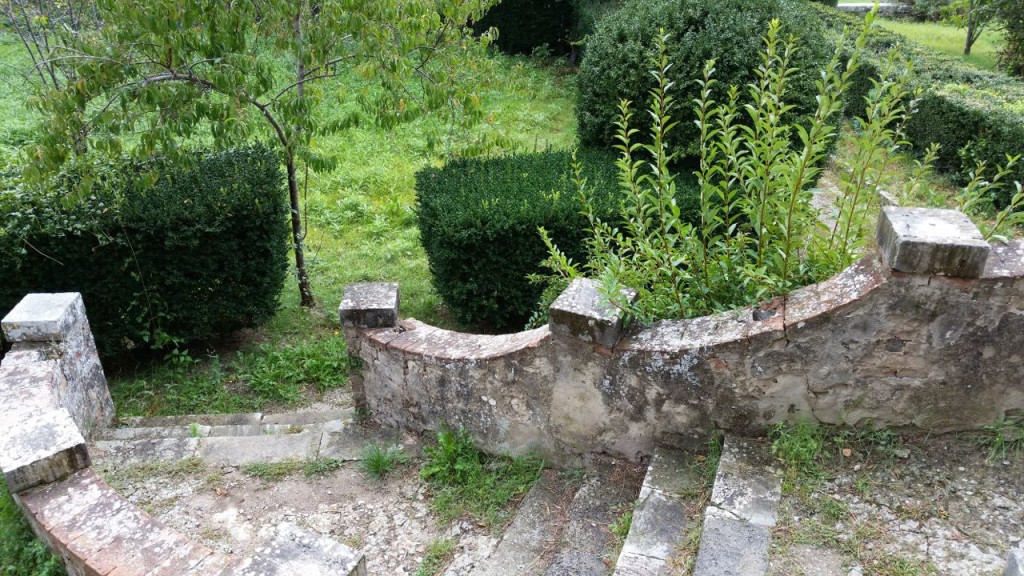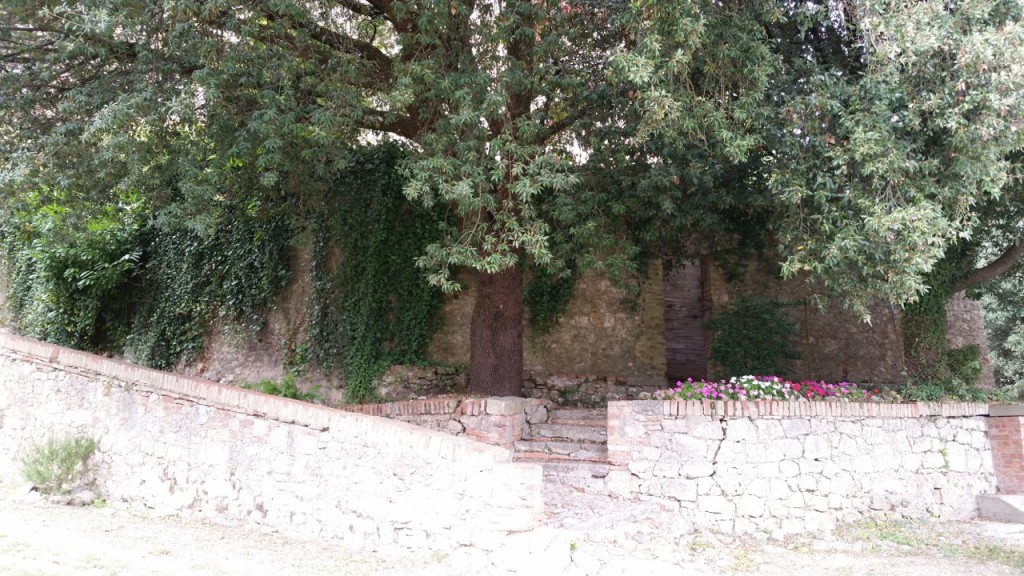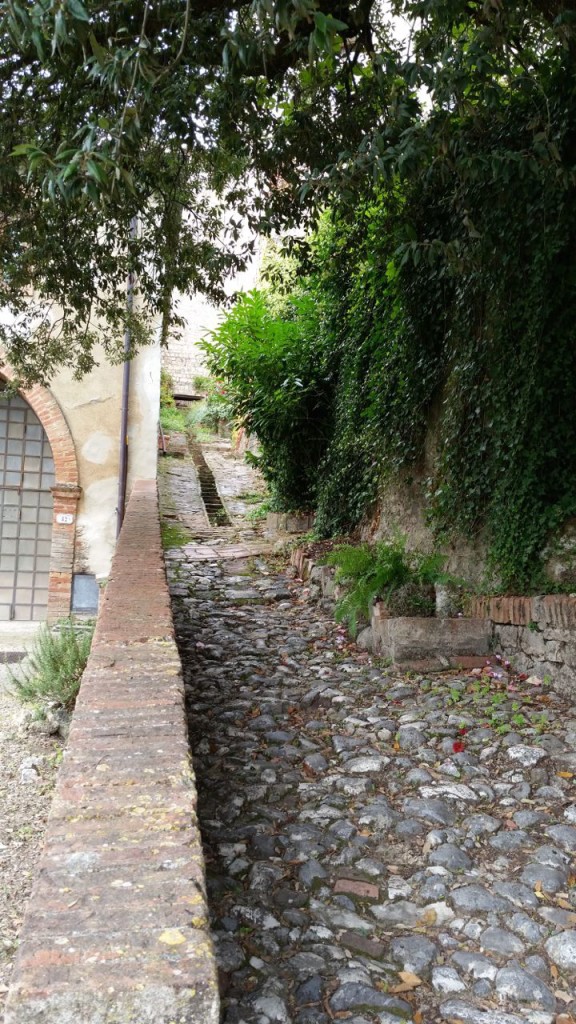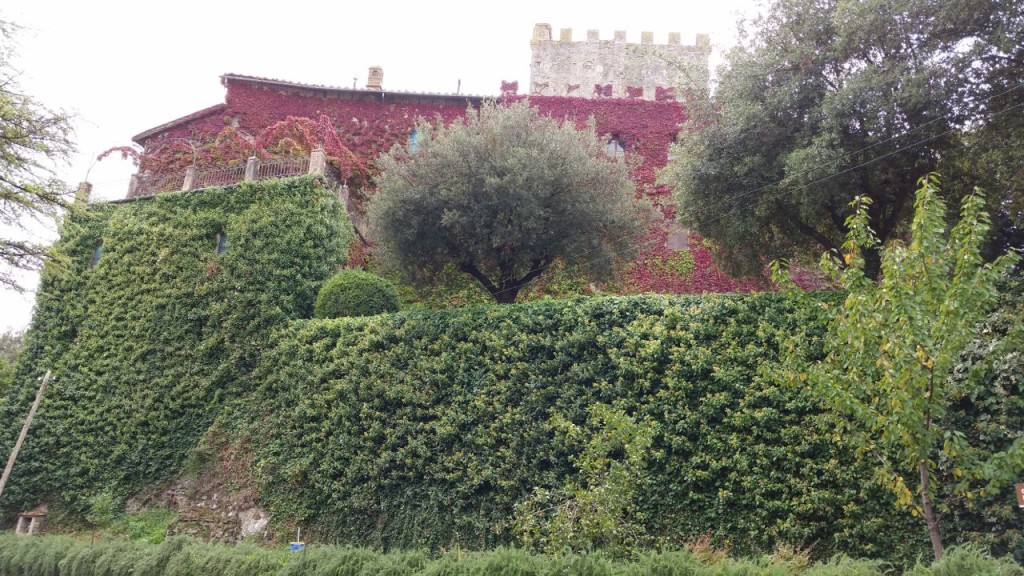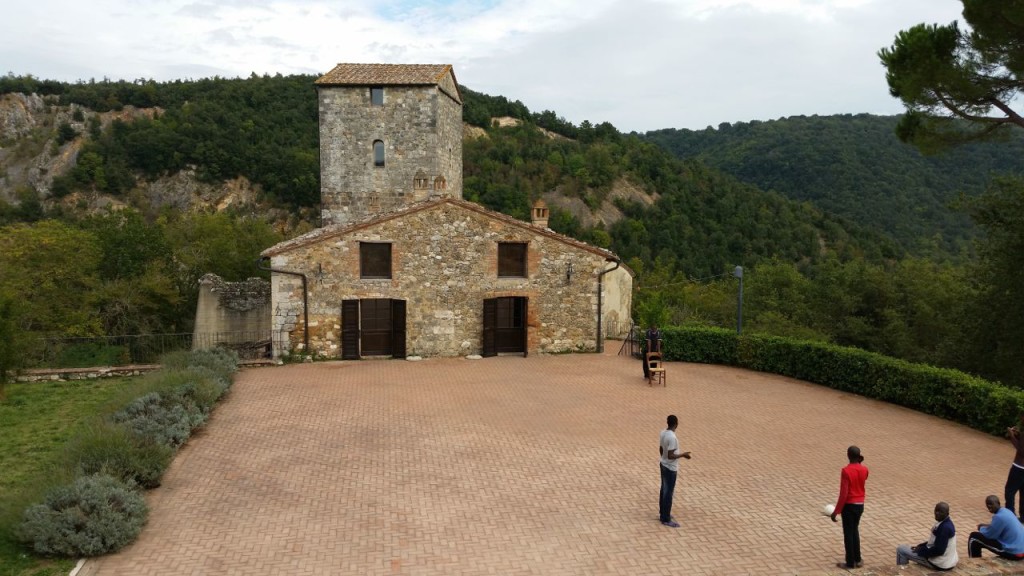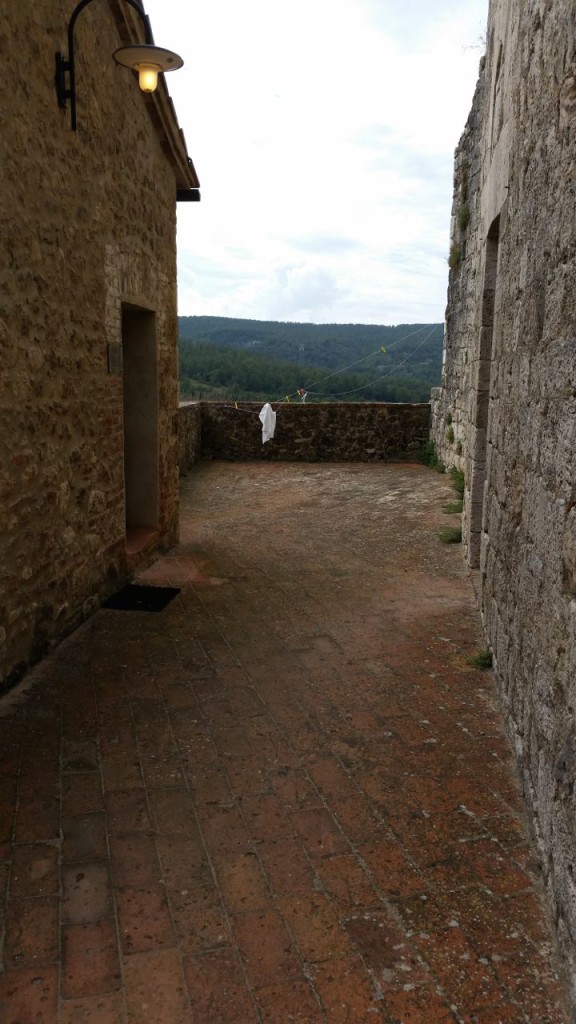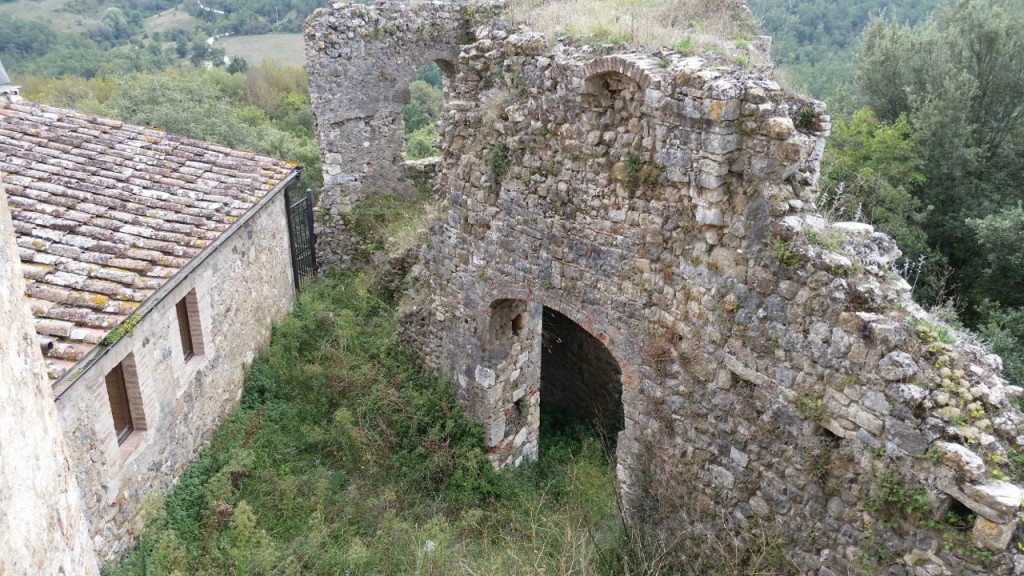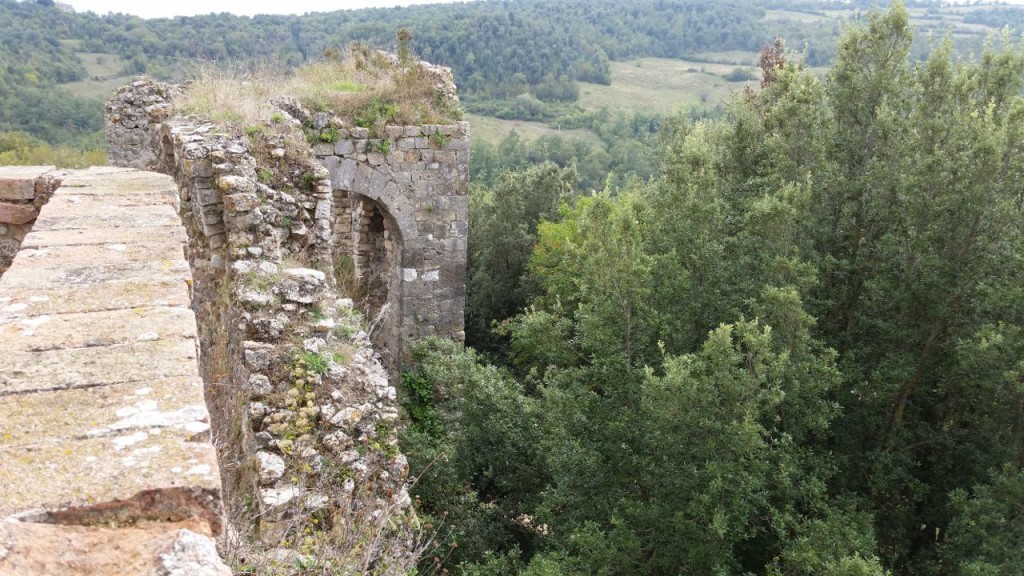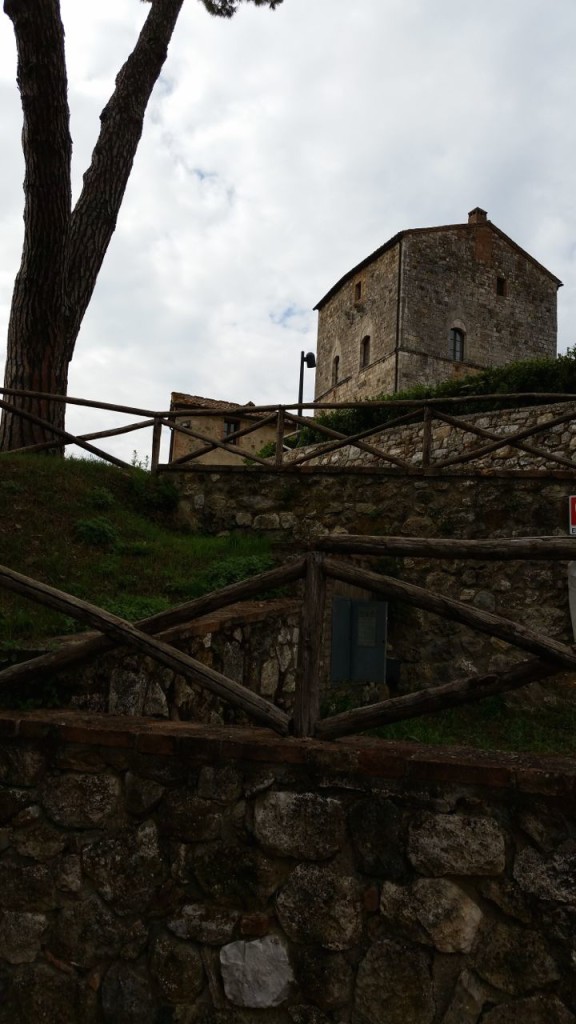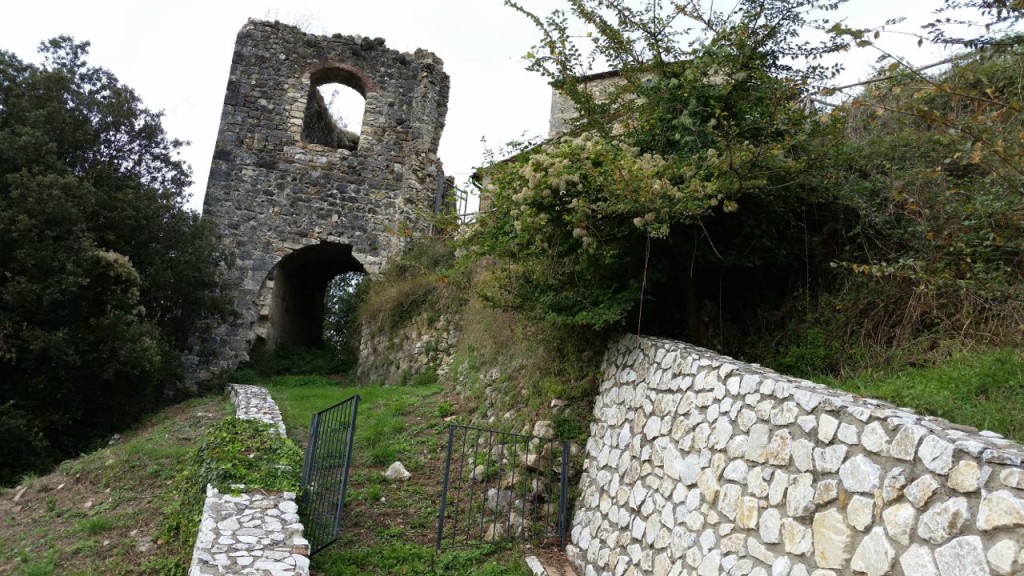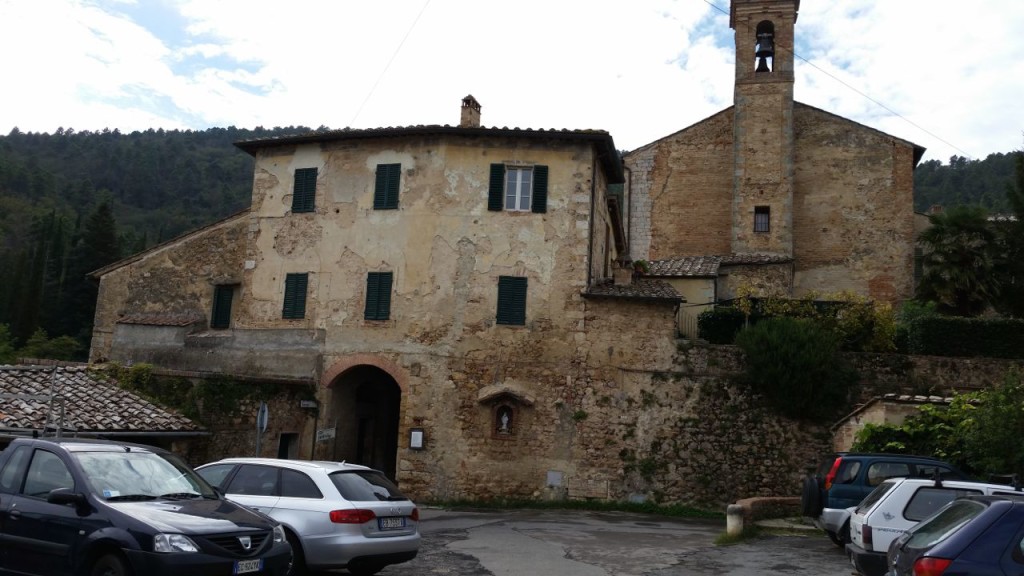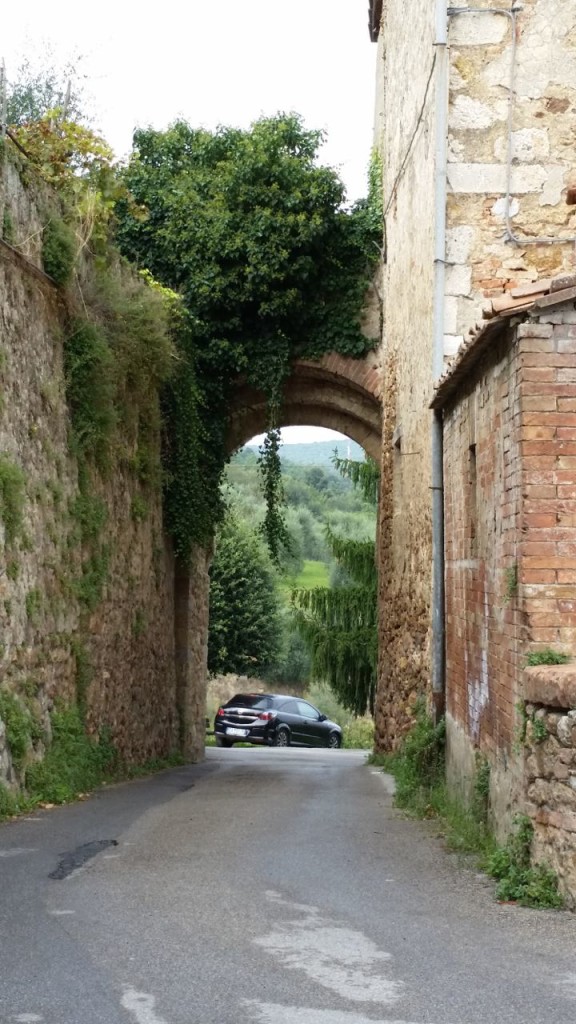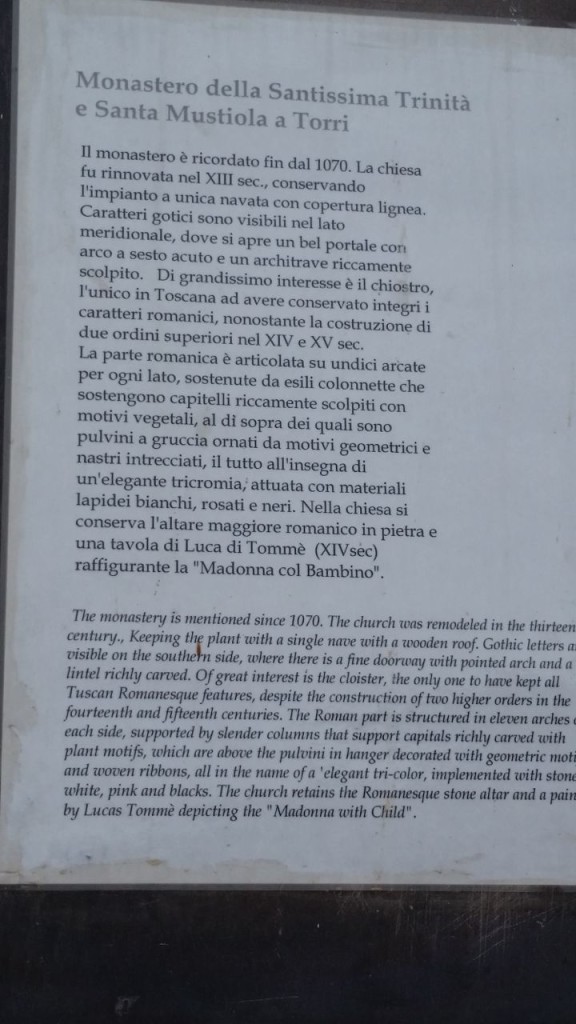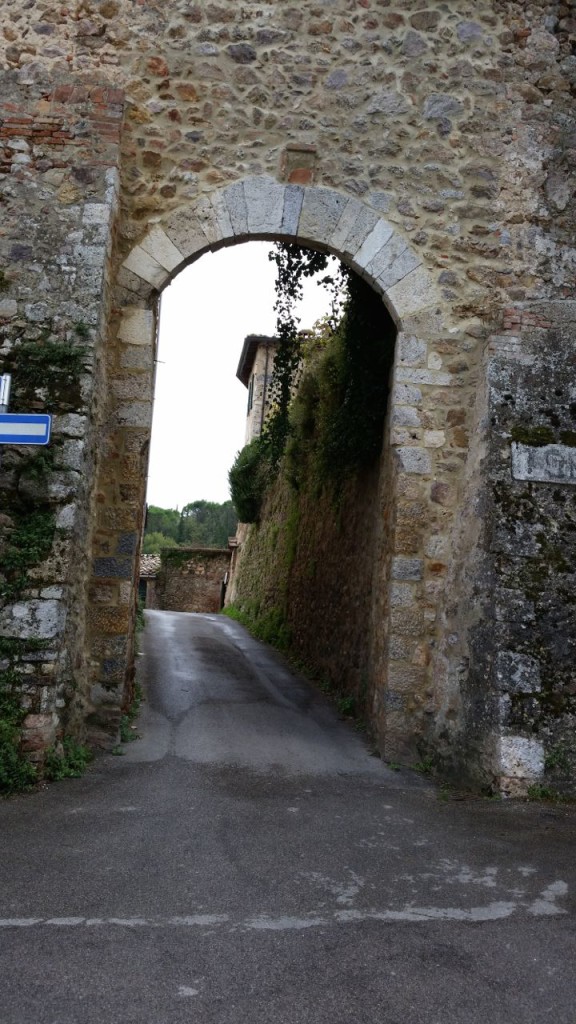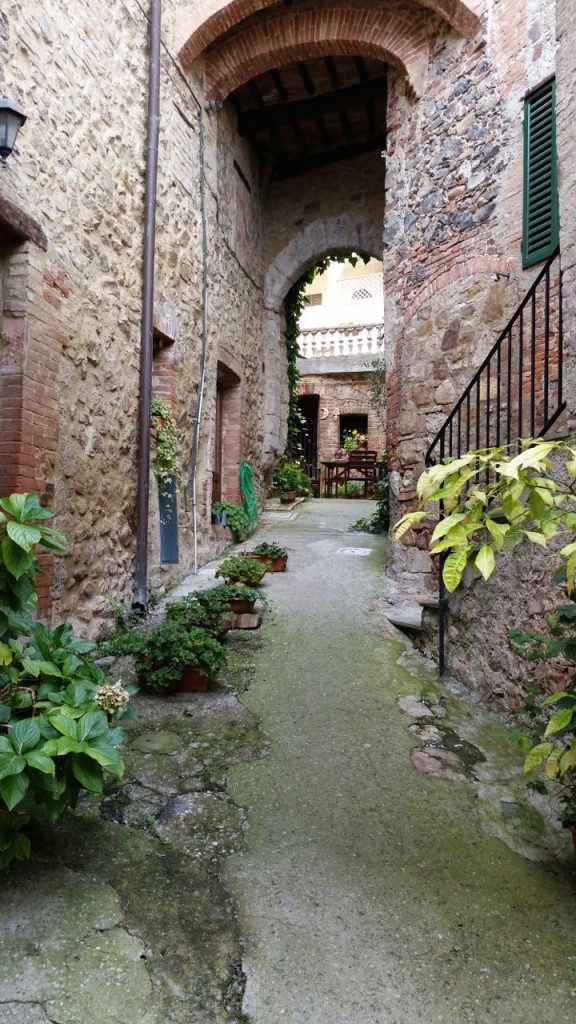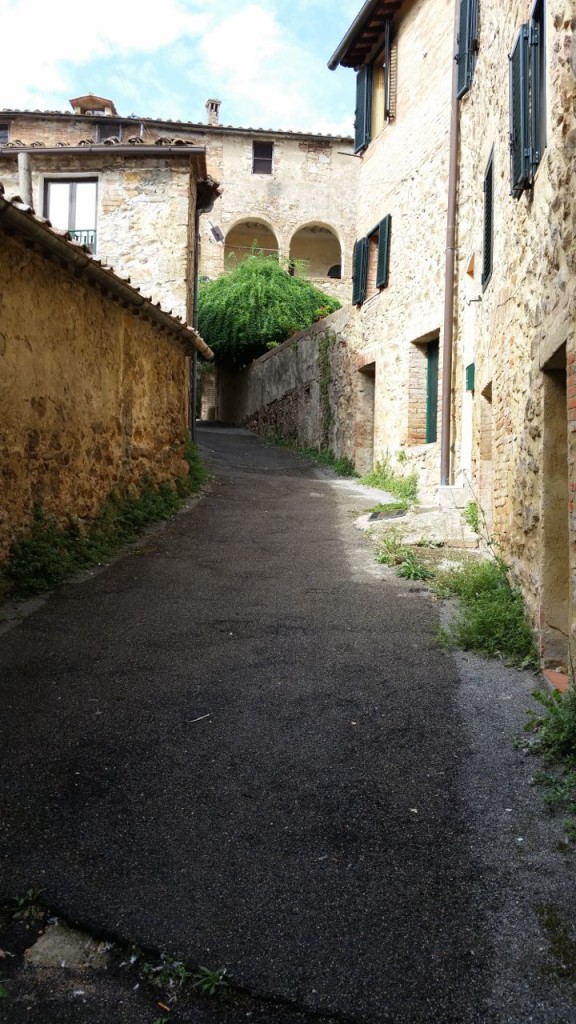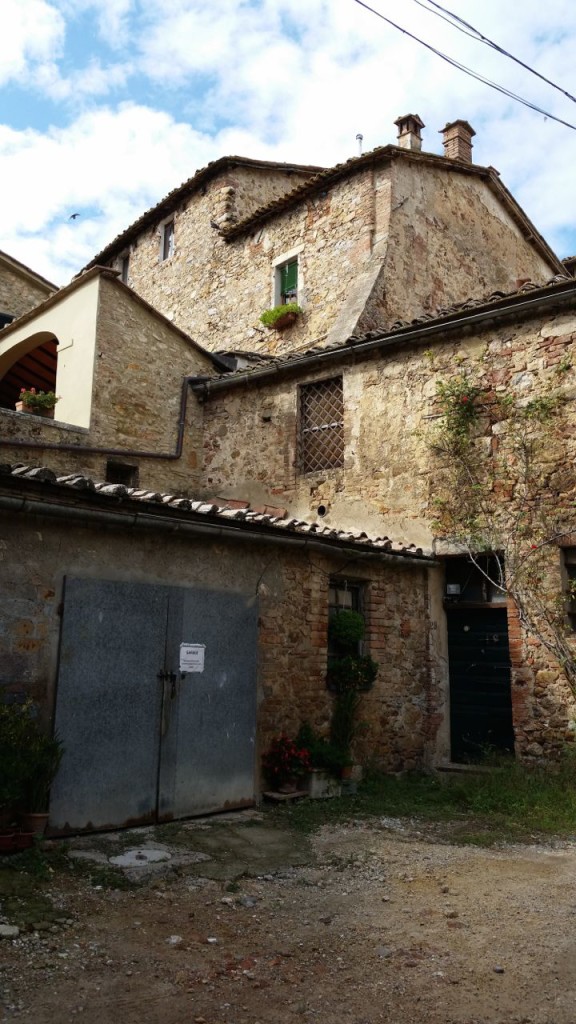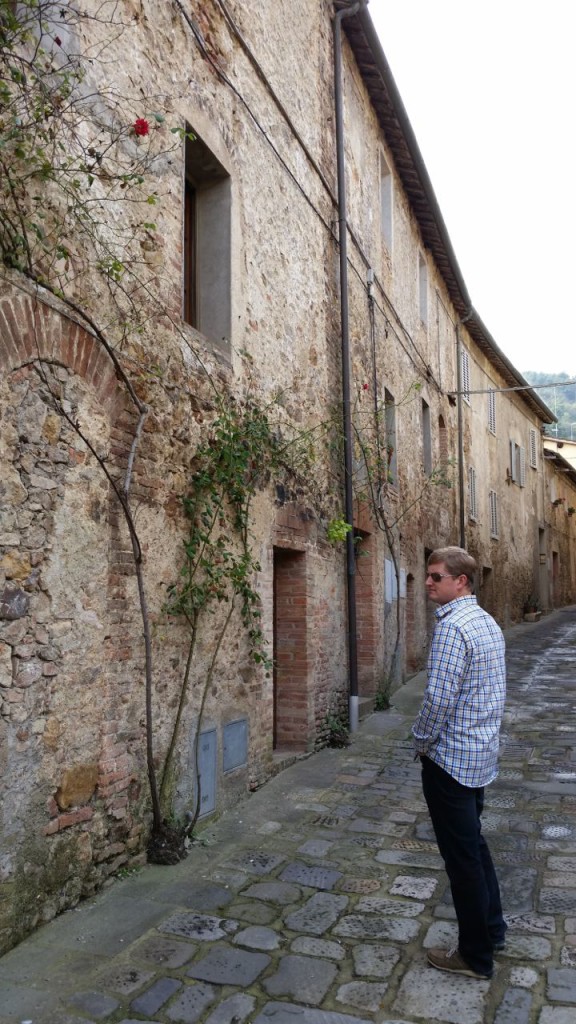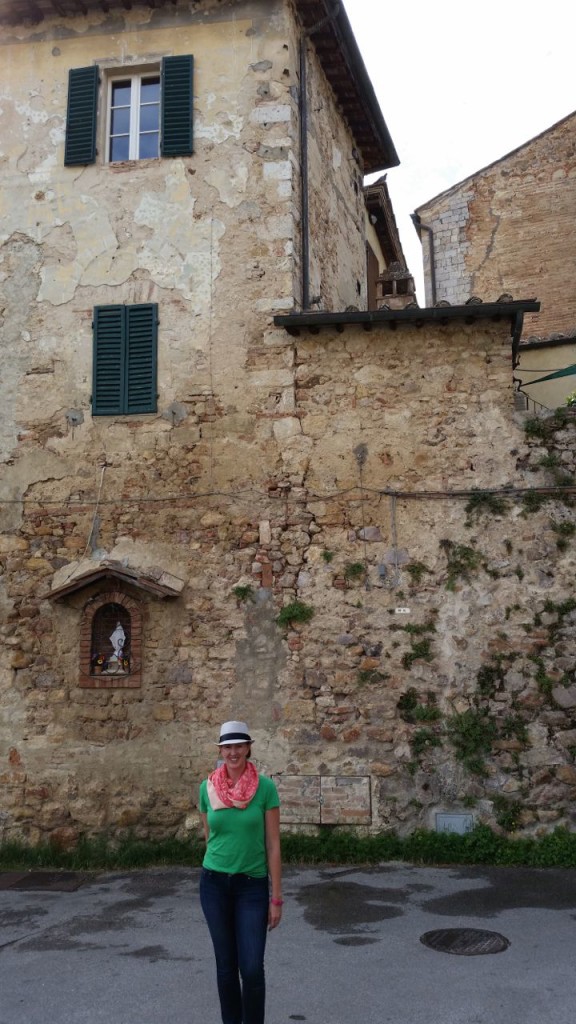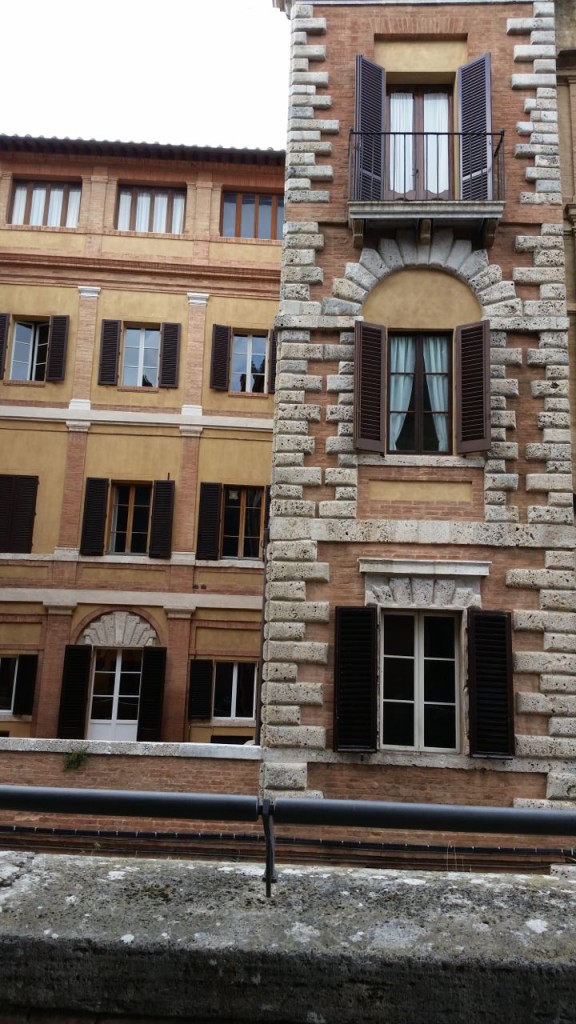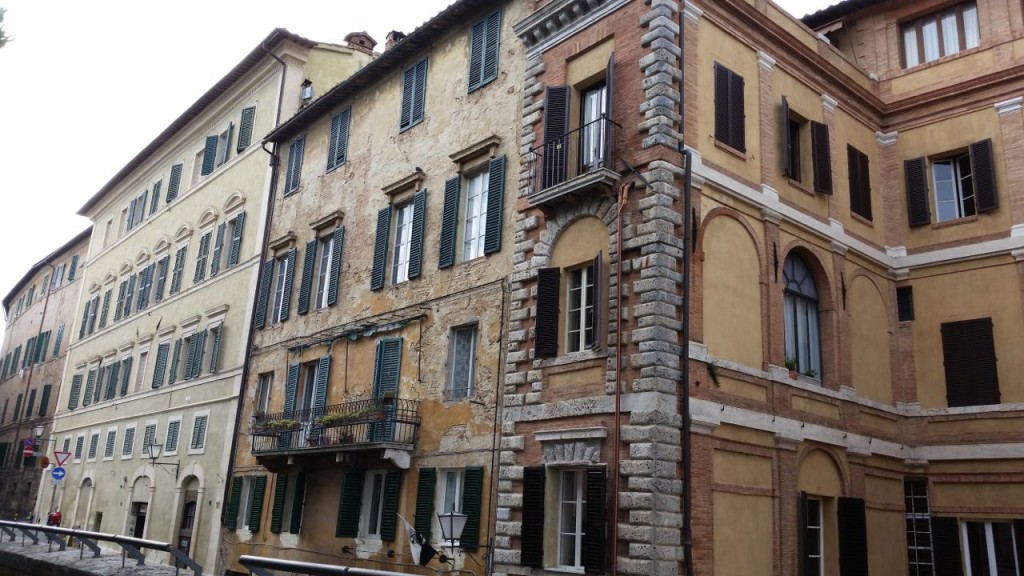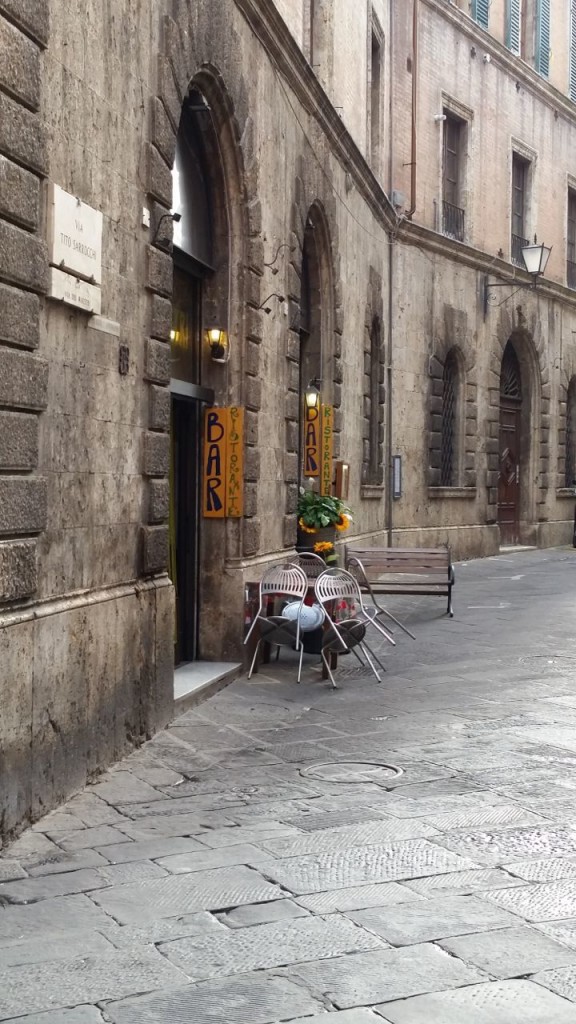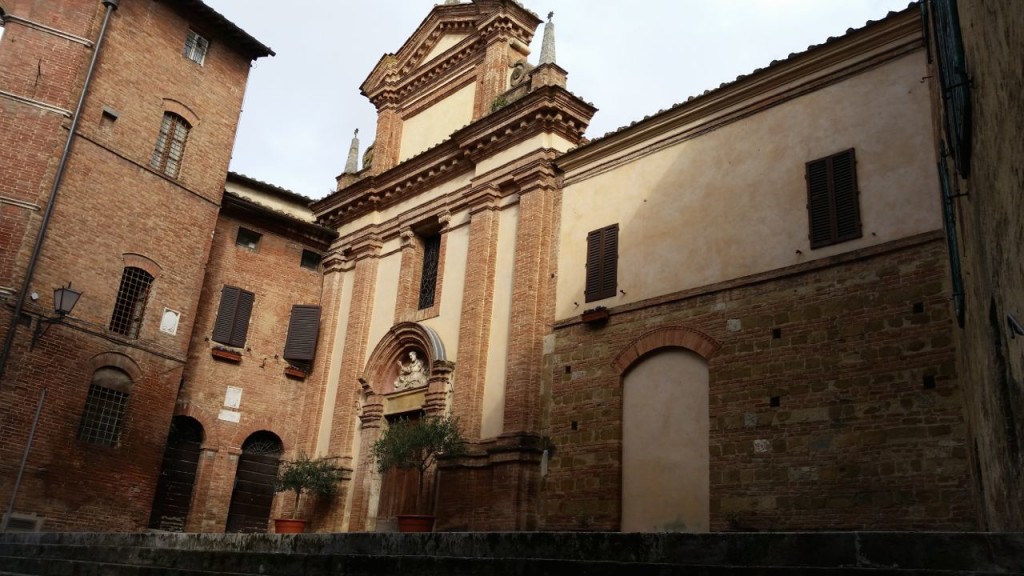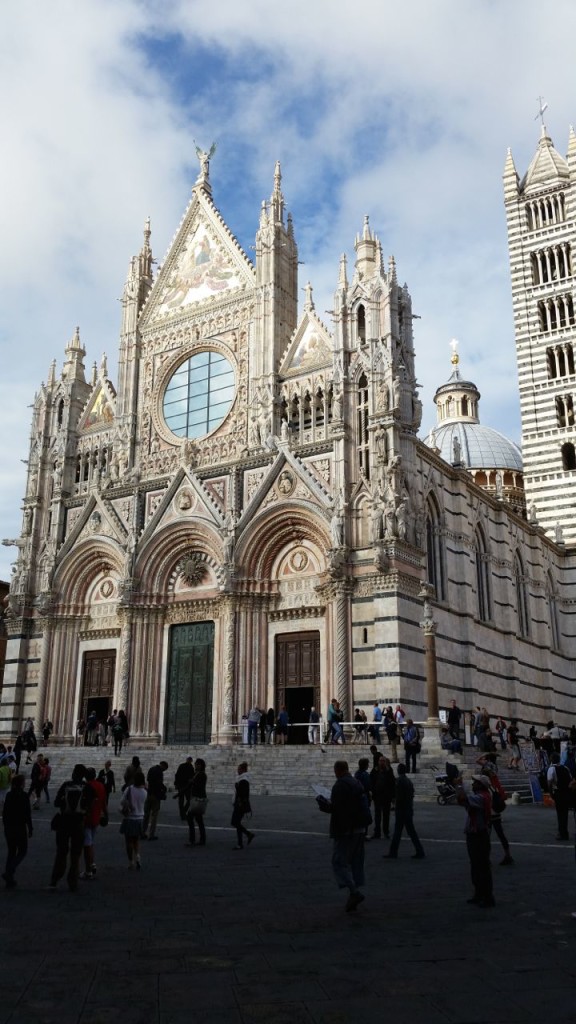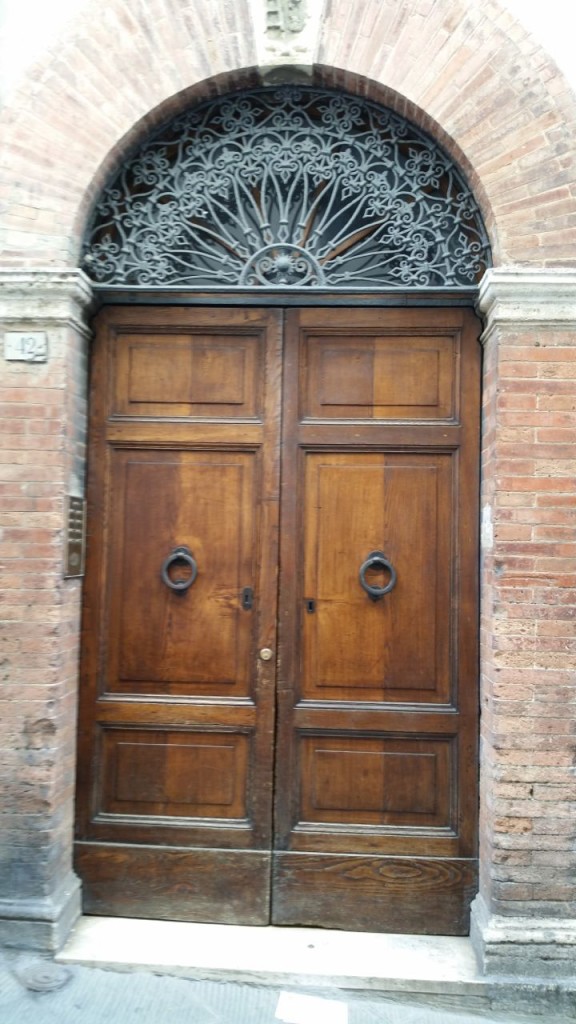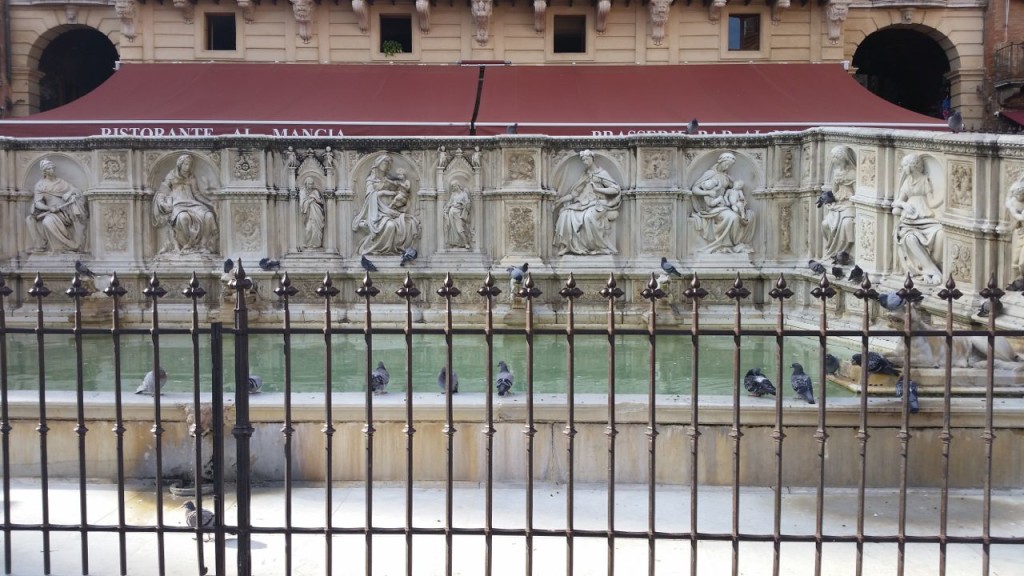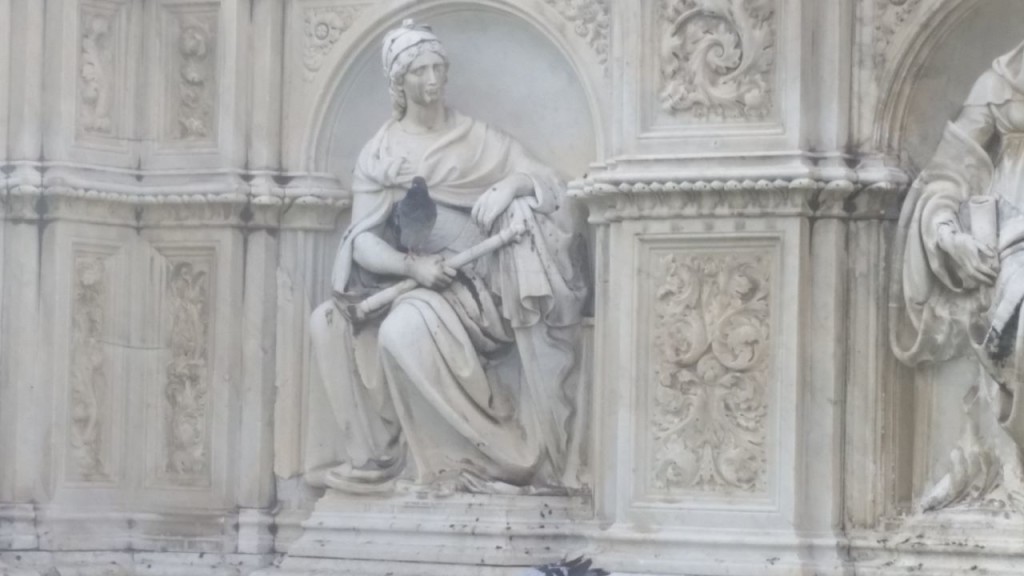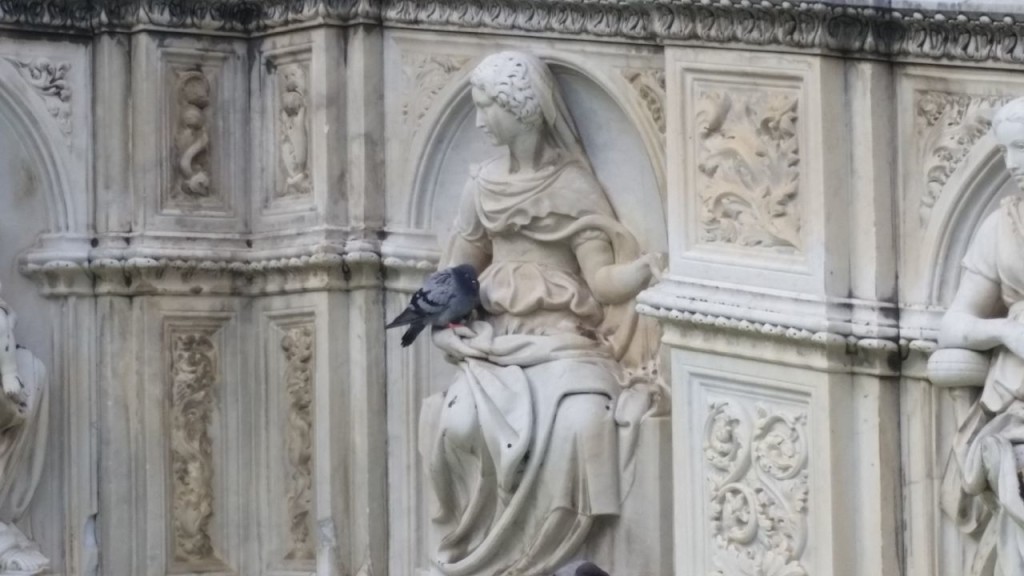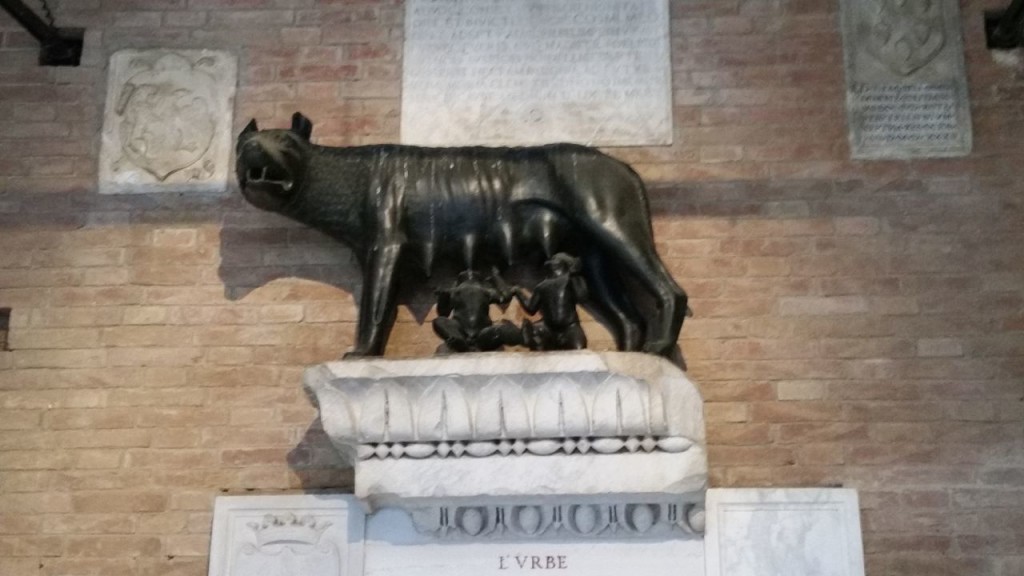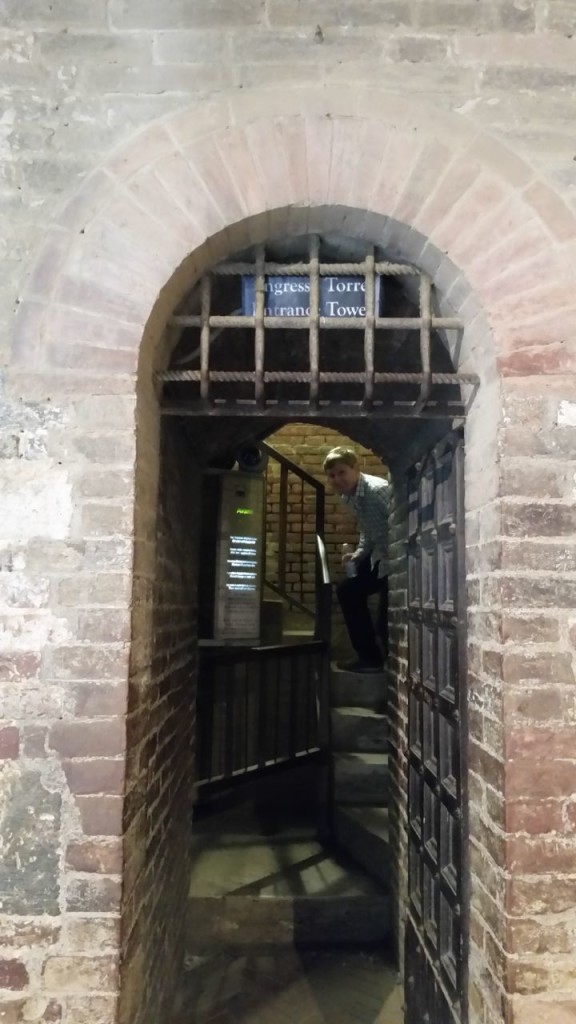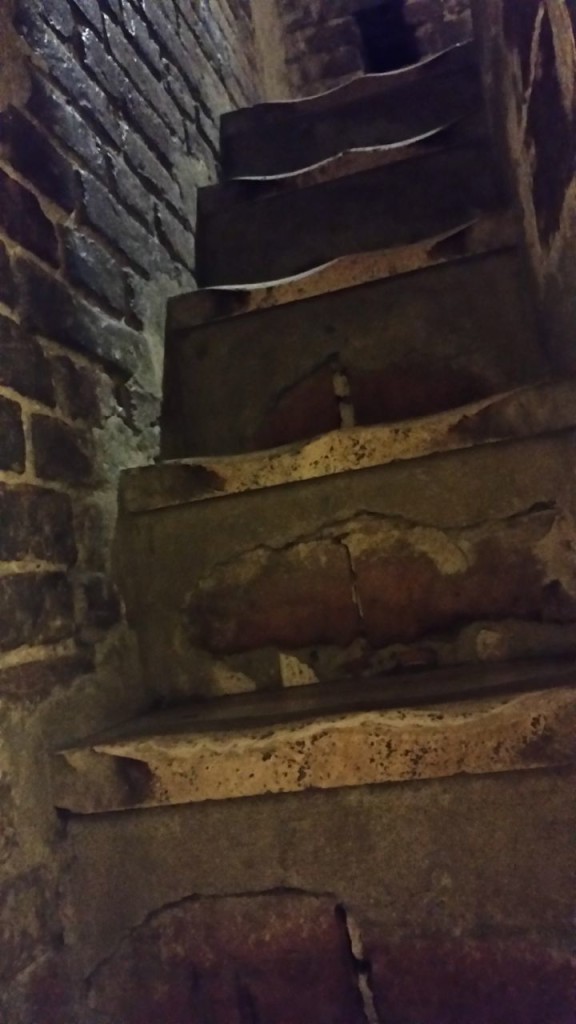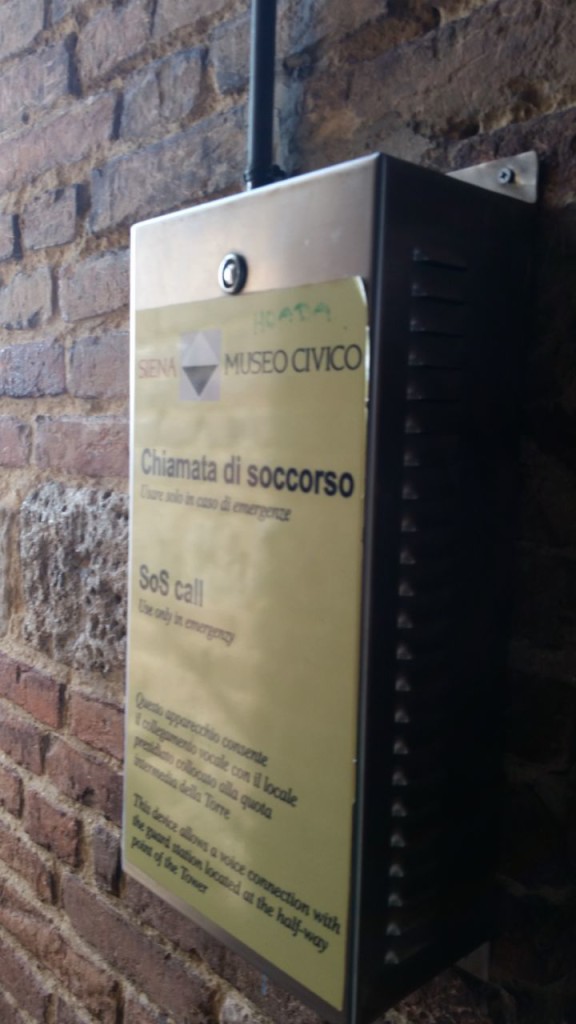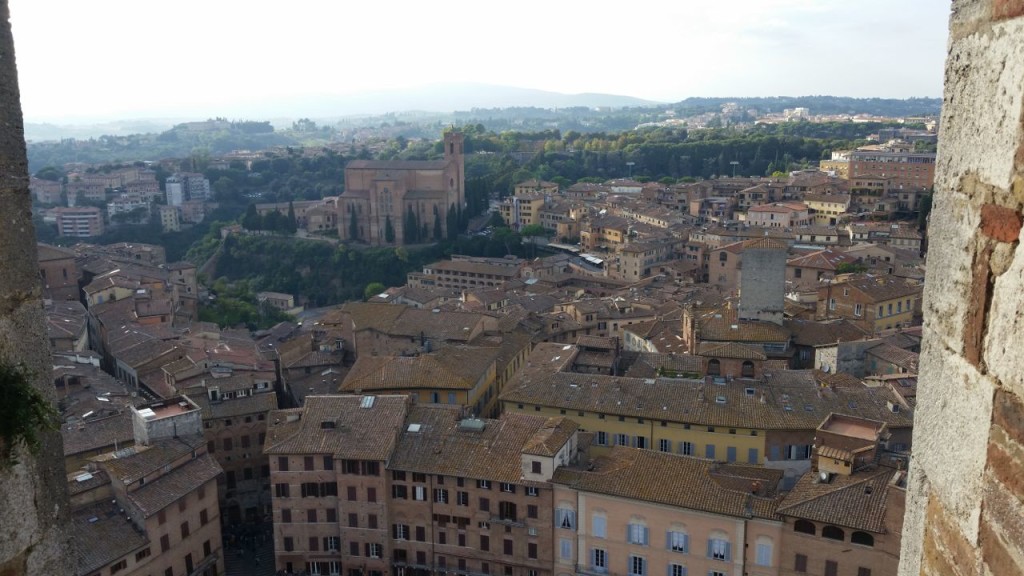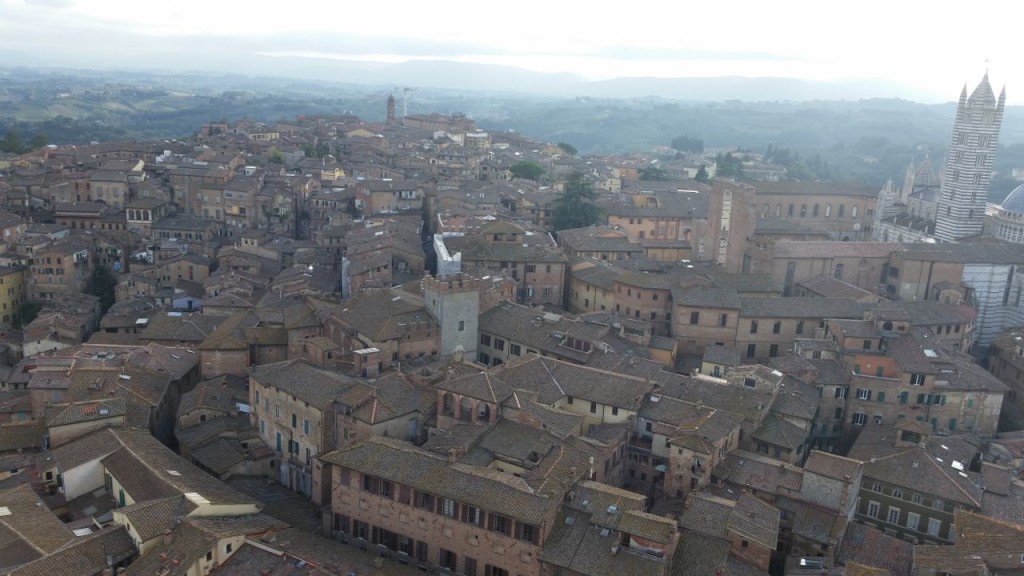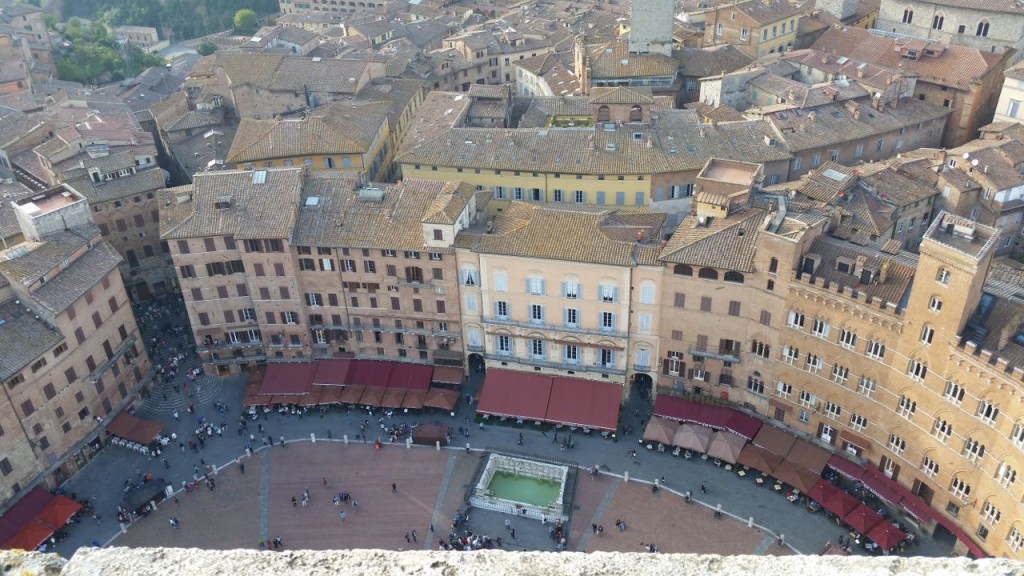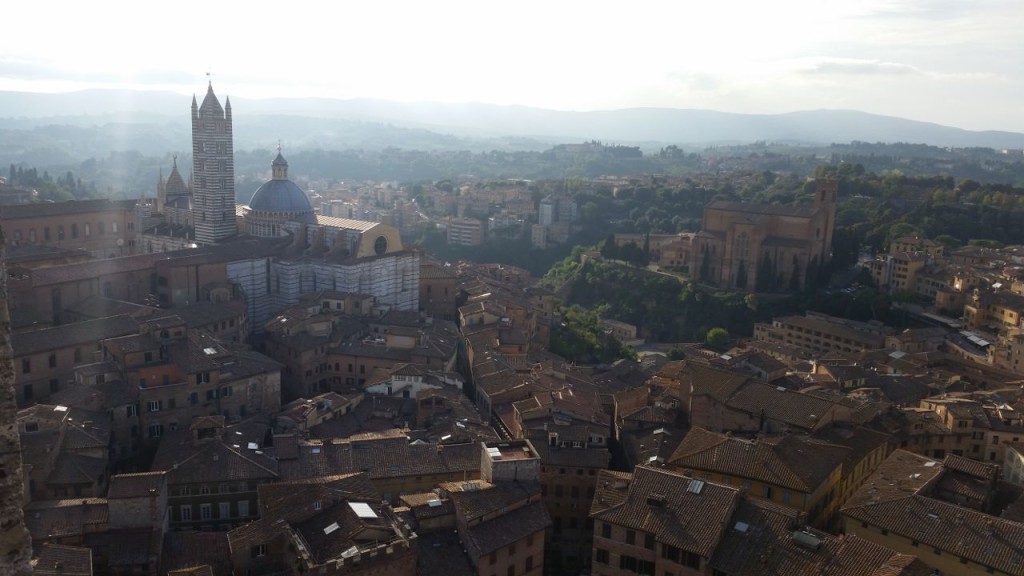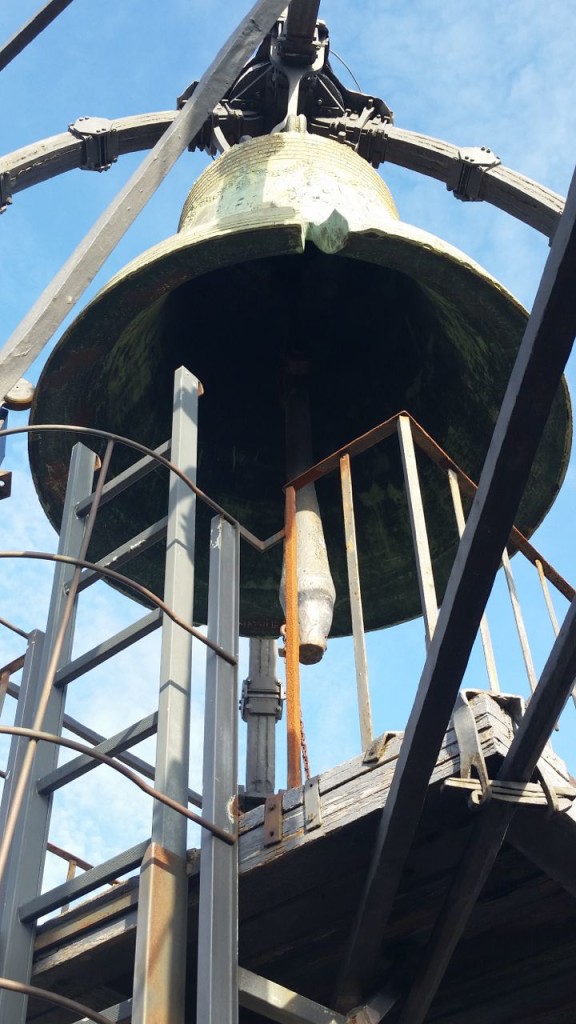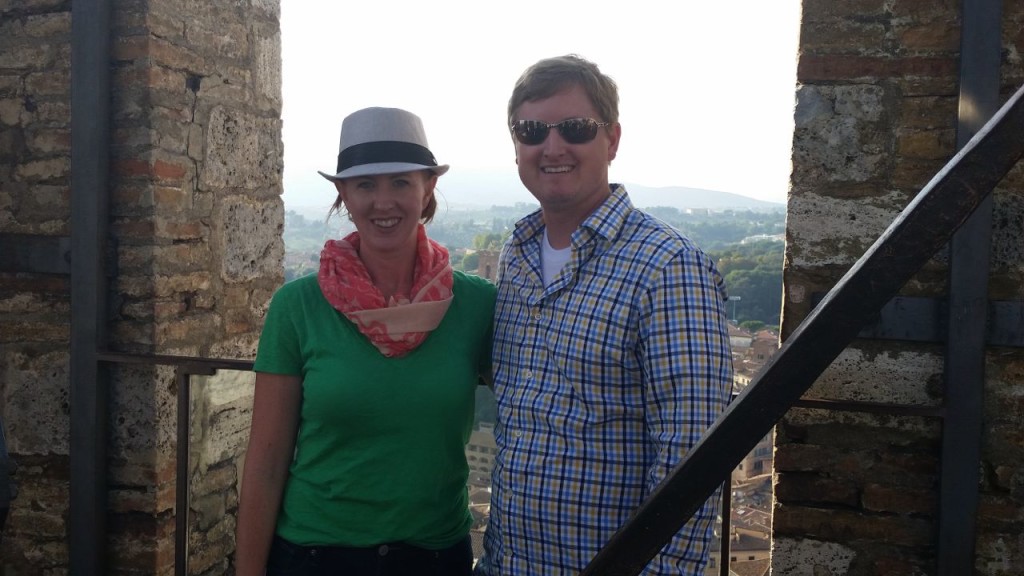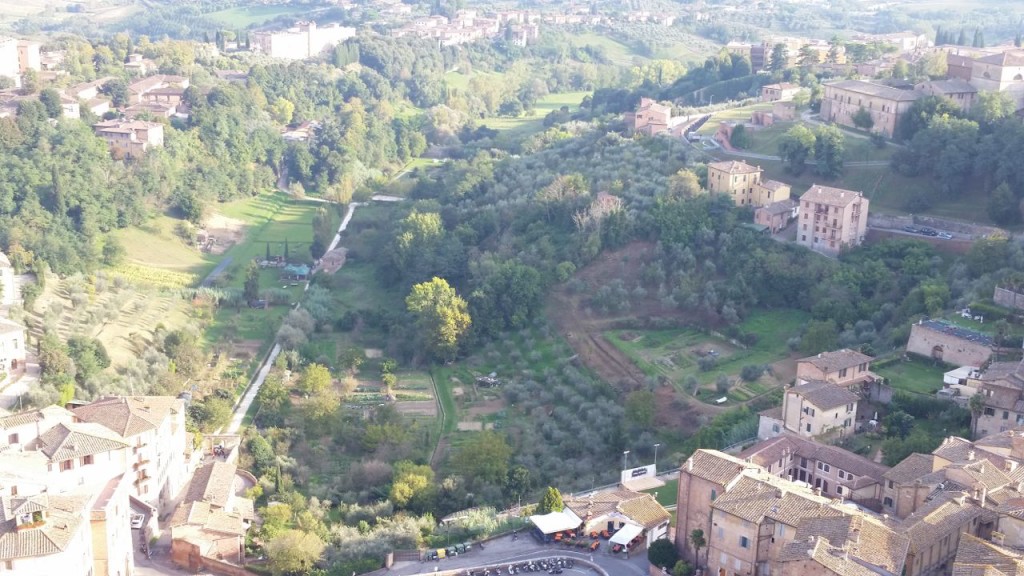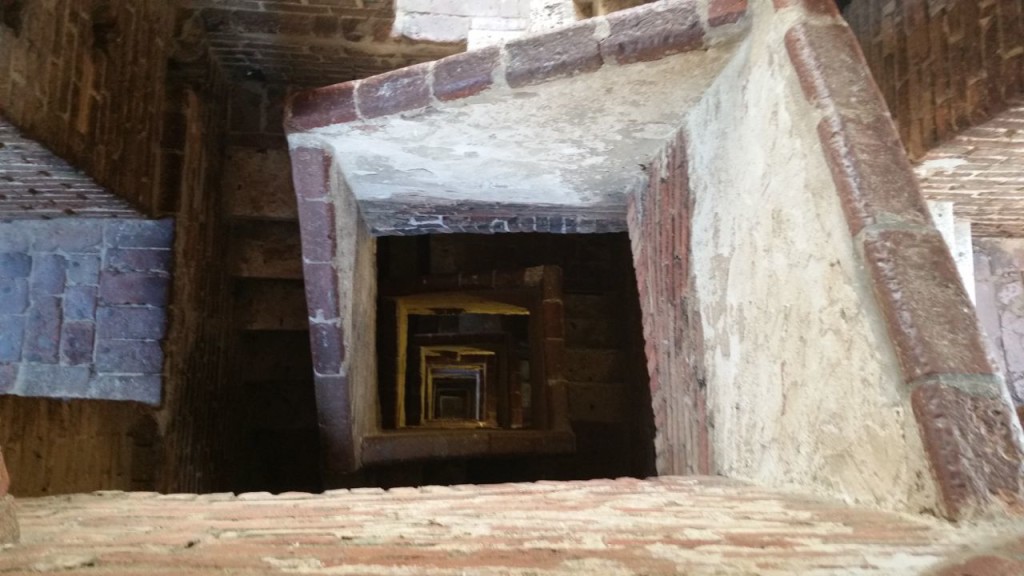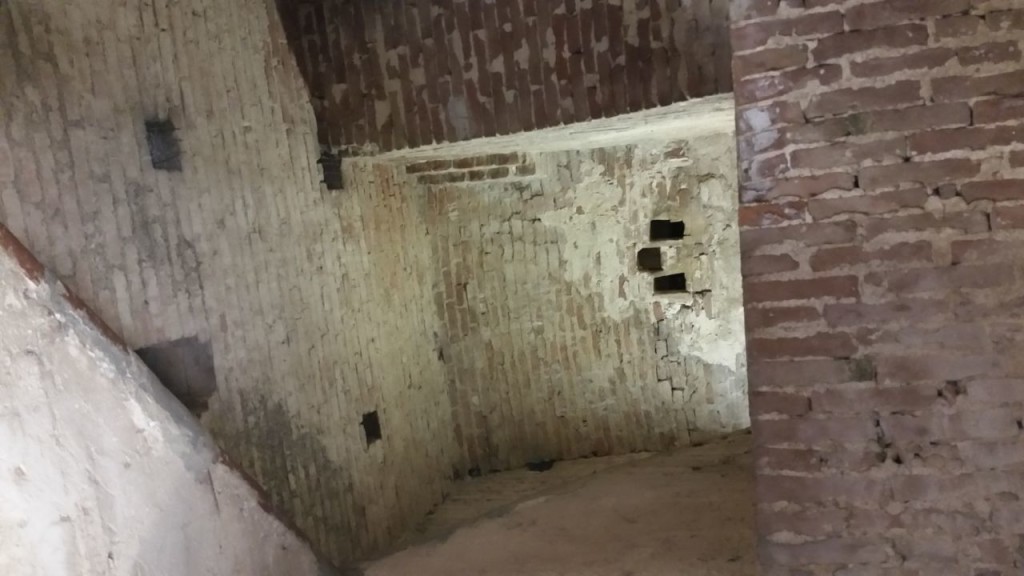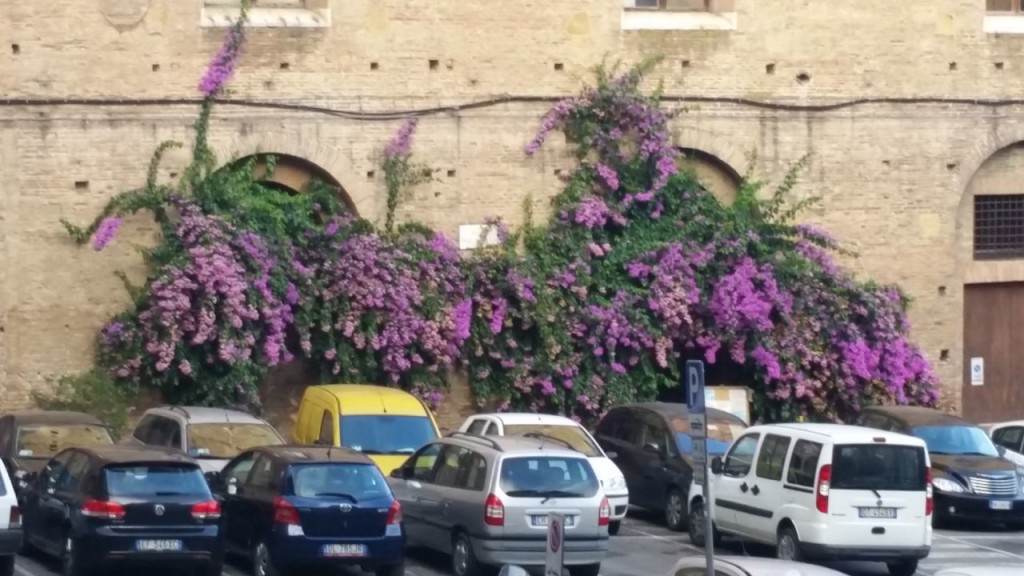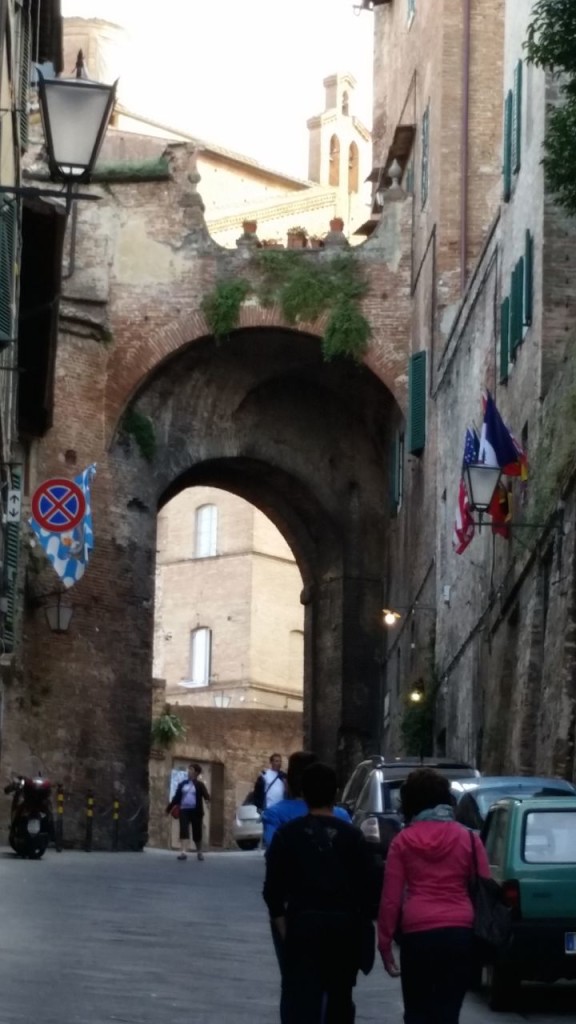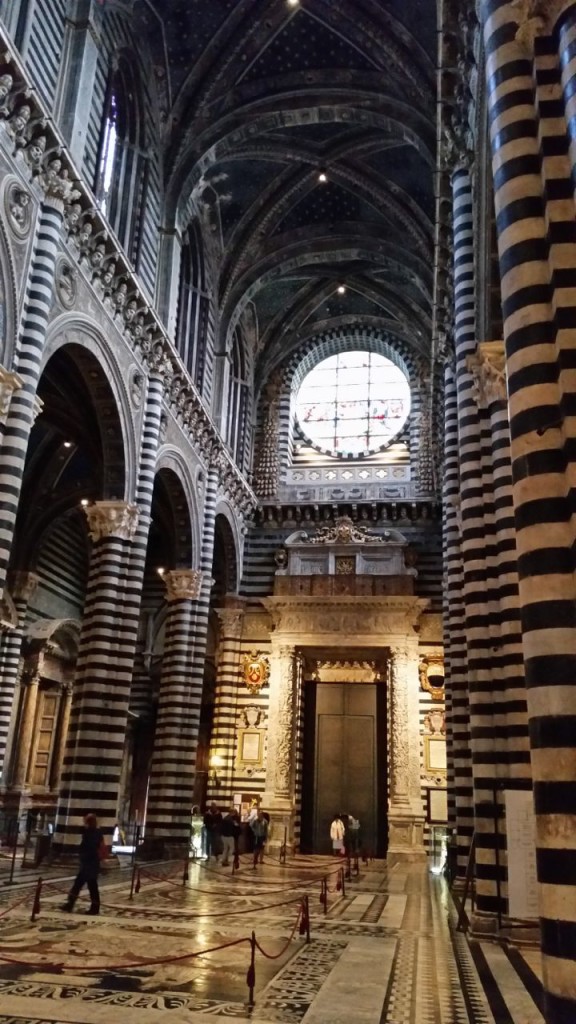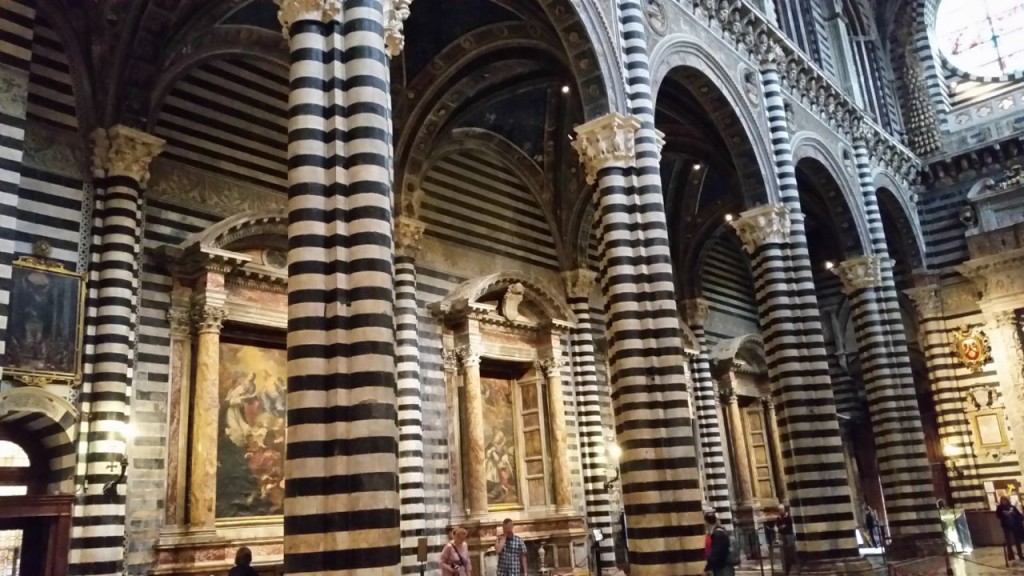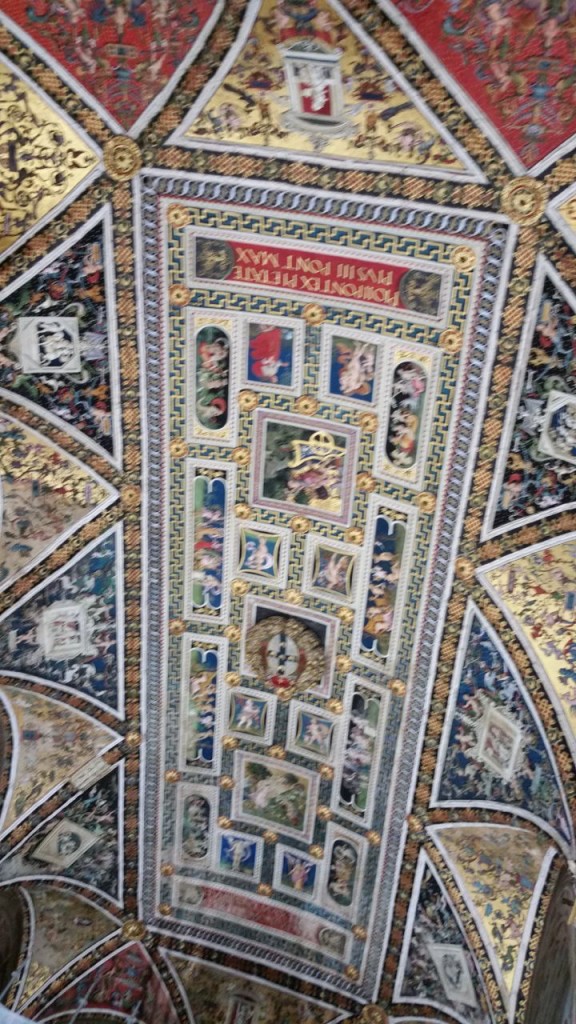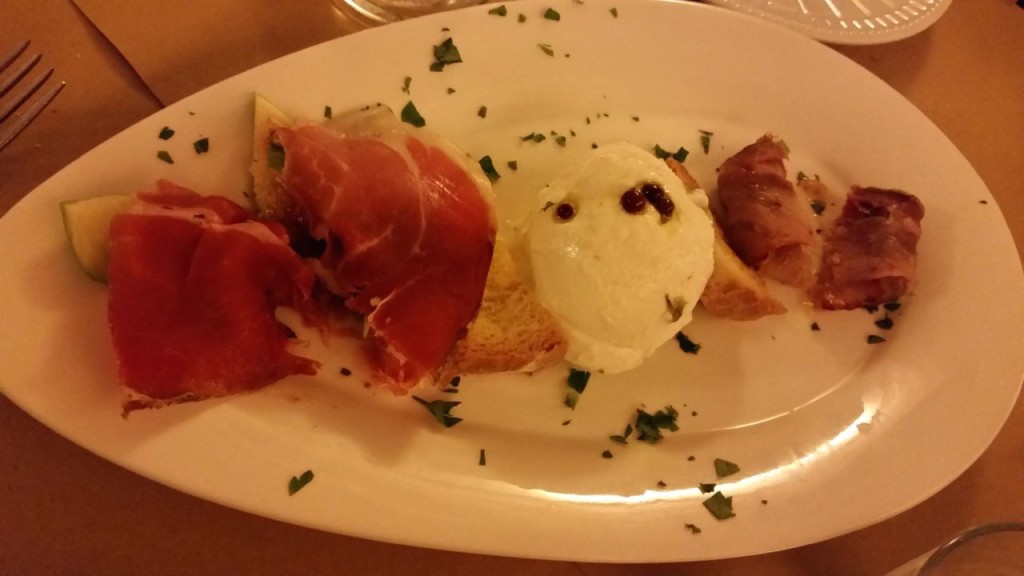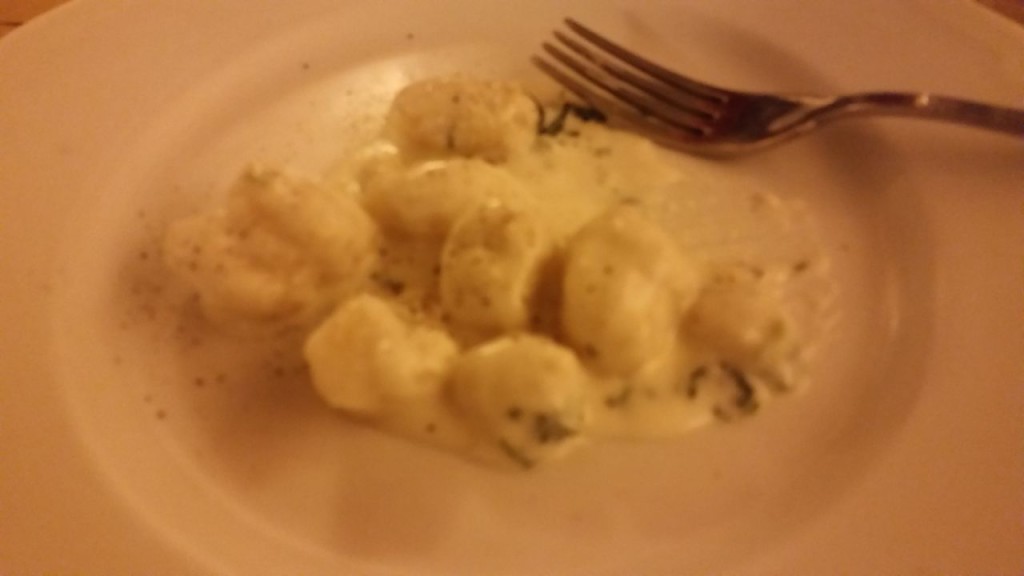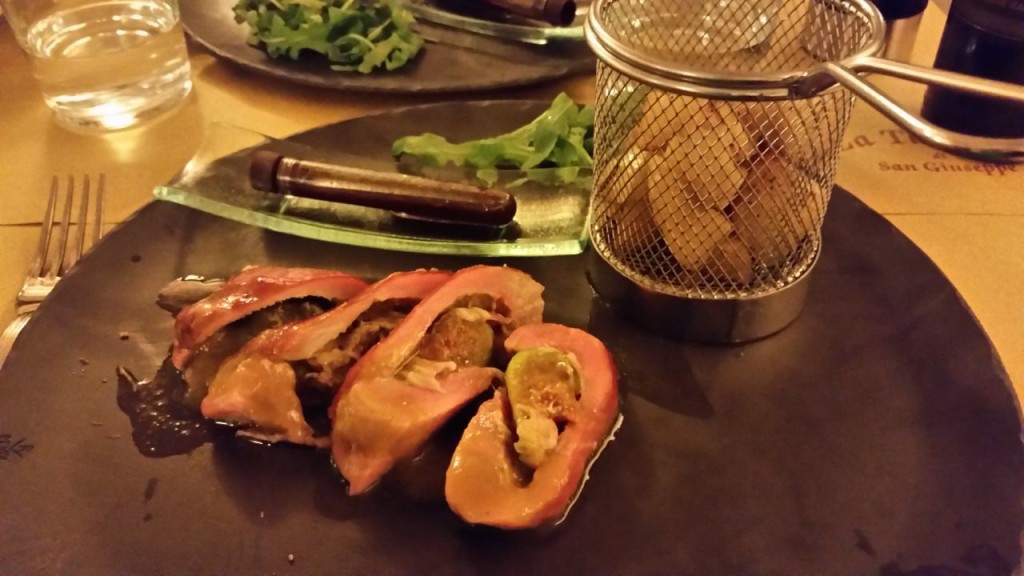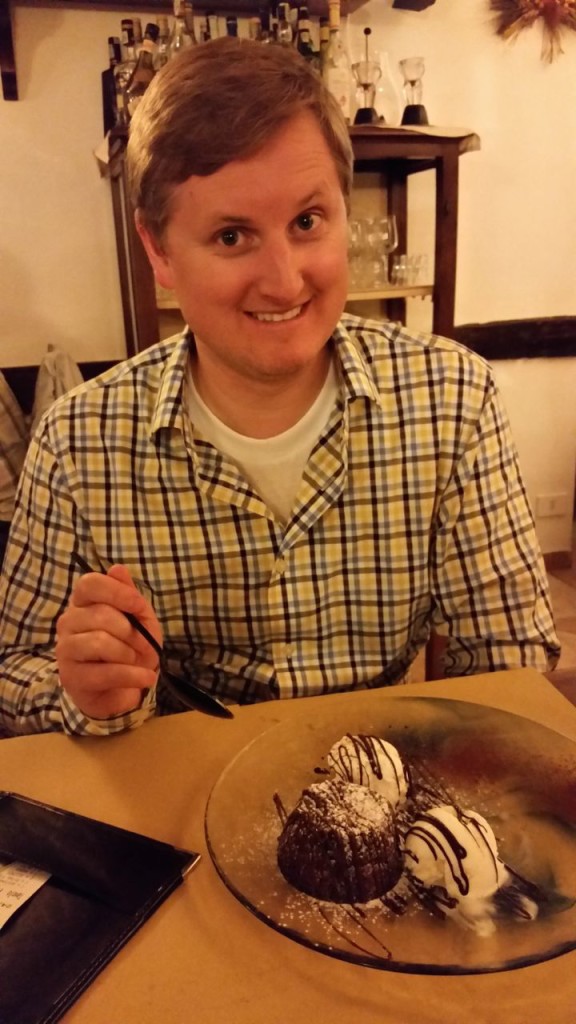After Pisa we drove on to Tuscany, which was the part of the trip I was looking forward to the most. Because I’m a gardener, small-scale homesteader, foodie, organic crunchy mama, flower lover and intensely interested in traditional food and living, I couldn’t wait to see how they did it in Tuscany.
Everything in Tuscany is beautiful. It is just as beautiful in person as it is in the pictures.
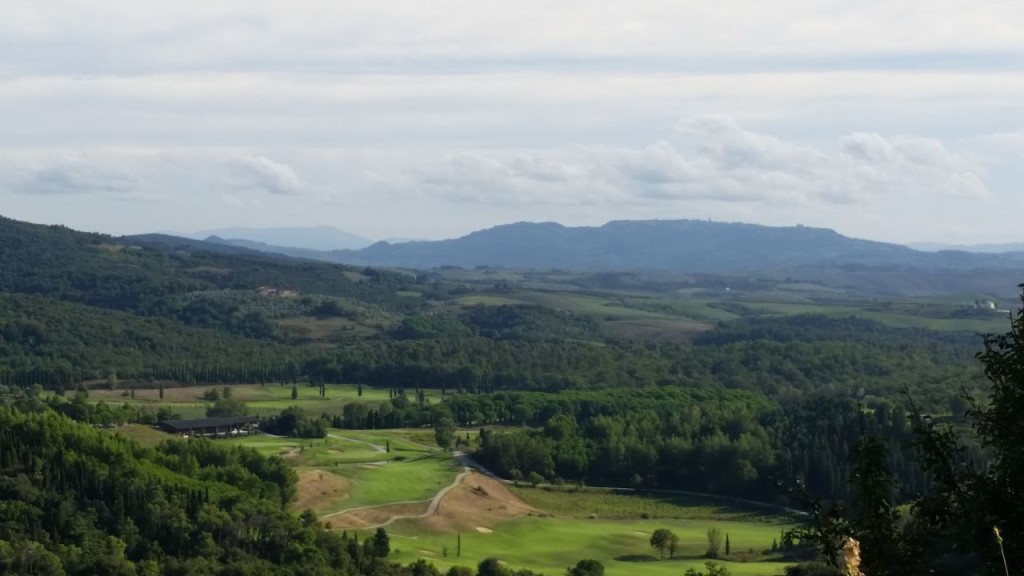
Sometimes that beautiful place you saw in that incredible photo was clearly taken at just the right moment from just the right angle.
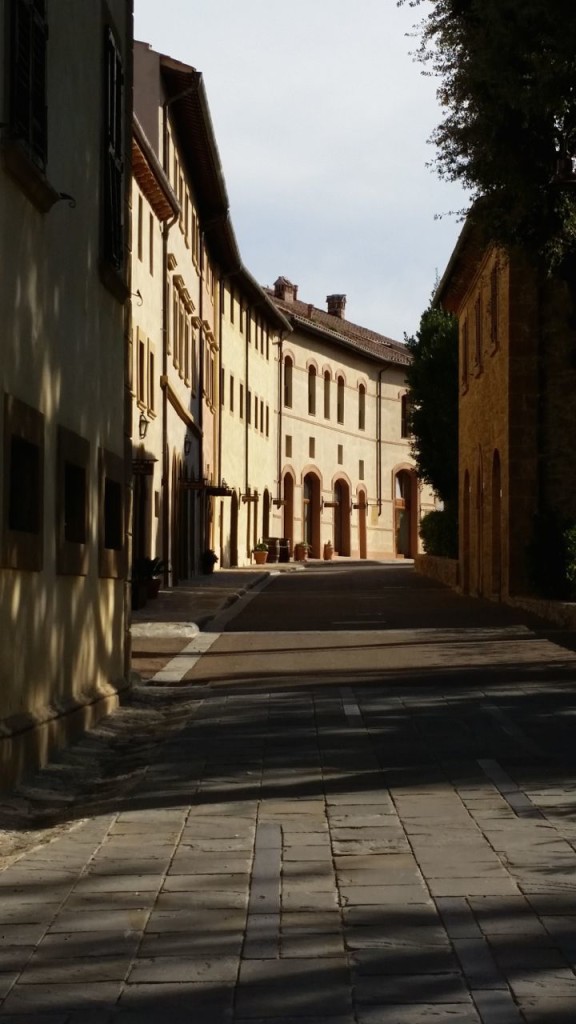
Tuscany is not like that. It really is spectacular without even trying.
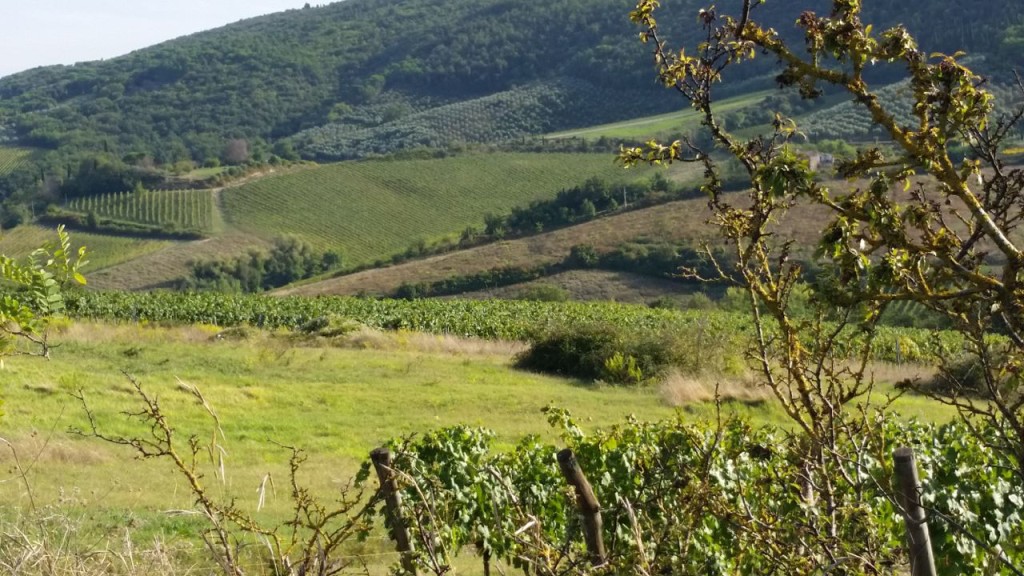
Renting a car is really the best way to see Tuscany. The various villages are spread out, and you lose a lot of time taking the bus.

The one downside of all those beautiful rolling hills and winding roads is getting carsick.
As someone who gets very motion sick, I’m glad I was prepared. I searched for years for the cure to motion sickness. Dramamine knocked me out. The wristbands didn’t work. I’ve tried everything, and then, I found the cure. Ginger candies. I use the ones called Gingins by The Ginger People. The flavors I prefer are spicy apple and the caramel one. I don’t love ginger, except in Chinese food, and these don’t have as strong of a ginger taste as others. One warning: If you buy another brand, make sure it ACTUALLY HAS GINGER IN IT. Strangely, some ginger candies contain no actual ginger. These also cure my morning sickness when I’m pregnant. I discovered it when I was pregnant with Daisy. I also ate these candies on the boat ride in Cinque Terre.
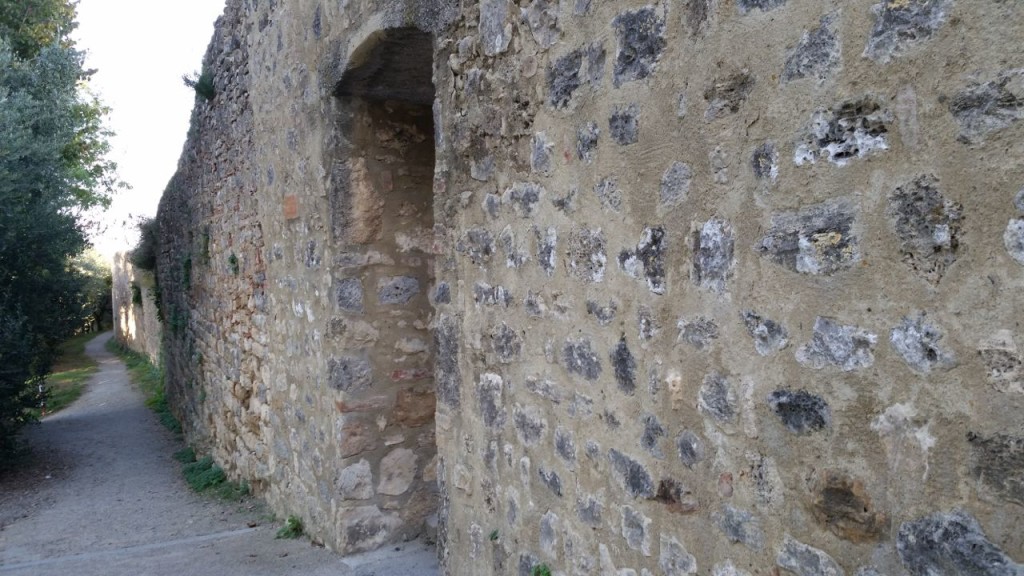
SAN GIMIGNANO
The first village we visited was San Gimignano because it was very close to where we were staying. It is known for being walled and its towers.
While in other cities most or all of their towers have been brought down due to wars, catastrophes, etc., San Gimignano has managed to conserve fourteen towers of varying heights, for which it is known internationally.
It is so amazing to think that real people live in these picturesque settings.
Even with all of its quaintness they have to make a living with tourism, and there are plenty of places to spend your money.
At this store, I bought an olive wood cutting board and spoon that I use every day in my kitchen. I love using them and thinking of my trip. It is so fun to use beautiful things to do mundane tasks. I almost bought a bread bag, but wasn’t sure it would serve my needs.
The town dates back to an Etruscan village in the third century.
Until not too long ago (in terms of European history), each hilltop city was its own little country, and they were fortified for protection. Even when they were more unified, the region of Tuscany often fought against Florence.
There is a beautiful well in one of the plazas.

Random fact: Tuscan bread is made with no salt because during its wars with Florence, they weren’t able to buy salt from them, so they just started making bread without salt. Now they continue. Bread is often served with salty meats, so they say it doesn’t matter. I say it does. The one food disappointment was the unsalted bread in Tuscany.
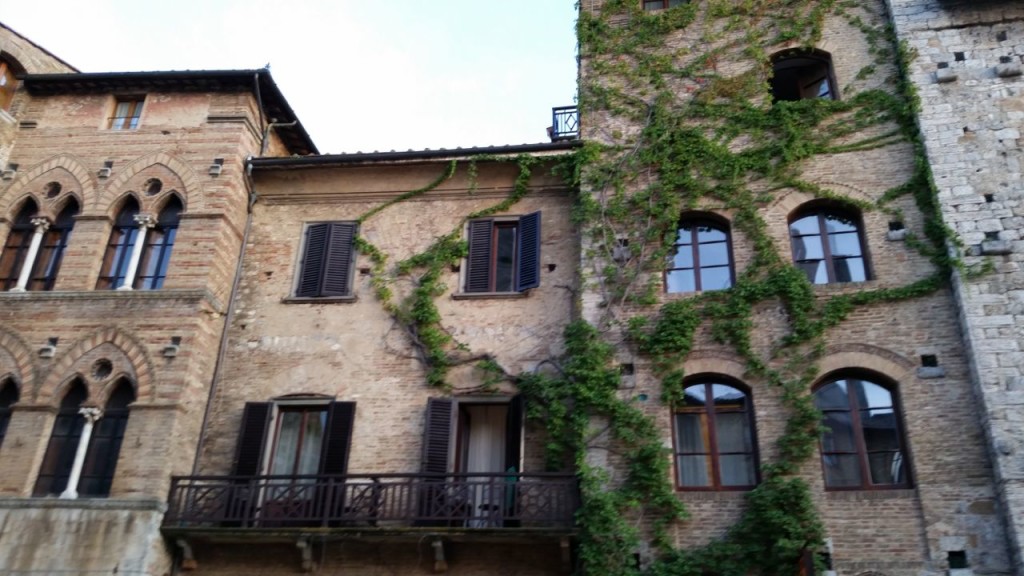
The whole town is a UNESCO World Heritage Site.
I took a picture of this adorable old lady working in her beautiful, well-kept garden. I hope that is me in 50 years.
We stayed at a fattoria agriturismo, which is a working farm that is also set up to receive tourists as guests. There are strict rules to become one. All food has to be produced onsite, down to the olive oil. You can choose to have amazing meals there each night.
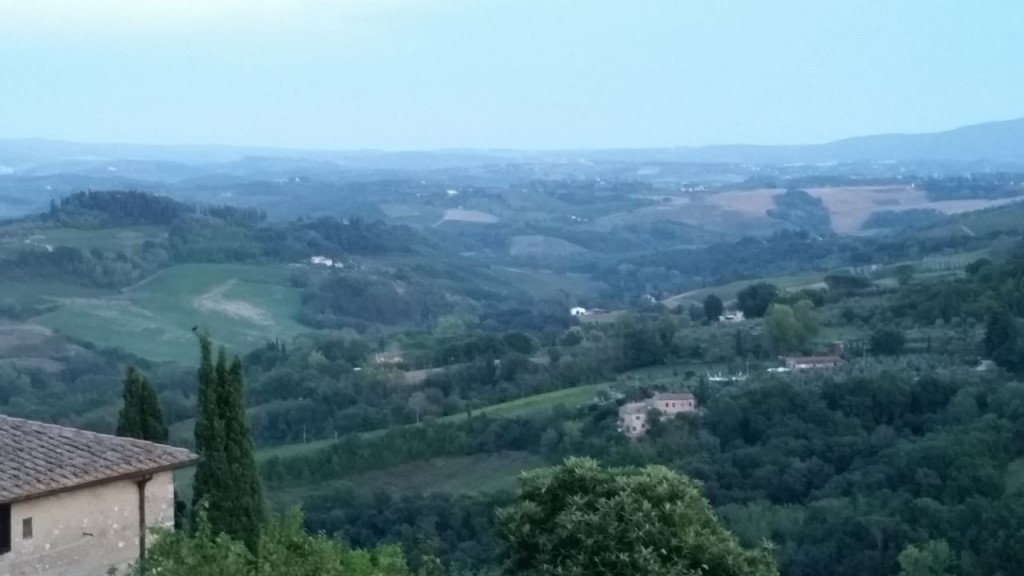
This was the view from the al fresco dining area.
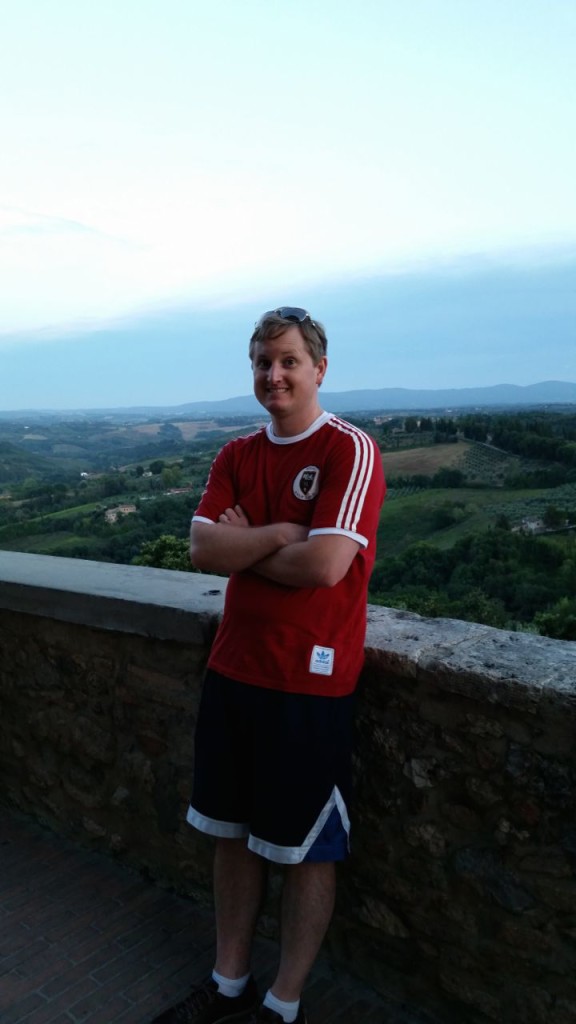
I read about this exact farm in a book I love called Animal Vegetable Miracle. We enjoyed a lot of things about it, but one thing we didn’t enjoy was the tourists. Sounds crazy right? It has ten or so rooms for guests, which is great. What is not great is the buses of tourists they bring in for wine tours.
We started our lovely meal with couples staying on the farm. The food and company were fantastic…for the first hour. Then the bus arrived and 50 people sat 2 tables over and proceeded to get completely wasted, loud, sloppy drunk. There was a woman in her 60s waving her arms over her head, shaking her butt doing the woo woo, and I was pretty sure her shirt was coming off sooner than later. We didn’t stick around to find out.
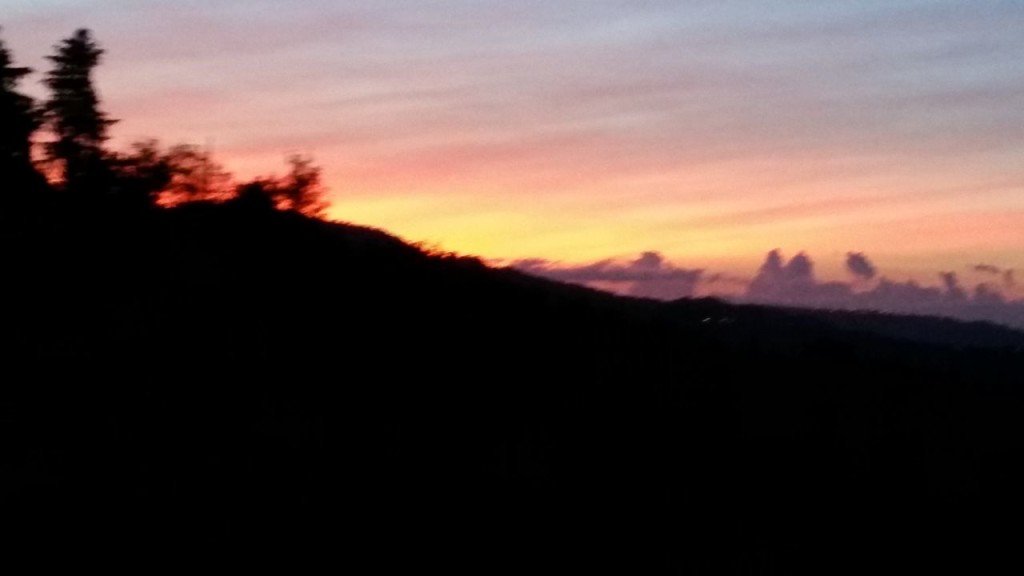
We could hear them in our room until well after midnight. Every night. Before leaving, the drunk people would buy cases of wine to ship home. Clearly the bus tours are the real money-makers here, but if I had known about that, I wouldn’t have stayed here. It really ruined the peace at lunch time and dinner time until the wee hours of the morning. After the first night we stayed gone all day and dined elsewhere, which was a shame, because their food was so good.

The view of San Gimignano from our place.
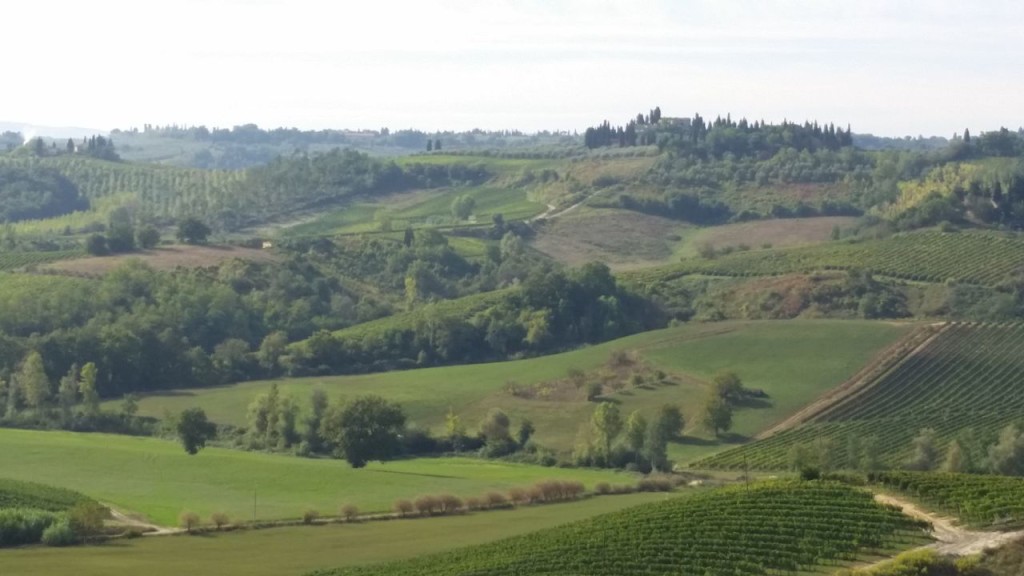
Their specialty is wild boar, which is delicious. Why is that the house special? Because wild boar like to dig up and ruin grape vines, so they hunt them to protect the vineyard. No need to be wasteful, let’s cook it for dinner. I had a wild boar pasta that was to die for.
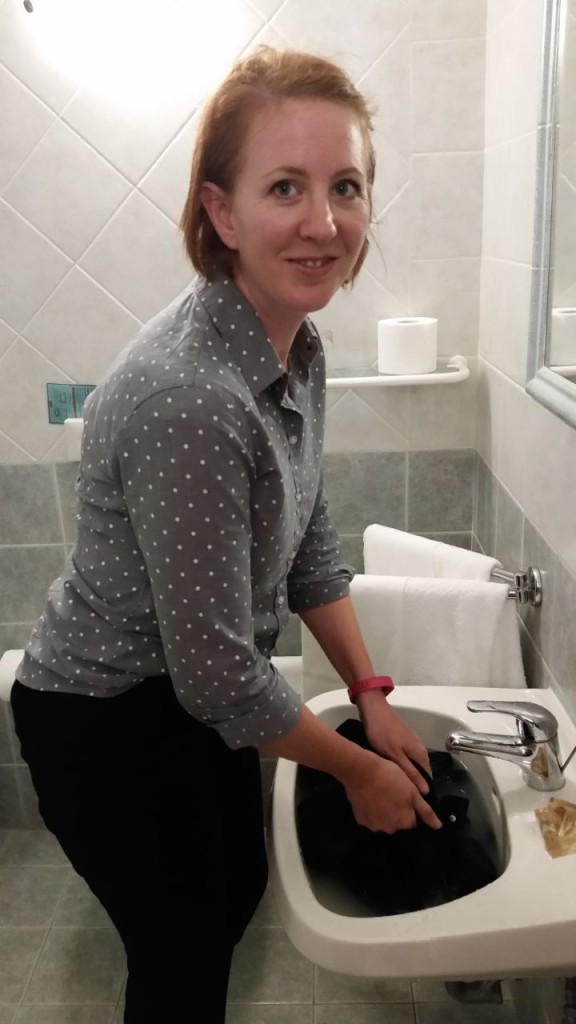
I had to put those hand-washing laundry skills I learned in Brazil to use. Adam’s jeans were sour from being rained on and then packed away during our unexpected evacuation in Cinque Terre. What you are seeing here is 3/4 of the bathroom. The rooms aren’t fancy, but they aren’t supposed to be. The shower box was literally so small I couldn’t bend over or lift my leg to shave. I could kind of squat and reach.
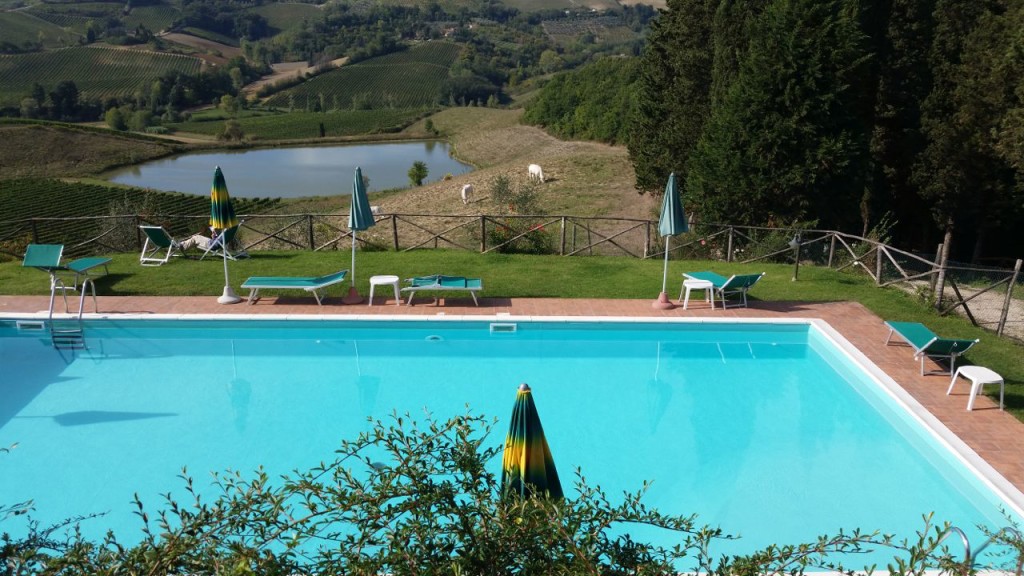
We didn’t take time to make use of the pool, but if we were Italians coming in from the city for a weekend of relaxing, I probably would.
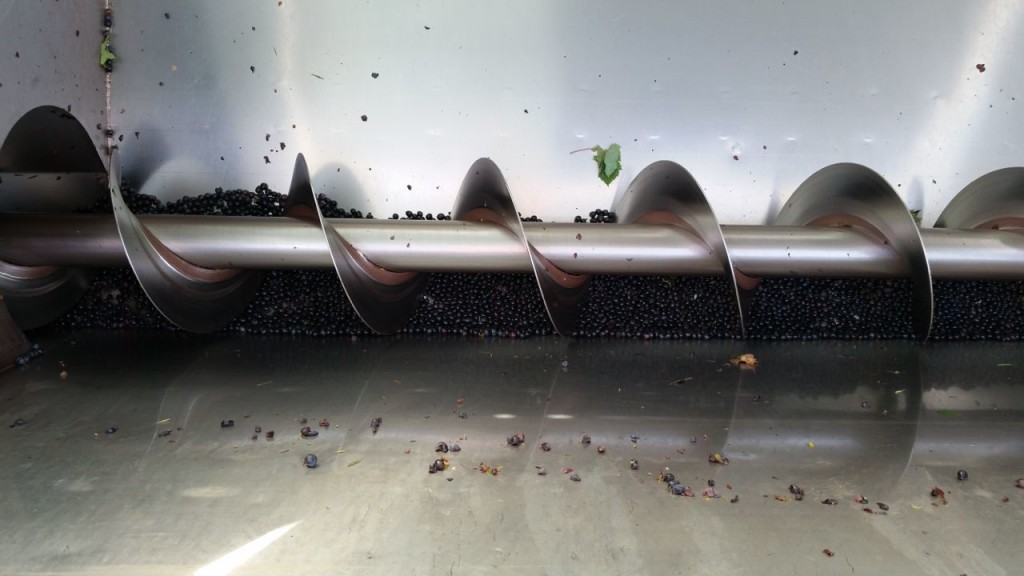
We got a tour of the farm to see the winery. They literally produce everything here.
The vineyards. They had us taste different grapes off the vine and explained the different wines they make with them. Even though I’ve never actually had wine, it was very interesting.
They also raise a breed of cows called chianina, and this is their barn.
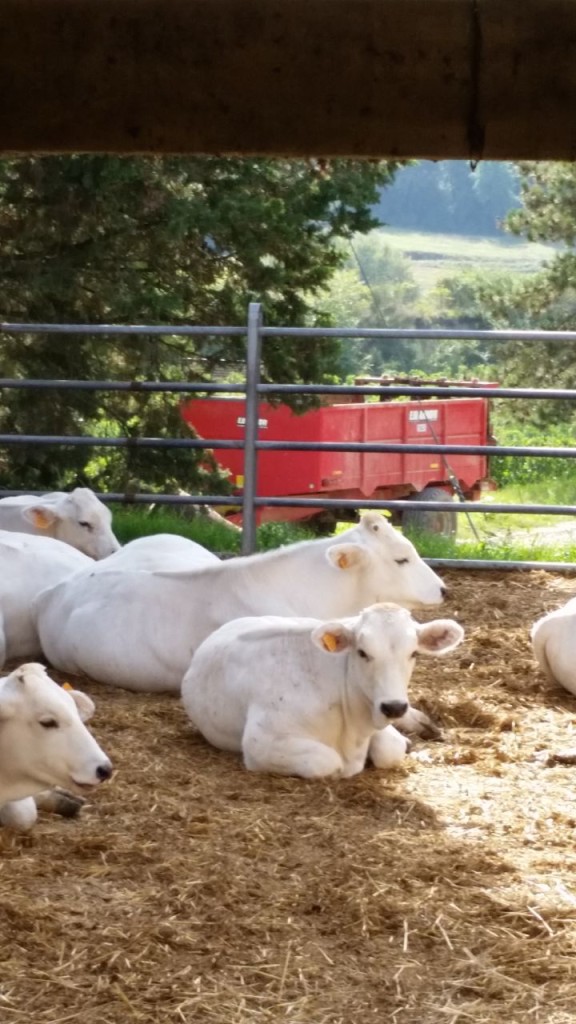
All very well cared for. They pasture most of the time.
VOLTERRA
After our tour of the farm we went to Volterra.
If you’ve read the Twilight books (and I’m ashamed to say I have, but they were A-W-F-U-L. I read all four because I had to see if it got any less bad. I can’t not finish a book), then you will recognize the name of the town as where the bad vampires come from.
We stopped for lunch, and I told Adam I needed protein in the worst way. I was over carb loaded, and it was taking a toll on my blood sugars. So he ordered me a charcuterie platter, and it was heaven. We love meat.
Volterra’s Roman Amphitheatre was built in the 1st century BC but fell into disrepair and was eventually used as a garbage dump during the middle ages (and was completely covered). The town’s defensive walls were built in the 13th century using stones from the amphitheater. This is a problem in many historical places. Why go carve new stones when that building over there isn’t being used? We’ll just use those. Archeologists found and excavated the site in the 1950’s.
You can go down into it, but we liked the view from the top the best.
People would literally walk by and toss their garbage in and it eventually got so deep that it was completely covered and forgotten. That is a lot of garbage.
Even the stones on the roads are laid out to be beautiful. I love herringbone.
It was strangely cold and windy in Volterra that afternoon, and it hadn’t been at the farm 30 minutes away. We stopped and got some hot chocolate.
It was barely drinkable because it was more the consistency of very hot pudding. We really needed a spoon to eat it instead of drink it. Any excuse for hot chocolate, right?
The entrance to the city.
Not that I wanted to show you my foot and sandal, but it was to show the size of the shell in the stone. There were fossils everywhere.
I’m guessing they got sick of tourists invading their privacy.
This monument is in remembrance of all of Volterra’s sons who were lost in the two World Wars.
I wanted to bring these flowers home with me.
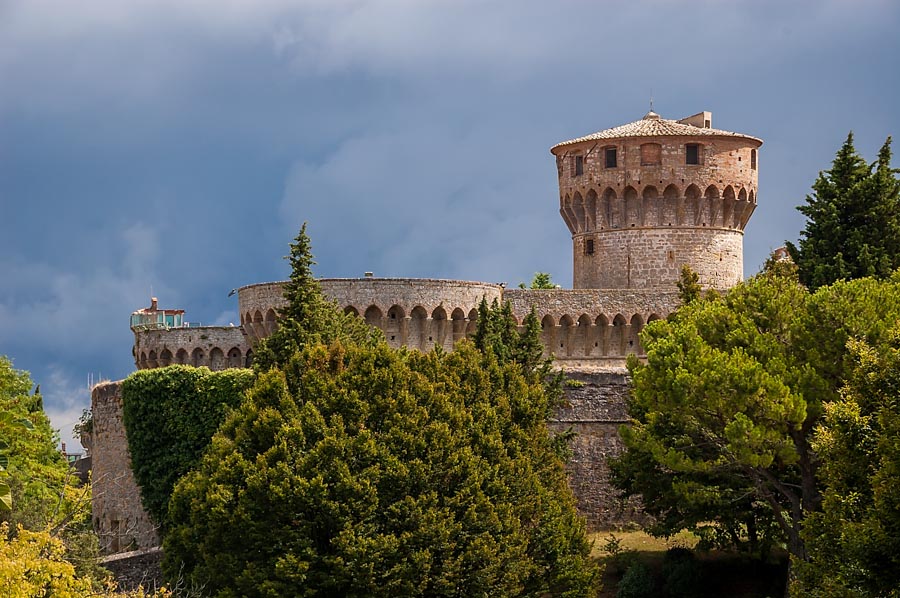
I was so confused when I saw this huge palace because it wasn’t anywhere in our guide books. Can we go in? No we cannot. It was a Medici fortress, and today is a maximum security prison. Actually you can go in. Inside is a restaurant where you are served by inmates. Your waiter killed his girlfriend and has access to knives…In order to eat there you have to pass a background check. So plan ahead. The food is supposed to be good.
CUCINA DE GIUSEPPINA
One of our favorite things we did was take a cooking class.
It ended up being just us and a German couple.
When we did introductions, the teacher asked if we were there on our honeymoon, and when I said no, with all sympathy in her heart she said, “Well, maybe he will marry you soon.” We laughed hard at that one. When we told her we’d been married 11 years and had 6 kids, they were floored.
We started out making dessert. She kept saying we were going to eat chocolate salami, and while we are both foodies and very adventurous eaters, that sounded just gross. It turned out to be a dessert of crushed cookies, chocolate, etc. that was rolled and shaped like a salami. It was supposed to have rum in it, but since we don’t drink we used juice. Oddly, the German couple didn’t drink either.
We made pork loin.
I might need one of these knives.
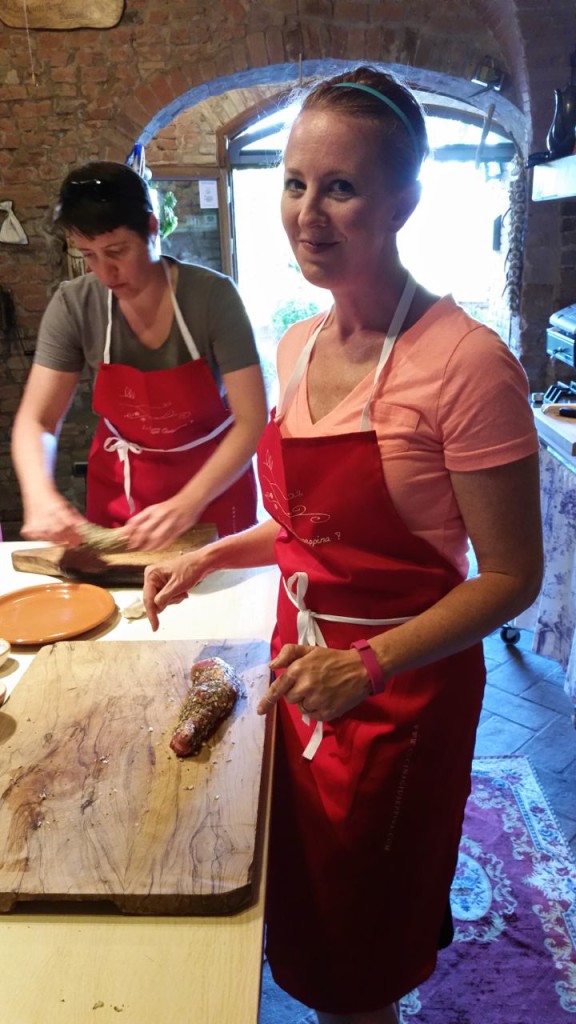
It was garlic and rosemary crusted pork loin.
Then we started on the appetizer so the dessert and meat could chill.
The bruschetta had canellini beans, which normally I would not like (I’ve never loved beans, but after eating them twice a day every day for 1.5 years in Brazil, I really don’t care for them). It was fantastic.
We learned a lot of interesting tips.
I loved her kitchen. Look at that adorable sink skirt.
I know how to use a knife. I’ve got mad knife skills.
Our appetizer. It was incredible. That was an onion marmalade she canned.
She had a little sitting area in front to enjoy our juice (would have been wine for others) and bruschetta and (real) salami.
It was so romantic and fun.
THEN we made fresh pasta.
And a delicious sauce. I knew coming in September was a good idea. Look at those tomatoes!
Best tip: put the garlic and olive oil in a cold pan and let it cook slowly so it doesn’t burn.
Then add the other ingredients to cool the pan down.
We made fettucini! It was incredible.
After we boiled it al dente, we added it to the sauce
And served it with the pork medallions.
We ate the entire chocolate salami. It was so good.
Who wouldn’t want to cook in that kitchen? It was gorgeous. I highly recommend a cooking class with Giuseppina. It was one of the best parts of the trip.
MONTERIGGIONI
The next morning we went to Monteriggioni, another walled, Tuscan town set on a hill.
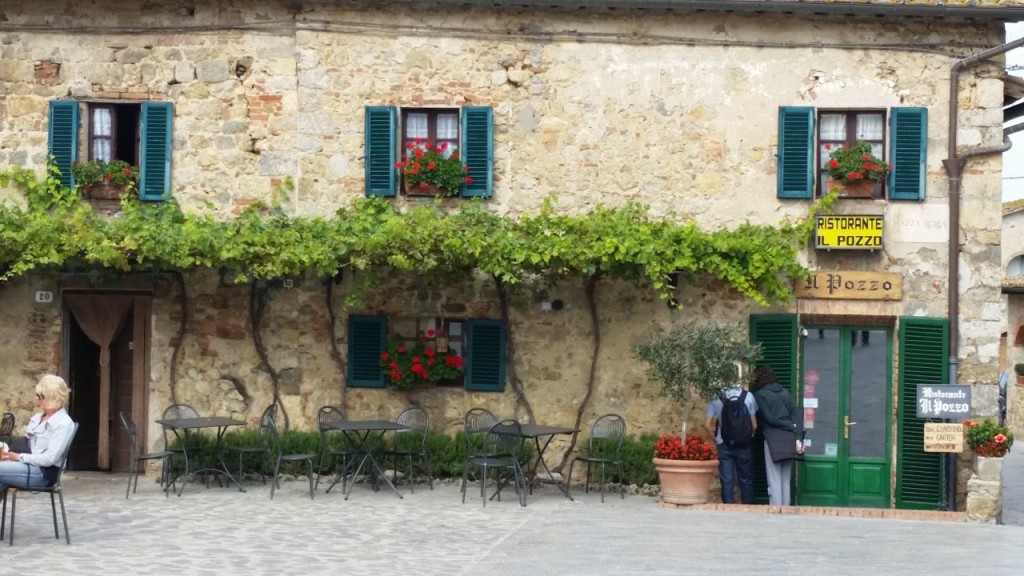
That cafe is so cute I would’ve eaten second breakfast there, but it wasn’t open yet.
It was still windy, chilly and overcast.
In Monteriggioni you can go up on the wall and walk the perimeter.
This is where guards would have kept watch for enemies or defended the town.
Perfect fit. We’ll take it. Adam is my knight in shining armor, after all.
SAN GALGANO
Our next stop was a ruined cathedral called the Abbey of San Galgano. The impoverished and decaying abbey sputtered along for nearly four centuries. In 1786, the campanile fell, taking with it the roof of the church. The ruins were looted for building material.
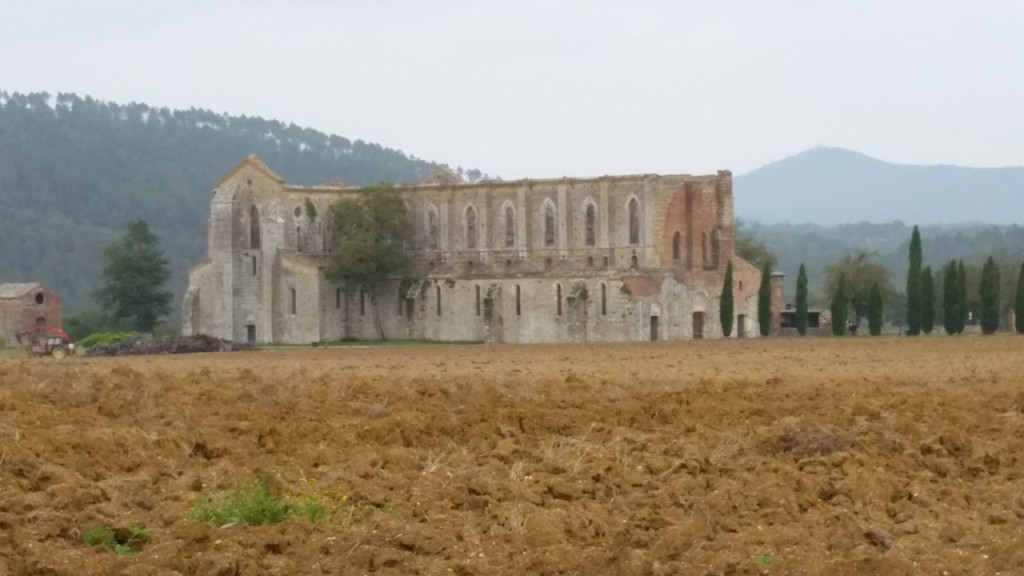
Besides being really beautiful, the abbey is famous for something else. The sword of St Galgano, said to have been plunged into a rock by a medieval Tuscan knight. Galgano Guidotti, a noble from Chiusdano, near Siena, allegedly split the stone with his sword in 1180 after renouncing war to become a hermit. For centuries the sword was assumed to be a fake, but research has dated its metal to the twelfth century.
Only the hilt, wooden grip and a few inches of the 3ft blade poke from the hill, which still draws pilgrims and tourists to the ruins of the chapel built around it.
The nearby chapel or Eremo or Rotonda de Montesiepi (1185) guards the tomb of Saint Galgano and the site of his death in 1181, his legendary sword in a stone
There are two mummified hands in the same chapel at Montesiepi. Legend has it that anyone who tried to remove the sword had their arms ripped out. In English legend the sword Excalibur is pulled from a stone by the future King Arthur, heralding his glory. In Galgano’s case the miracle signified humility and holiness.
The son of an illiterate feudal lord, Galgano had a reputation for arrogance and selfishness. After a vision of the Archangel Michael, however, he retired to a cave to become a hermit. Lured out by his family he was thrown by his horse while passing Montesiepi, a hill near Chiusdano, where another vision told him to renounce material things. Galgano objected that that would be as difficult as splitting a rock and to prove his point he struck one with his sword. The rock, it is said, yielded like butter.
If you want to see the tomb, you have to pay ,50 euro to turn on the lights for two minutes.
The abbey is really beautiful.
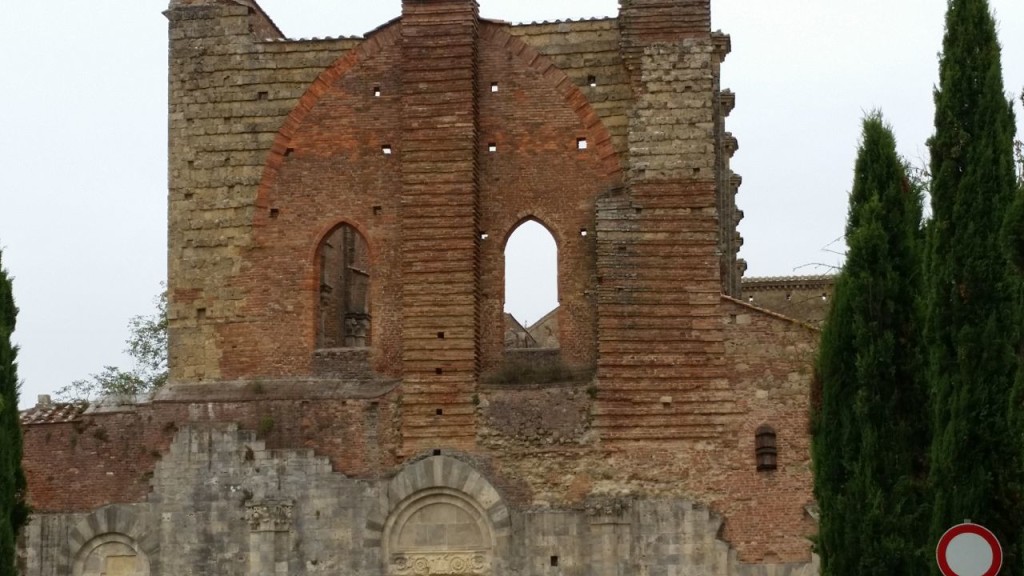
I think it is more beautiful than the ornate, intact duomos.
We were famished, and across the street is this random restaurant in the middle of nowhere. The food was actually really good. The place wasn’t fancy, and there were families and road workers having lunch, but it was better than the gross stuff at Italian places in the US like Olive Garden (gag). Their normal is just so much better than ours.
According to these boxes, spaghetti is a diet food. Eat up, the kilos will melt off.
CASTLE FROSINI
After that we drove around to see what we could see. From the road I had seen this magnificent structure covered in gorgeous ivy? tree?, and on our way back, I wanted to stop and investigate.
It was a quiet little village. Actually, smaller than a village.
Large estate with some surrounding cottages and common areas? It is referred to as a hamlet, and there are 45 residents.
A memorial to those lost in war.
I absolutely love this well with flowers coming out of it.
Even the garage is beautiful with this tree? growing on it.
I need a fake well in my yard to plant flowers in.
This is the manor I saw from the road. It is the Castle of Frosini. Built as early as the 11th century, it was owned by the Counts of Gherardesca and played a very important role because of its strategic location on the road leading from Siena to Massetana. At one pointed it was in the possession of the Knights Templars who had used their mansion, the “Mansio de Fruosina Temples”, as a shelter for travelers and pilgrims.
Most of the windows were shuttered. Maybe it’s a vacation home? Or Boo Radley might live there. It is now privately owned.
It comes complete with its own bell tower.
Everything here was perfectly imperfect, making it perfect.
We didn’t see a single soul while we were poking around, but someone is watering these flowers, so somebody must live here.
Even the weeds on the veranda and stairs were perfect.
Every turn was breathtaking. I want to move in today.
I wanted to snoop so much more, knock on the door and ask to use the bathroom so I could sneak a peek, but I didn’t.
MONTARRENTI CASTLE
The next thing we stumbled upon was another castle called Montarrenti. We walked up the very long, steep driveway and found a group of African illegals living there. Squatting, actually. And they didn’t appreciate our presence.
After scrutinizing us for a moment, they gave us permission to view the grounds. This is a state owned public monument, not your private residence. I’m not the intruder.
Castle Montarrenti was built between the second half of the 7th and the first half of the 8th century as a village of huts encircled by two timber palisades to defend it.
Documents of the years 1200-1216 indicate strong family ties between the powerful Lords of Frosini, descending from Della Gherardesca Counts, and the Lombards nobles residing in Montarrenti and connected with the Aldobrandeschi family.
By 1720 Montarrenti was already in ruins: the walls of the village’s houses were collapsed. The two main towers were occupied by the last inhabitants, but in the Church of Santa Maria the Holy Mass was no longer officiated.
As beautiful as this castle was, I was very unnerved by our encounter. Those boys did not appreciate our intrusion. Because of their situation, they could easily have viewed us as a threat and acted differently. The castle is very isolated, no one would have known. I don’t know what it was, but my internal alarm was screaming. I was glad to leave.
TORRI
The next stop was another real-life, no tourists around village where actual people live.
The ancient village of Torri. The area was inhabited by the Etruscans, Celts, and Romans until the Middle Ages when major development of the village started.
There is an abbey there, but it was closed. The time of its foundation is not known exactly, but its first mentionings can be traced back to an edict issued by the Pope dated January 13,1069.
It felt like a ghost town because there wasn’t a soul around. We whispered the whole time so as not to disturb…nobody.
How perfect is everything?

If you want that genuine Tuscan village experience, go here. No shops and restaurants and vendors and postcards.
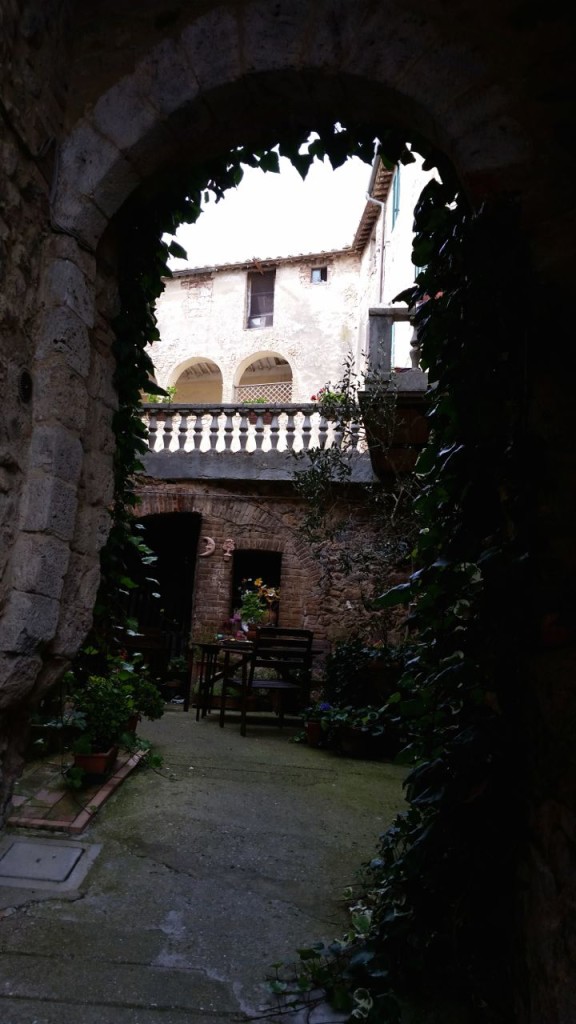
Just a sweet little al fresco dining area for the family who lives here.
I wanted to take those doors and bricks and ivy home with me.
This guy is the only person I saw there. I did take him home with me.
The history just oozes from the walls.
SIENA
After our meanderings we made our way to Siena, the heart of Tuscany.
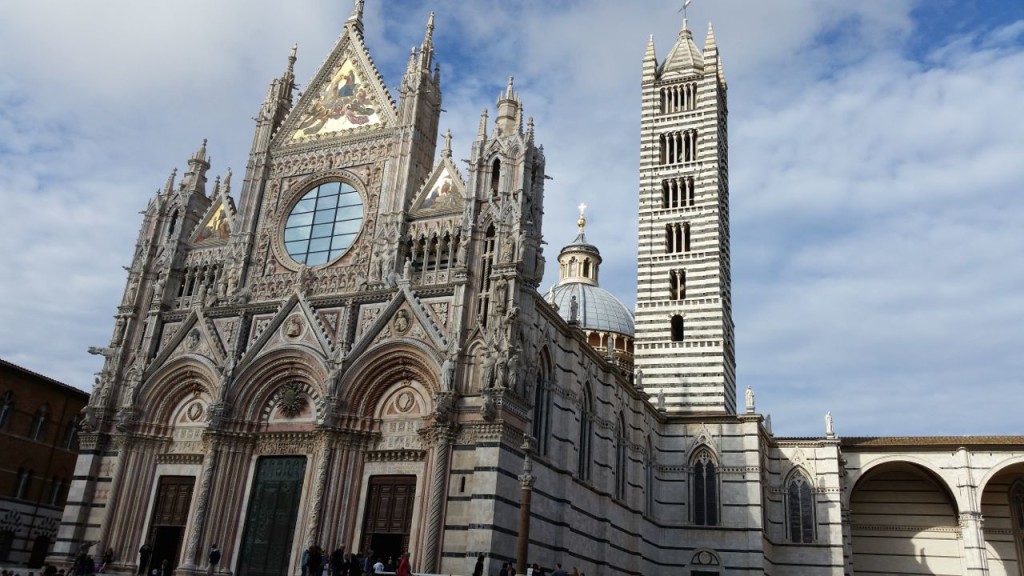
The duomo. Every town has one.
I’ll be honest, as breathtaking as the duomos are, you reach a point very quickly that you are tired of seeing yet another duomo which has this one special thing that makes it different than all the other duomos, but you can’t for the life of you remember what made the last 17 so special, and this one looks suspiciously exactly like…all of them. By the time we got to Florence, we stopped going in.
This is the Fonte Gaia in the Piazza del Campo.
Remus and Romulus nursing from a wolf.
Of course the Piazza del Campo has a tower, and you can climb it! So we did.
The steps were really tall in the Torre de Mangia
If climbing 400 steps proves to be too much, you can call for help. We made it up without stopping because that’s how we roll.
The tower was built to be exactly the same height as the Siena Cathedral as a sign that the church and the state had equal amounts of power.
The piazza down below is known for its seashell shape. They used to have horse races in it.
The other way down.
Even the parking lots in Tuscany are beautiful.
Can you believe that whole huge vine grows in this little pot? I wonder who waters it. I wonder things like that because I’m a gardening nerd, and I just happen to know pots like that don’t water themselves.
As we wandered past again, we decided to go in this one. The stripes strike me as very egyptian.
Doesn’t that look like a bunch of Egyptian headdresses?
This ceiling was pretty spectacular.
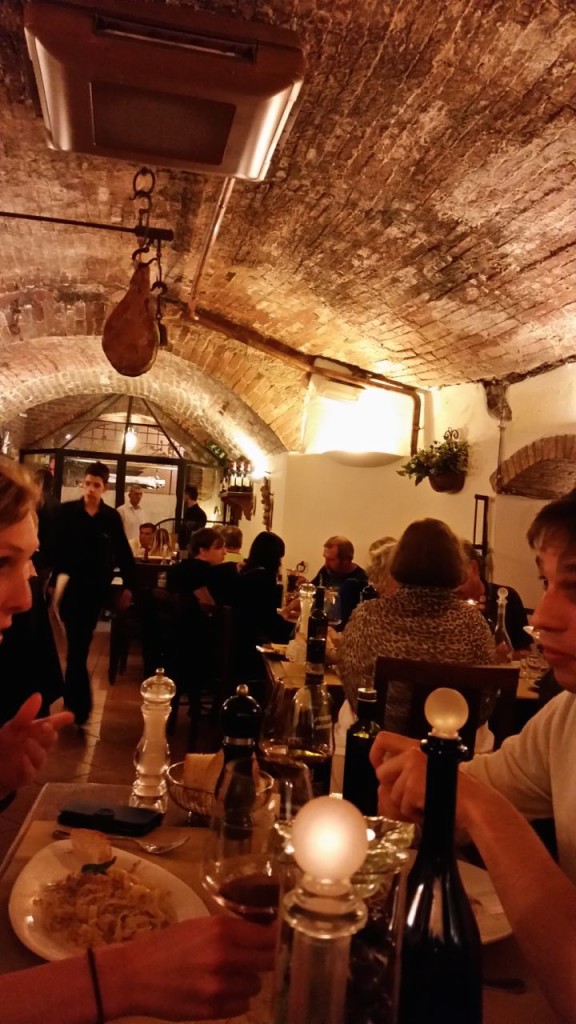
Then we got hungry, and looked up restaurants in Siena. We read about Taverna di San Giuseppe and made our way over there, but it wasn’t open yet. It doesn’t open for dinner until 7! So we walked around and came back at 7 to find out they were booked for the night. Reservations highly recommended, folks.
After pleading and looking desperate, yet friendly, the hostess told us there was a 7:15 reservation that hadn’t showed, and if they didn’t come by 7:30, we could have their table. At 7:30:01 we were back at her stand and she led us to our table, menus in hand.

See that cellar? The owner didn’t know it was there when he bought the place. They were renovating and accidentally knocked a hole and discovered that room! How amazing!
The food was amazing. Fig and prosciutto crostini
The tenderest, most delicious gnocchi I have ever had. Good gnocchi shouldn’t go down like lead balls. It should be light.
Fig-stuffed pork loin. I die. I have a serious, serious thing for figs.
Chocolate lava cake.
Cheesecake for me.
I loved Tuscany. I want to move to Tuscany. It is hard to pick one spot, but I think this was my favorite part of Italy. Our last day there was our favorite day in Tuscany because of our discoveries and because it was relaxed. It felt more like an adventure with no itinerary to follow. It was fun to wander and discover some hidden gems. Don’t get me wrong, we are hardcore planners for our trips so we don’t miss anything, but since we had seen the things we had come to see, it was nice to detour and see other things too.
The next morning we were up and on our way to our final destination: Rome.
